Over the last decade, we’ve had the pleasure of watching the overland market grow from an isolated khaki-clad niche into the thriving industry it is today. For the most part, its trends have gained popularity over time, rising in a slow and steady ascent from obscurity into acceptance at places like REI and Outdoor Retailer. Yet, one category of products surpassed the usual arc of success, soaring to acclaim like a Saturn V rocket on full burn. I’m talking about wedge campers. Over the past few years, the popularity of these lightweight camper shells has surged to such an extent that while new manufacturers seem to be appearing every month, supply still cannot keep up with demand. This shortage has only fueled the craze further, leading buyers to create a secondary market offering up to $2,000 just for someone else’s spot in line. With so much interest, we knew it was only a matter of time before people began to wonder which of these campers was the best, so we pitted five of the most popular wedge campers on the market against one another in a test of quality, durability, and comfort.
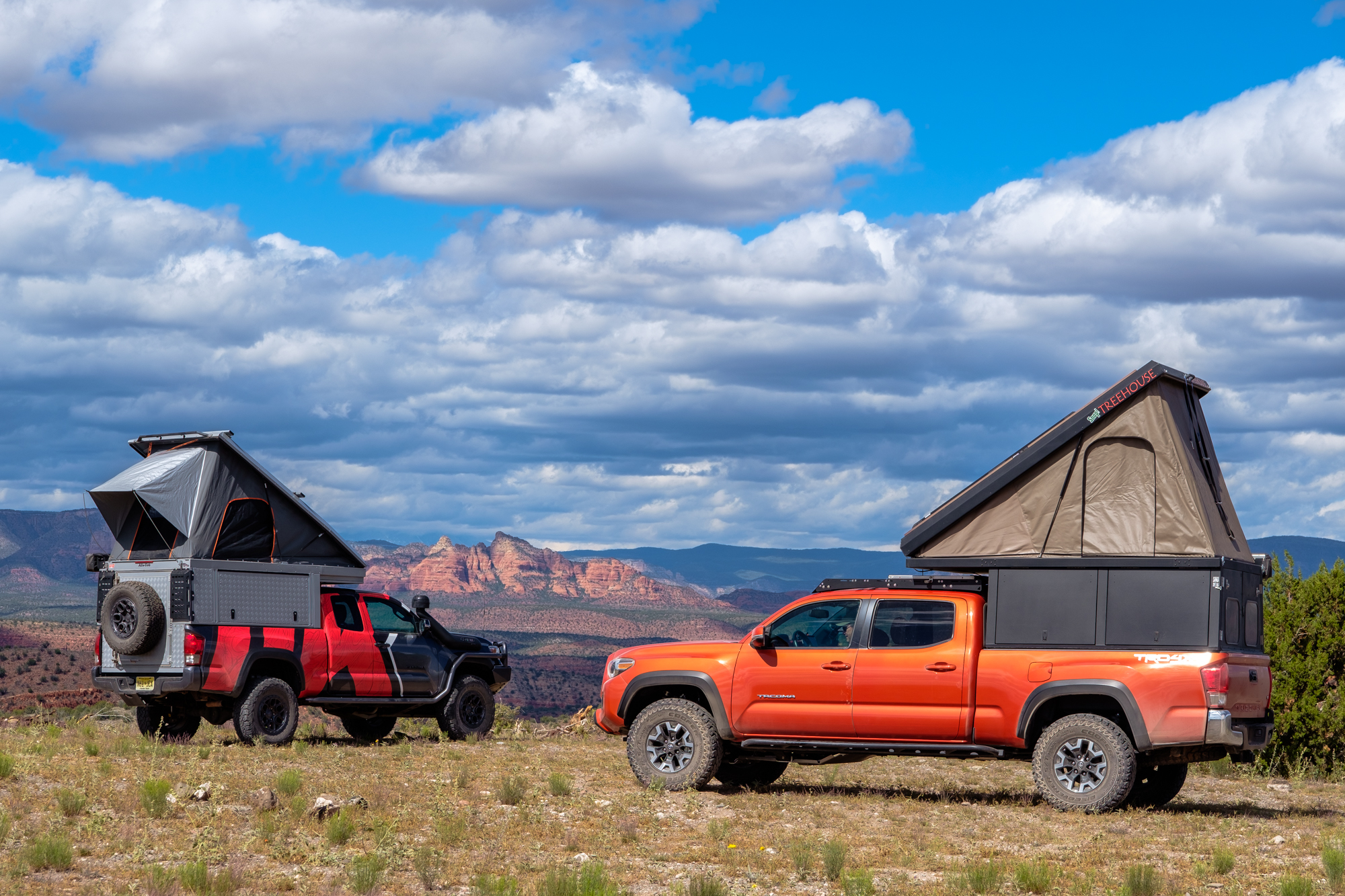
What to Consider Before Purchase
Wedge-style camper shells offer consumers an ideal middle ground between the price and comfort of a hard-shell rooftop tent and those of a full-blown slide-in camper. They keep the contents of your bed dry, (mostly) dust free, and secure, while also providing a comfortable living space in which to relax away from the elements. They circumvent the challenges posed by towing a trailer, while still providing owners the convenience of leaving their camp gear loaded and ready to go at a moments notice. With so many advantages, it’s easy to understand why people are jumping on the wedge camper bandwagon. But before you place an order, be sure to think about the following factors carefully.
Intended Use
One of the most difficult aspects of purchasing a product is being honest with ourselves about the way we intend to use it; it’s also the most important. It might be tempting to buy the specialized expedition camper designed for living full time on the road, but if we’re only going to be taking weekend trips with the occasional weeklong jaunt thrown in, it might not be the best option. A lighter and less complex camper might save you money while providing greater flexibility to use your vehicle for other tasks. However, if you do plan to travel around the world, you’re going to want to purchase the product designed for it.
Region and Season
The region of the world and seasons you plan to use the camper in should factor into your decision as well. Some products, like the AT Overland Summit, are equipped with arctic insulation packs making them ideal for winter camping at the base of the ski-slope, while others simply use standard tent fabrics and rely on your sleeping bag for warmth. There are advantages to each style, but you must decide which is right for you.

Durability
Another factor to consider is the durability required by your driving style. I feel confident saying that every camper we tested can stand up to the basic rigors of overland travel, yet some are designed to withstand far more than that. The Go Fast Camper, for example, is engineered to withstand the abuse of an off-road race truck and has emerged unscathed from impacts so large they shifted both the axle and the bed on a Ford Raptor. The Snap Outfitters camper, on the other hand, is strong enough for normal dirt road travel, but would not likely endure larger impact events.
Safety and Quality
More important than durability is safety and quality. Frequently, when a category like wedge campers explodes in popularity, fringe manufacturers and homebuilders hop on the train to start producing products without putting forth the research or effort required to create a high-quality product. This attitude might lead to one or two good campers, but more often than not, you end up with a slew of letdown customers with broken or unsafe purchases. With the trailer boom, we saw suspension failures and tongues that snapped due to metal fatigue. In roof tents, there were plenty of leaks, broken ladders, and cracked bases. The same issues will almost certainly be present in the wedge market soon. We always do our best to ask the hard questions on product safety, but it’s vital that readers look over any camper they’re considering carefully.
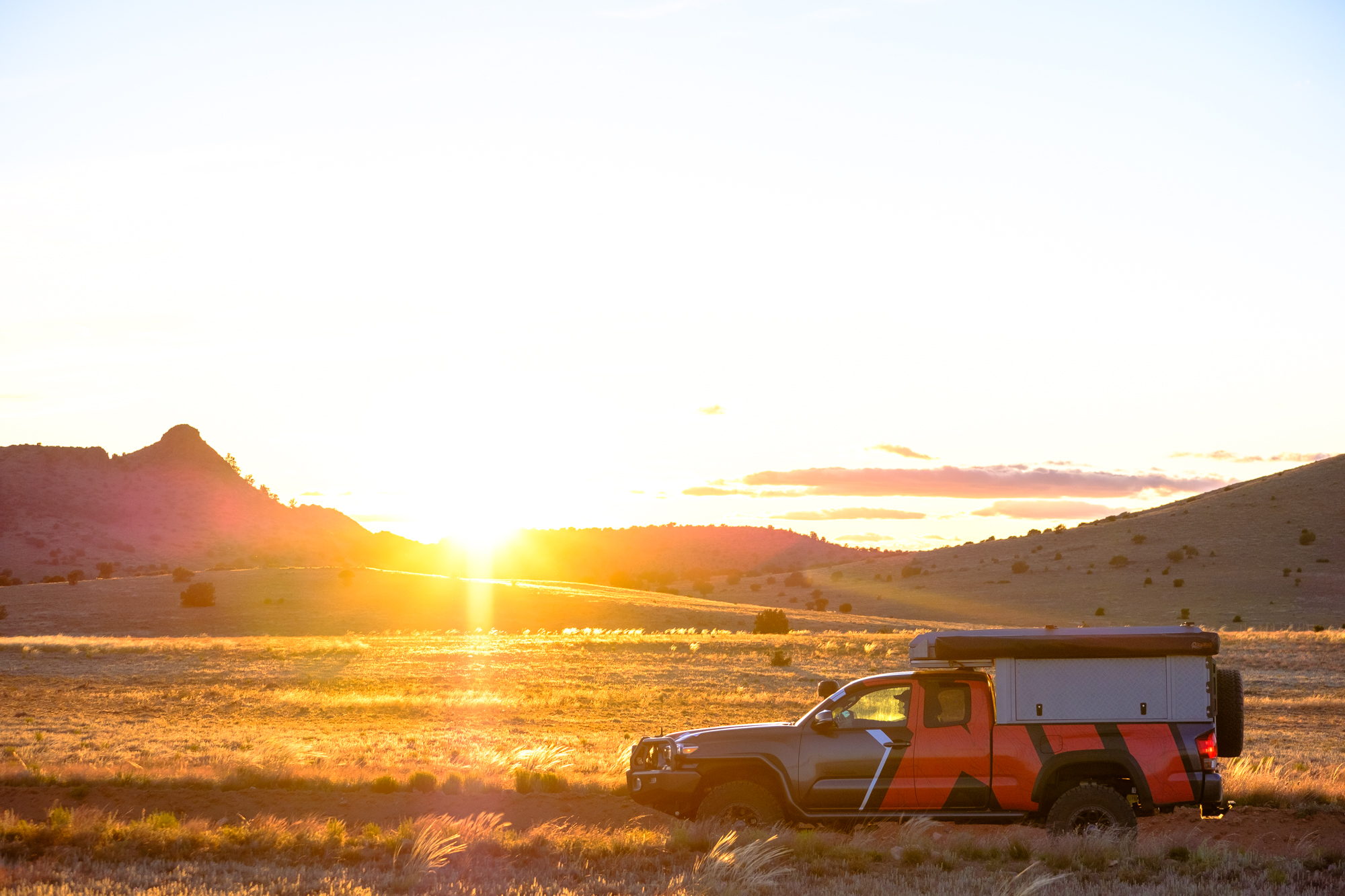
Weight
Although some people like to treat their truck’s gross vehicle weight rating (GVWR) like an irrelevant theoretical number, it really does matter. A vehicle exceeding its weight restrictions will break components more often, handle poorly, and have a higher risk of getting into an accident when compared to an identical vehicle with less weight. It’s in your best interest to choose a camper well matched to your vehicle’s capacity. You’ll find that some products in this test weigh as little as 275 pounds, while others weigh over 450 pounds. That may not sound like a big difference, but when you’re driving a third-gen Tacoma, 450 pounds is more than 40 percent of your payload, while 275 pounds is only 25 percent.
Budget
The reality is that most of us are working on a budget, and any of these campers are going to be a big spend. With that in mind, you’ll want to balance your budget with all of the factors above to ensure you’re not just getting a camper you can afford, but one that you’ll also love. Be sure to pay close attention not only to the base price but the prices when equipped with various options. Sometimes the camper that looks affordable to start can end up being more expensive in the end.
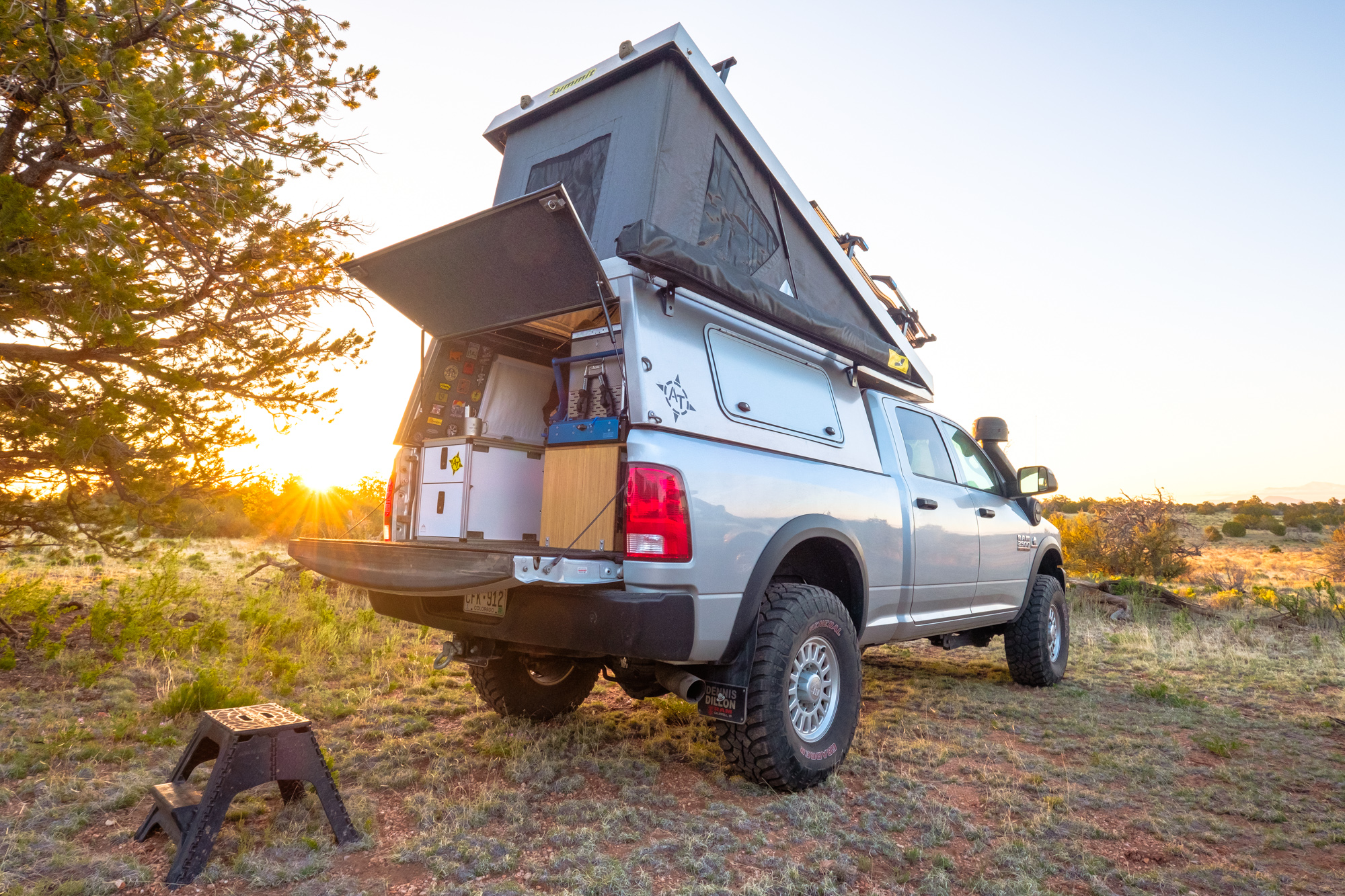
An Important Note On Tent Materials and Fire Retardant Standards
Every time we do one of these extensive tests, I find myself wandering down the rabbit hole of some theory, regulation, or production method, and this gear review was no exception. For wedge campers, it ended up being fire-retardant (FR) fabrics, and there are some things you should know.
When it comes to FR ratings, the fabrics themselves are generally not flame retardant, but rather the chemicals that they are soaked or coated in are. These chemicals and the burn rates are governed by CPAI-84, which was a standard set in place 43 years ago and intended to regulate the fire resistance of circus tents. As you may have guessed, the tents we use today are a far cry from those developed in the ’70s, which is why a recent joint study from Duke University, REI, and several leading tent manufacturers decided to take a closer look at the impact of FR chemicals and fabrics we’re using today and their correlation to this aging standard. What they found were chemicals such as tris(1,3-dichloropropyl-2) phosphate (TDCPP), decabromodiphenyl ether (BDE-209), triphenyl phosphate, and tetrabromobisphenol-A were being used, organophosphates which can be found in a range of products from flame retardants to pesticides, plasticizers, and nerve gases. This raised some concerns, especially when it became clear that many of these chemicals were applied in unstandardized and varying amounts, with concentrations reaching levels as high as 37.5 mg/g or 3.8 percent by weight of the fabric sampled.
Further tests revealed that these chemicals didn’t stay in the tents either. After people handled the fabric, analyses of their hands showed a strong residual level of TDCPP indicating it transferred from the tent. This could also correlate to a possible risk of inhalation and dermal sorption from the air, however, these subjects weren’t covered in this initial test. Since the release of these results, many companies like REI have made efforts to change or limit the use of these chemicals in their tents, while others like Mountain Hardware and Fjällräven have eliminated them entirely.
Some of the campers we evaluated below use flame-retardant fabrics, while others avoid them altogether, citing this test. Each varies on their reasoning, with some focused purely on keeping occupants safe from fires, while others are attempting to keep chemicals away from their employees and customers. With so many variables involved, we decided to let customers make their own judgments on where they stand with this matter, but have included the FR information for each camper as it was provided to us below. Remember that while trends may be favoring the removal of FR in ground tents, those ground tents do not have fuel tanks beneath them, or propane heaters inside of them.
Alu-Cab Canopy Camper
- The fabric is 400-gram, UV-resistant, rib-lock canvas treated with fireproofing that meets the EU Restriction of Hazardous Substances (RoHS) standards and is “harmless to humans and the environment.”
AT Overland Summit
- A durable, fire-retardant canvas tent with an optional fire-retardant, light-blocking, Thinsulate liner. It meets the Federal Motor Vehicle Safety Standard No. 302 for flammability, CPAI-84, California State Fire Marshall Title 19, NFPA 701, test method II, FAA 25.853 and UFAC Upholstered Furniture Class 1.
Go Fast Campers (GFC)
- The fabric is 600D polyester with PU coating. GFC notes that they intentionally chose a non-FR tent for the health of their employees and their customers.
Snap Outfitters Treehouse
- This tent utilizes a HarborTime Edge coated polyester marine fabric. Snap notes it is not flame retardant.
Vagabond Outdoors Drifter and Nomad
- These tents feature 18-ounce, vinyl-coated polyester which meets ASTM E 84 flame-spread requirements as outlined in NFPA 1192 (National Fire Protection Association, Standards for Recreational Vehicles) as well as NFPA 701 and CPAI-84.

Testing Procedures
Our testing procedures are intentionally standardized, with specific conditions and repeatable criteria. Unfortunately, this wasn’t possible to the same degree with wedge campers. Due to their limited availability and high demand, we were forced to use campers already installed on customer or manufacturer vehicles, which ranged from Tacomas to RAMs to Ford Raptors. They were located in different parts of the country in all sorts of weather conditions, which eliminated our control of environmental and test platform variables. With this in mind, we removed many of the objective criteria from the test and focused on real-world use, customer feedback, and a range of other factors.

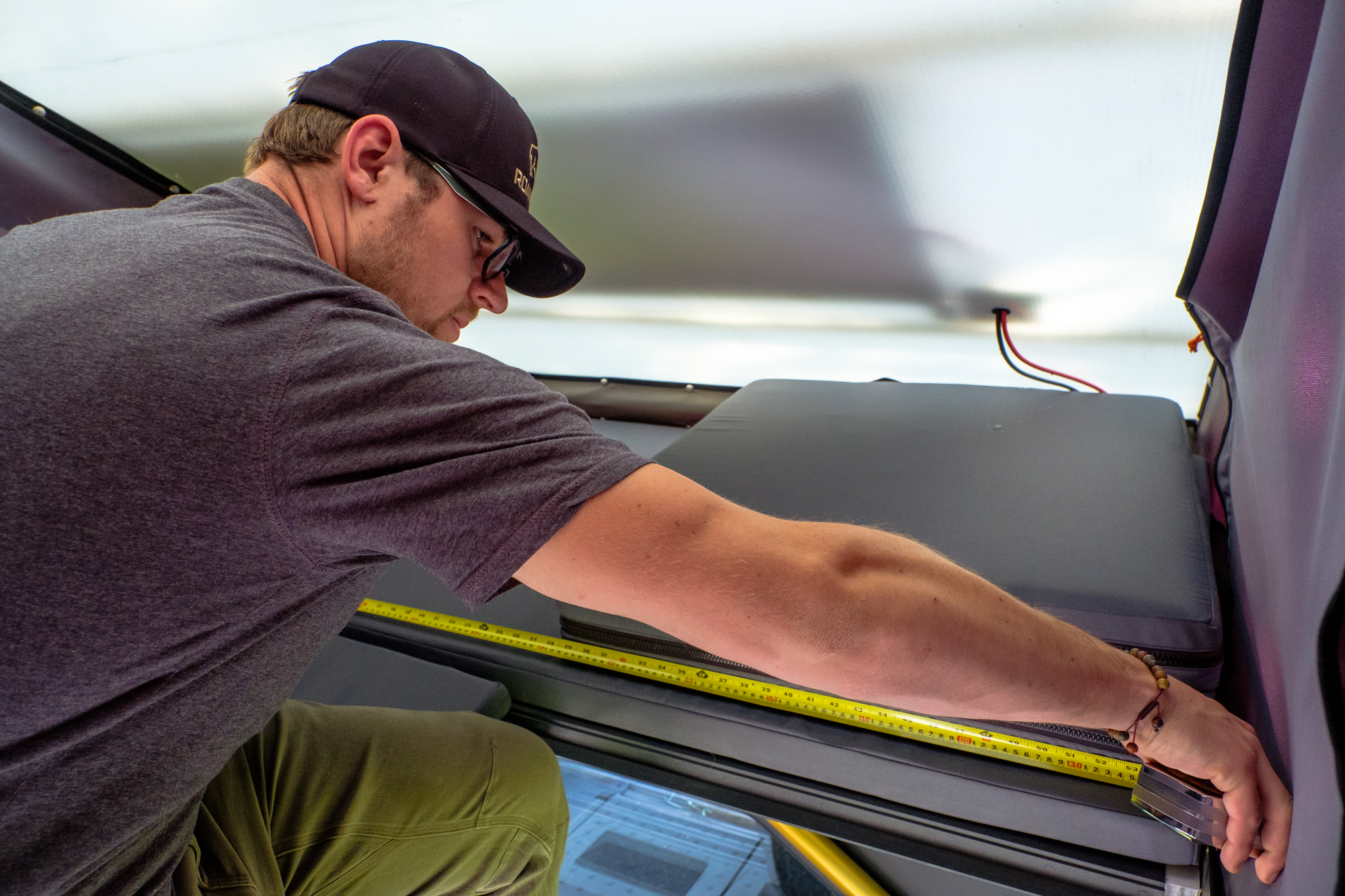
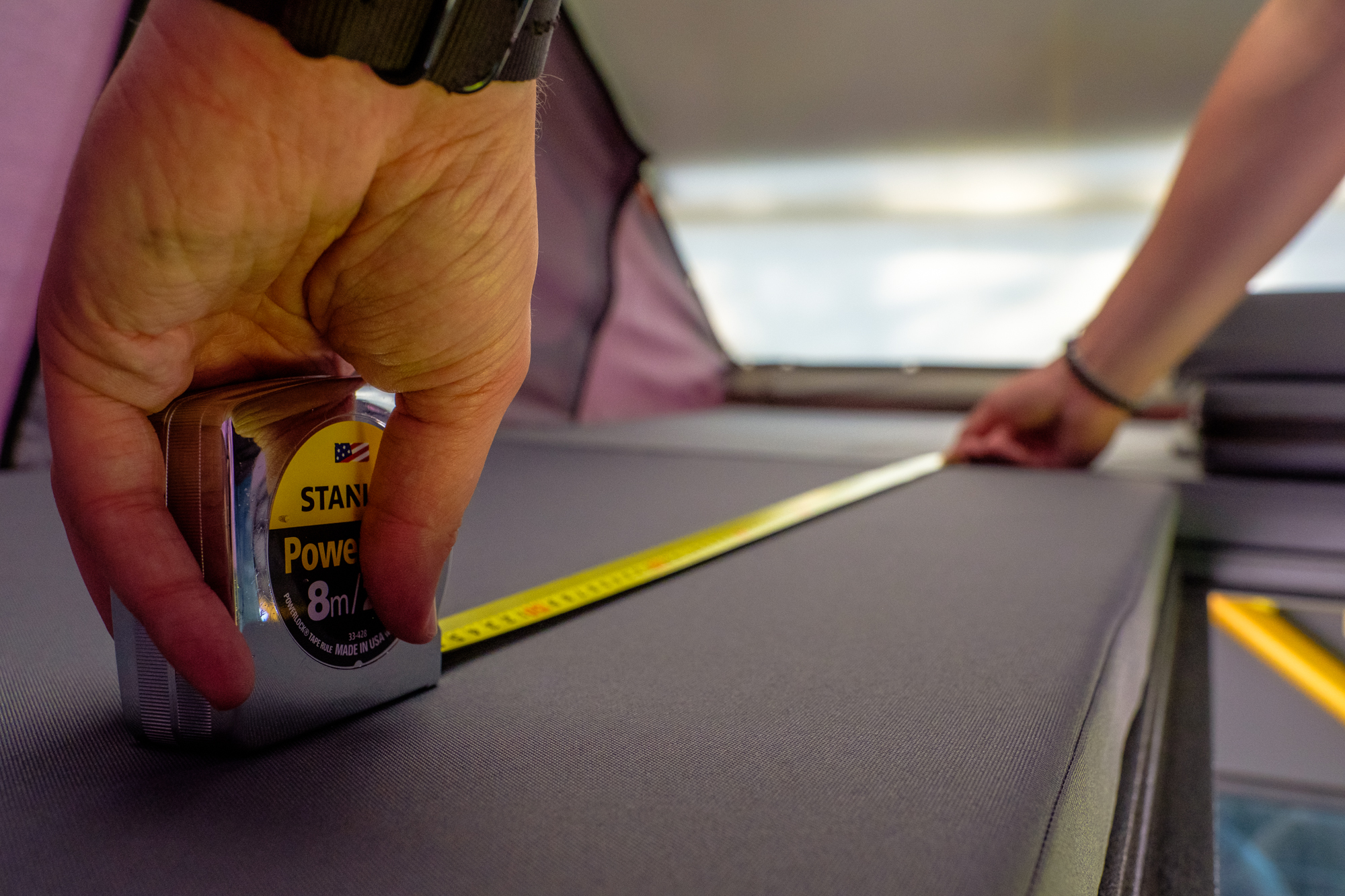
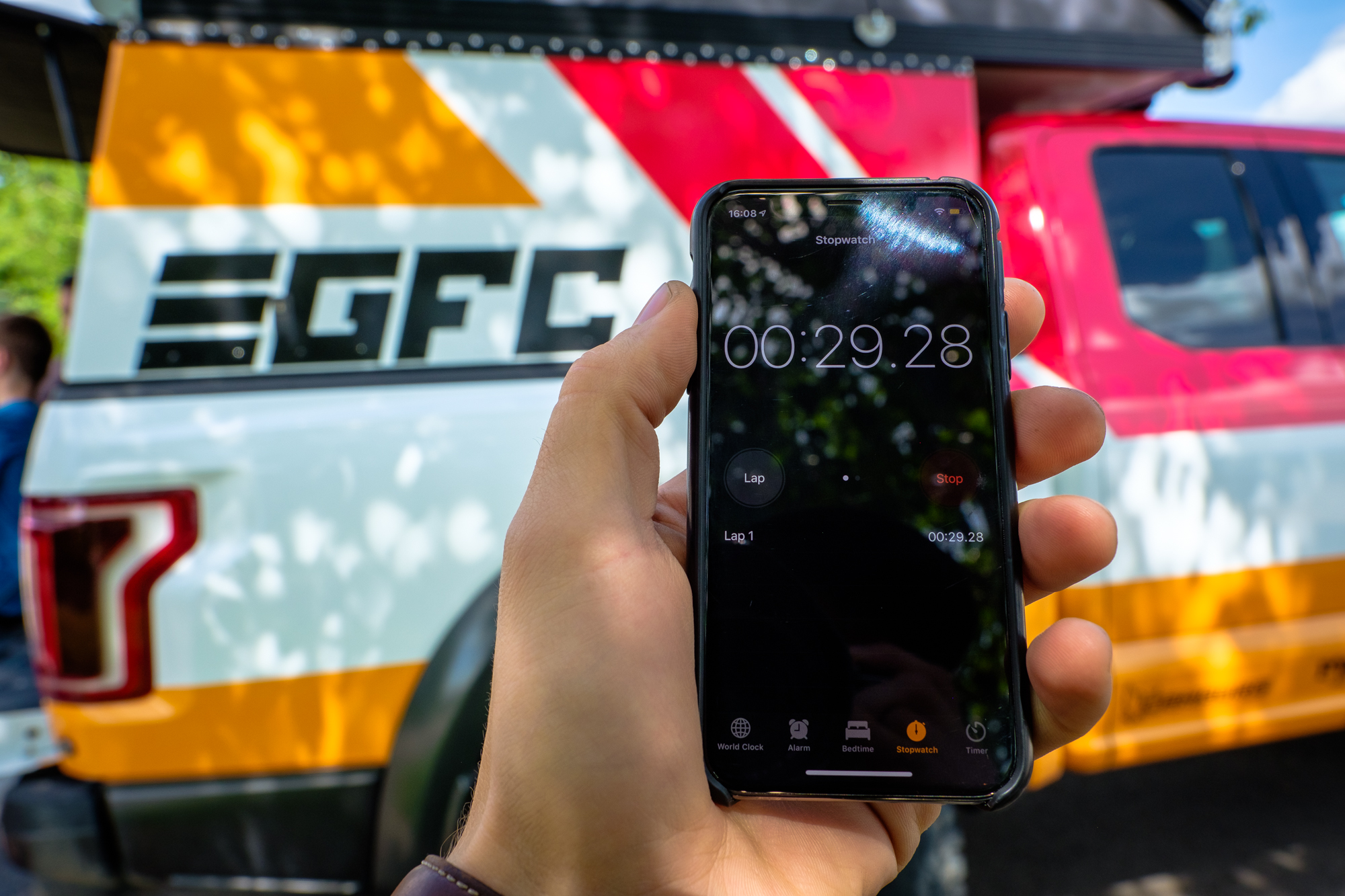
Each test began by collecting feedback from the owner of each camper, through which we would inquire about their experiences with the product and determine what they would change or keep the same. We then took each camper on an off-pavement trip, running it down dirt roads to test for dust incursion, rattles, and components which might come loose. If it didn’t rain during our trip, we would spray the camper with water to test the seals and shake the tent extensively to search for rattles and fabric flapping. We slept in them, worked in them, and on occasion, even prepared meals in them to escape the winds and rains outside. After noting all of the features we liked and those we loathed, the test would be wrapped up with a timed opening and closing of the camper to see which was the fastest and easiest to use.
ALU-CAB CANOPY CAMPER
Starting at $9,495
Alu-Cab is one of the more established brands in this evaluation and has made a reputation for itself building products like the Expedition tent and the Shadow Awn, which recently won our Editor’s Choice award in a 270-degree awning test. This prior experience with their equipment combined with the Canopy camper’s base price of $9,495, the most expensive in the review, set our expectations rather high.
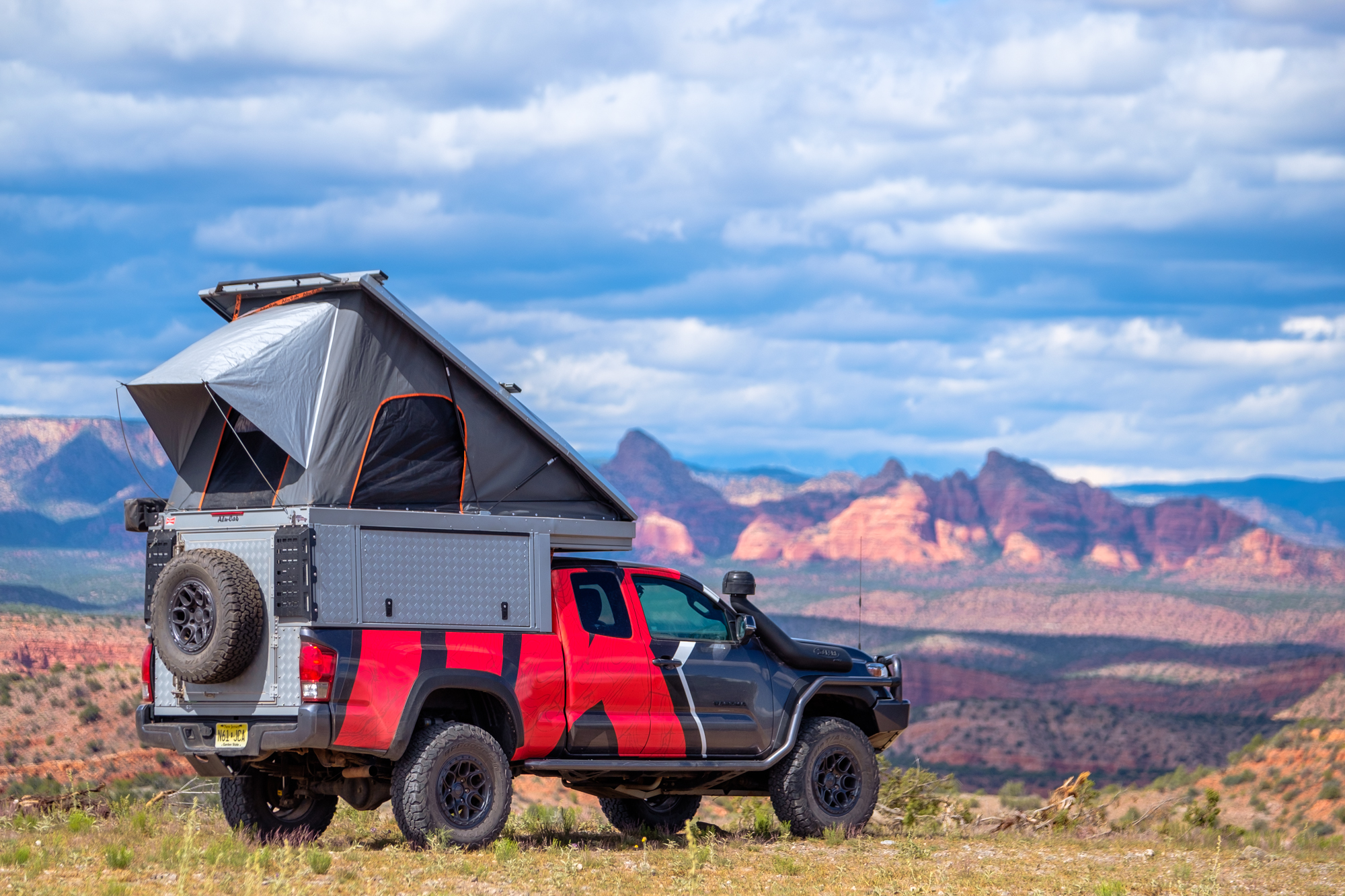
The first thing you should know about this camper is that it’s different. Unlike its competitors, the Canopy replaces the tailgate entirely with a full-size rear door and aluminum surround which allows customers to fully seal the cap against the truck bed, eliminating the gaps which occur between the tailgate and truck bed with every other camper. This reduces dust incursion, but also makes entering or exiting the camper much easier, because you don’t have to pull a tailgate up from the inside. Another distinguishing factor on the Alu-Cab is its exterior, which isn’t smooth aluminum, but rather a diamond or checker plate pattern the South Africans like to call checkah. I think it looks like you’re hauling an enormous toolbox around, but whatever floats your boat, brah. Fortunately, that checkered pattern is offset by the overall look, fit, and finish, which are all fantastic.
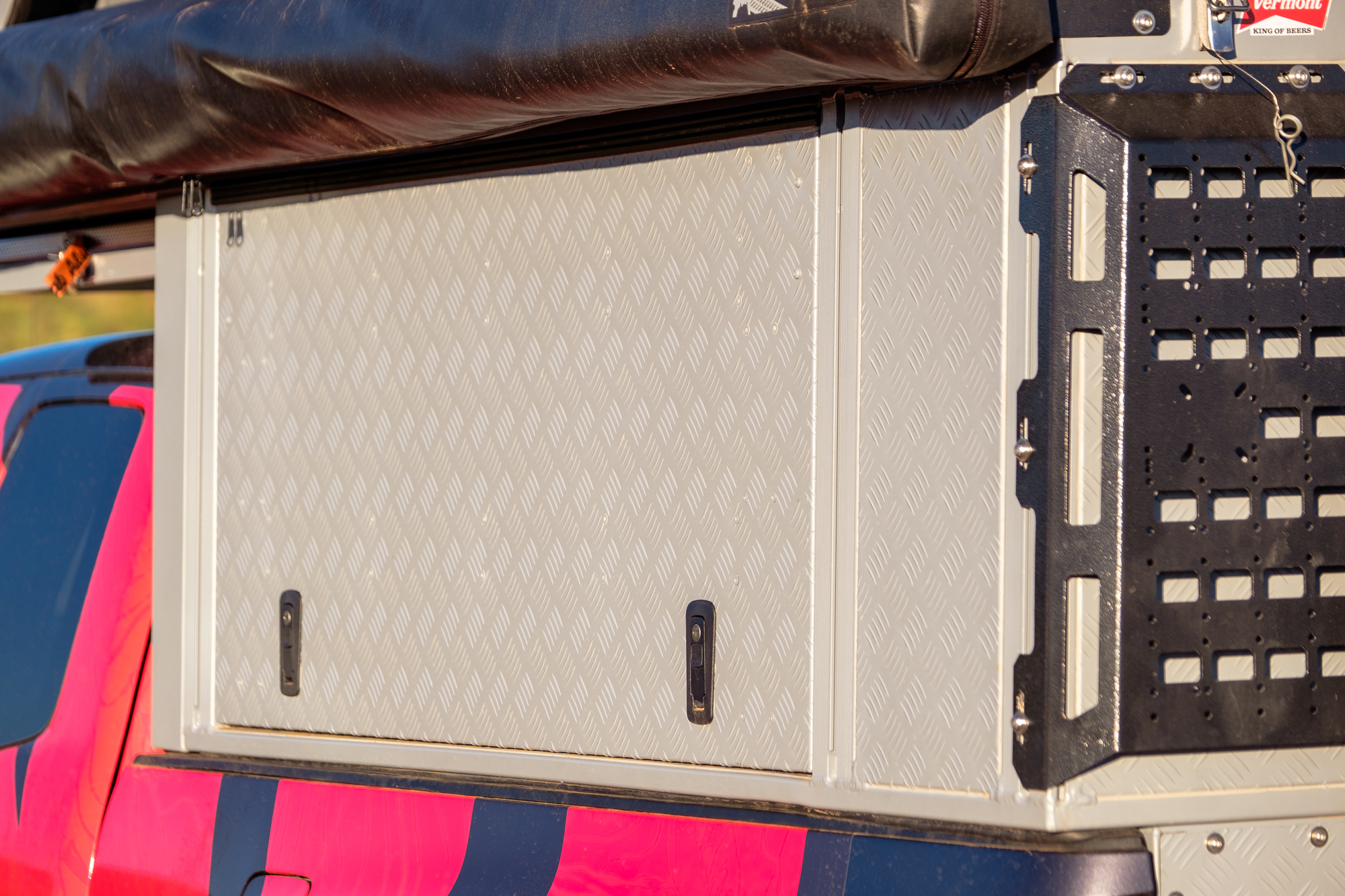
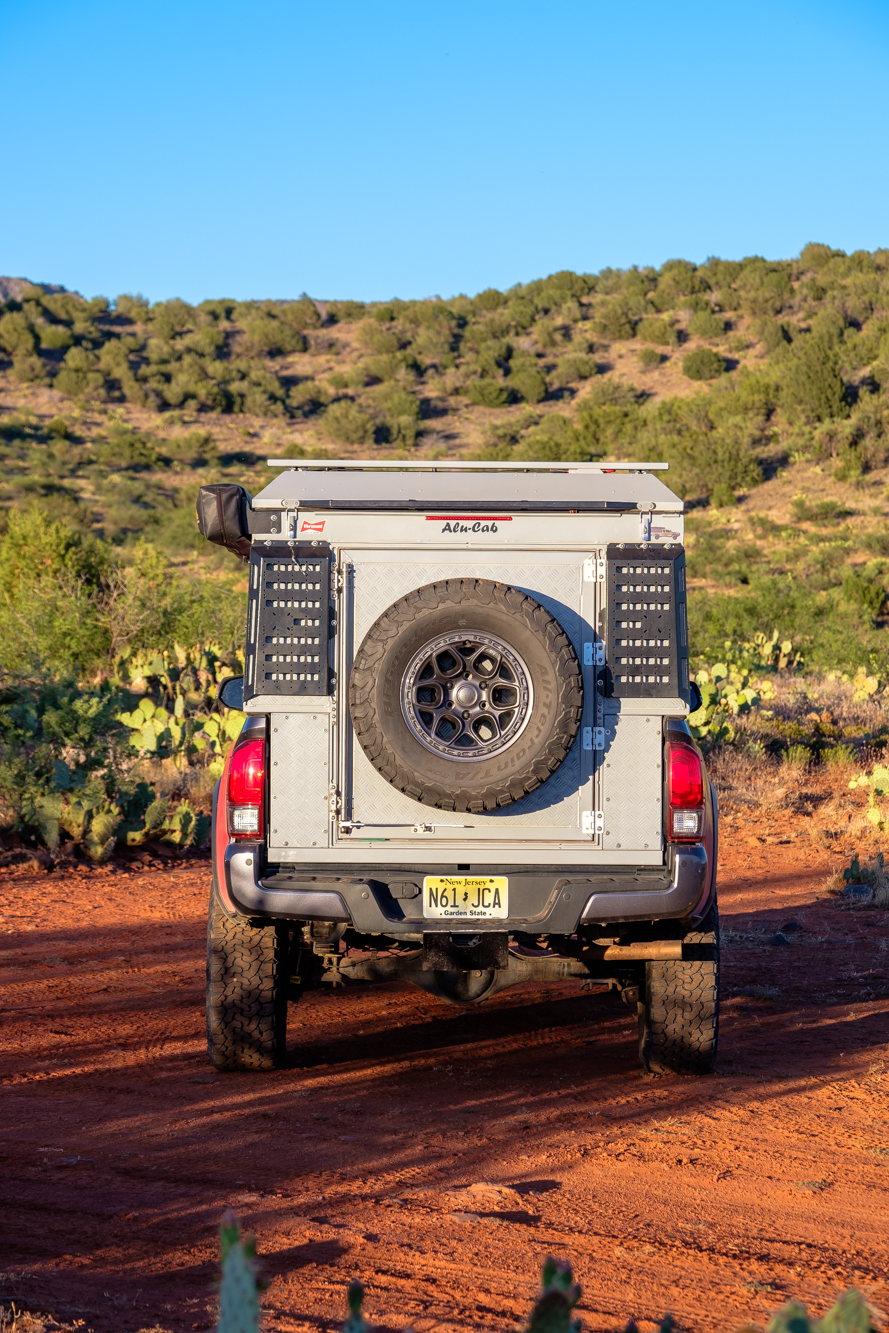
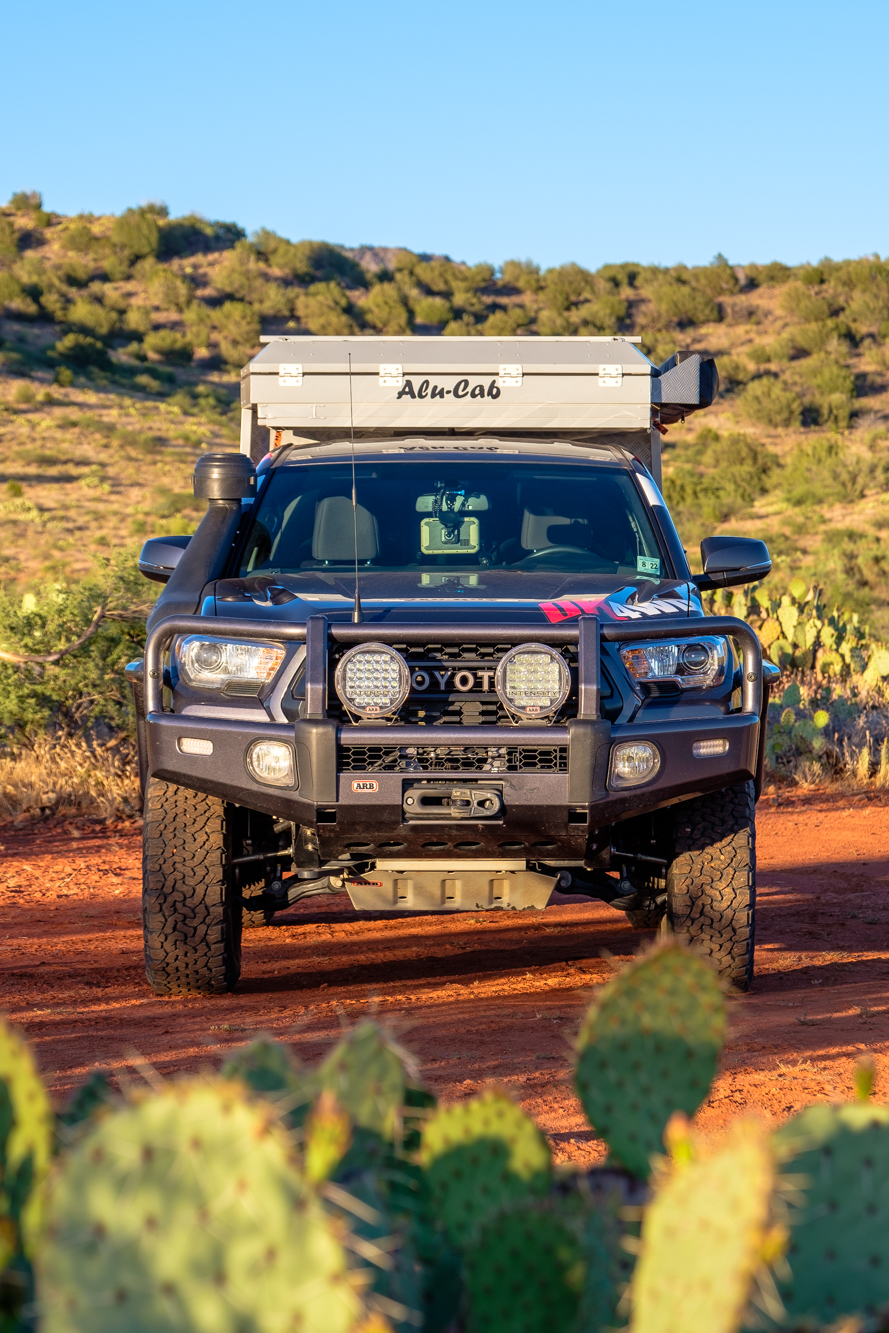
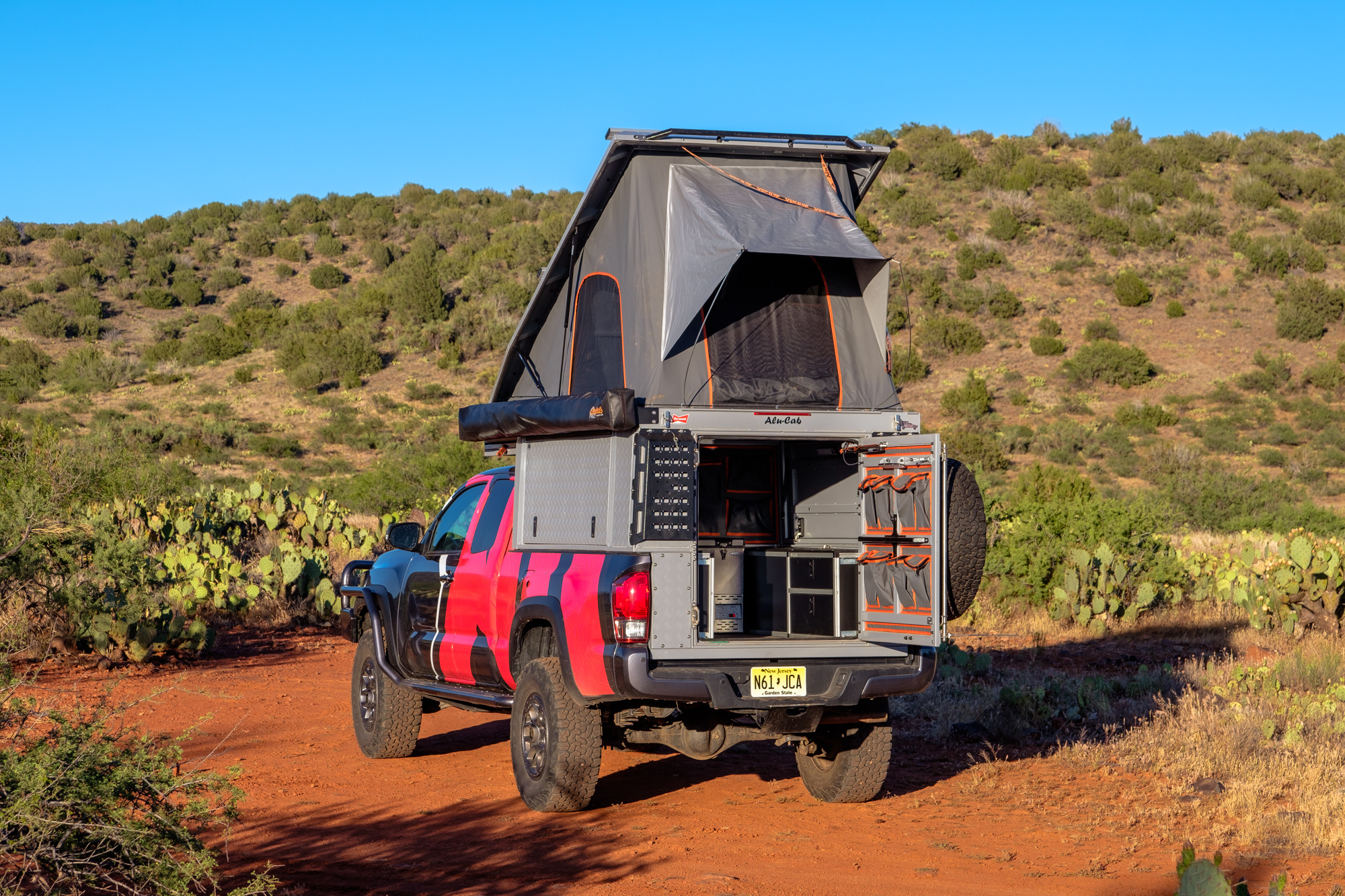
The Canopy isn’t short on innovative features either. Look underneath the cab-over, for example, and you’ll find an aluminum camp table tucked away on one side, with a slide-out shower stall on the other. Besides providing easier access and a better seal, the rear door serves as a spare tire carrier so you won’t need a swing-out rear bumper getting in the way.
Step inside, and you’ll find even more fun additions, like convenient storage pouches mounted on the ceiling and doors, reading lights and power ports tucked into the aluminum space frame by the bed, and white/red LED lights to illuminate the interior during the evening.
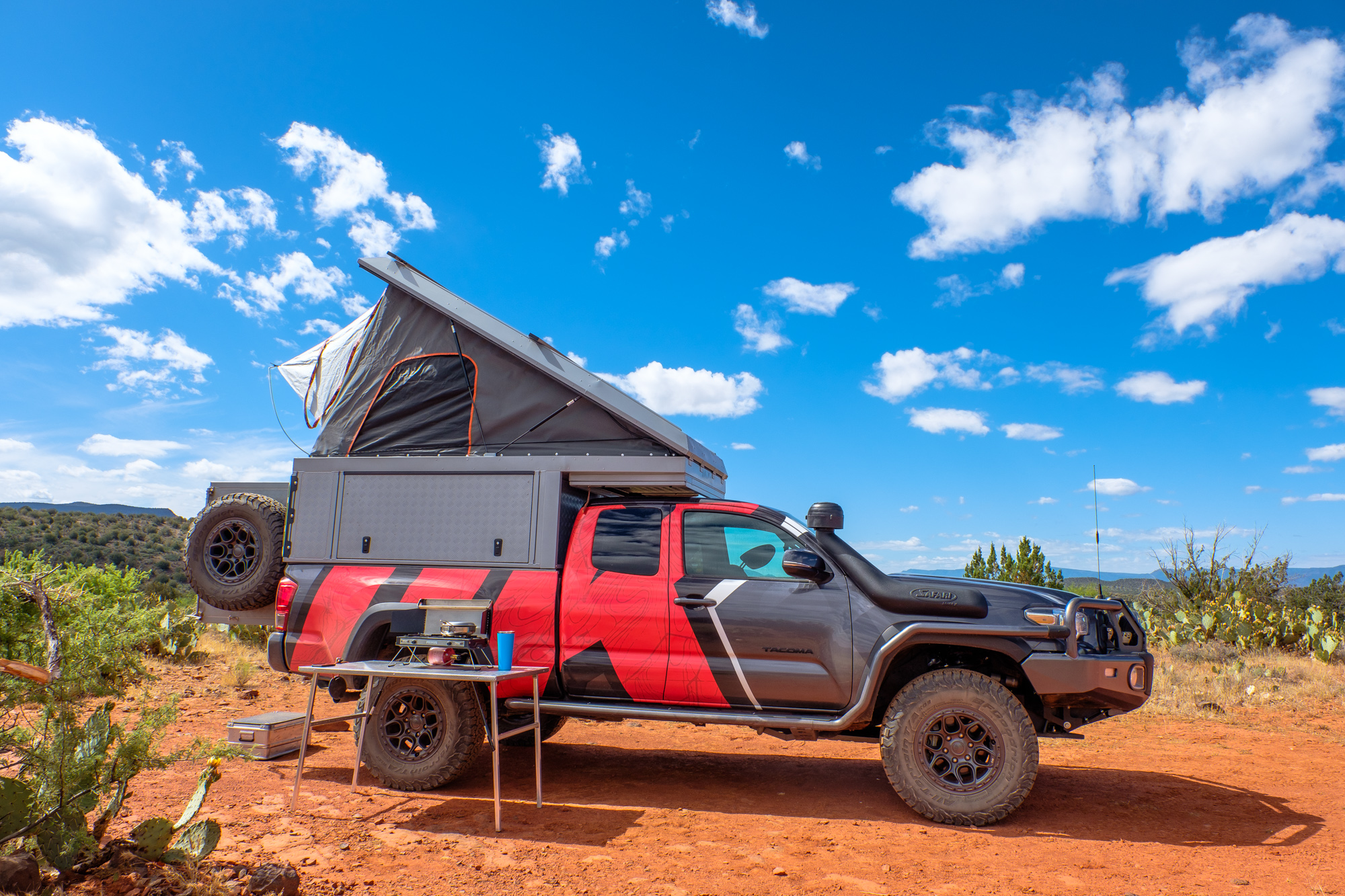
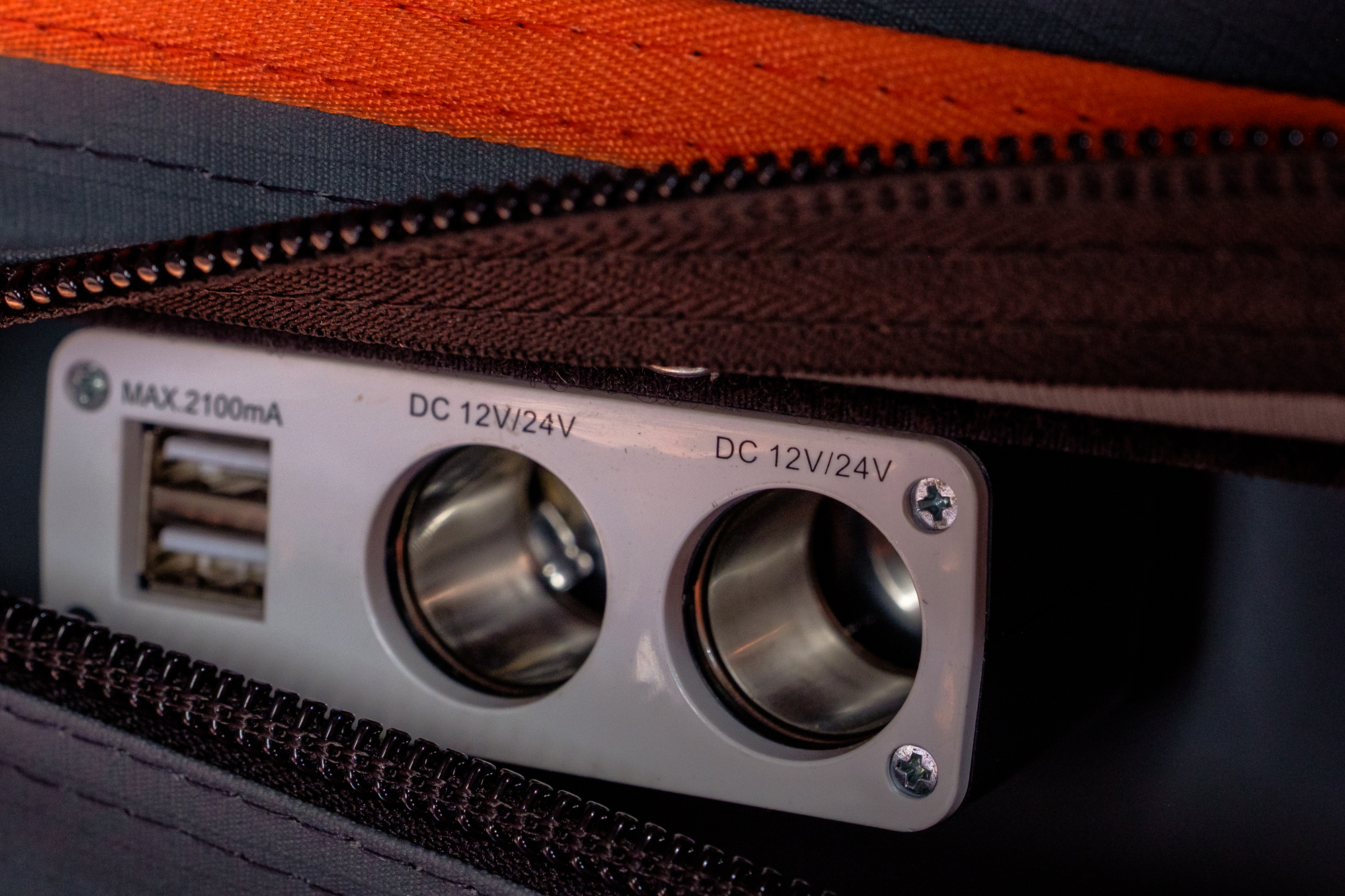
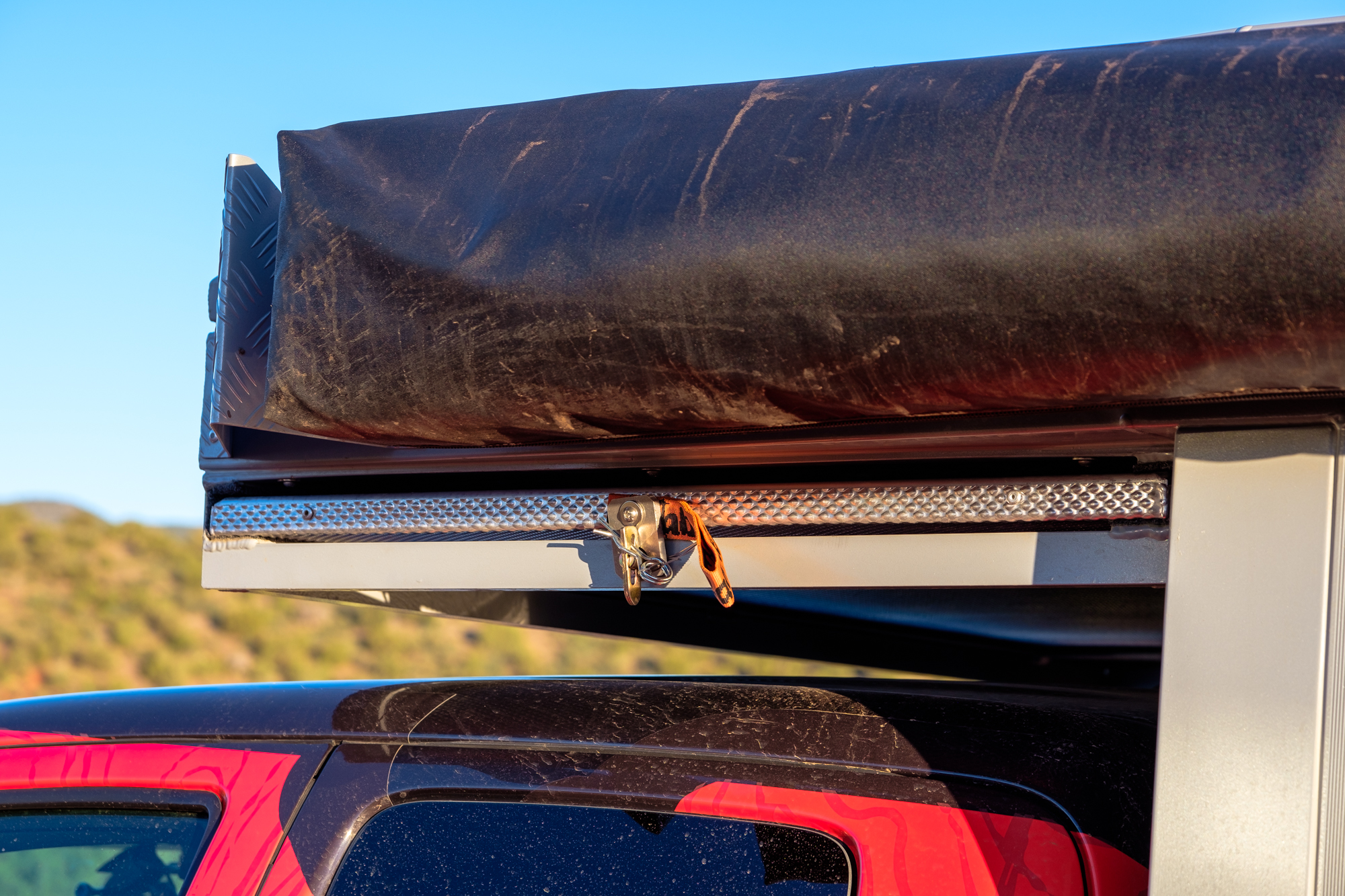

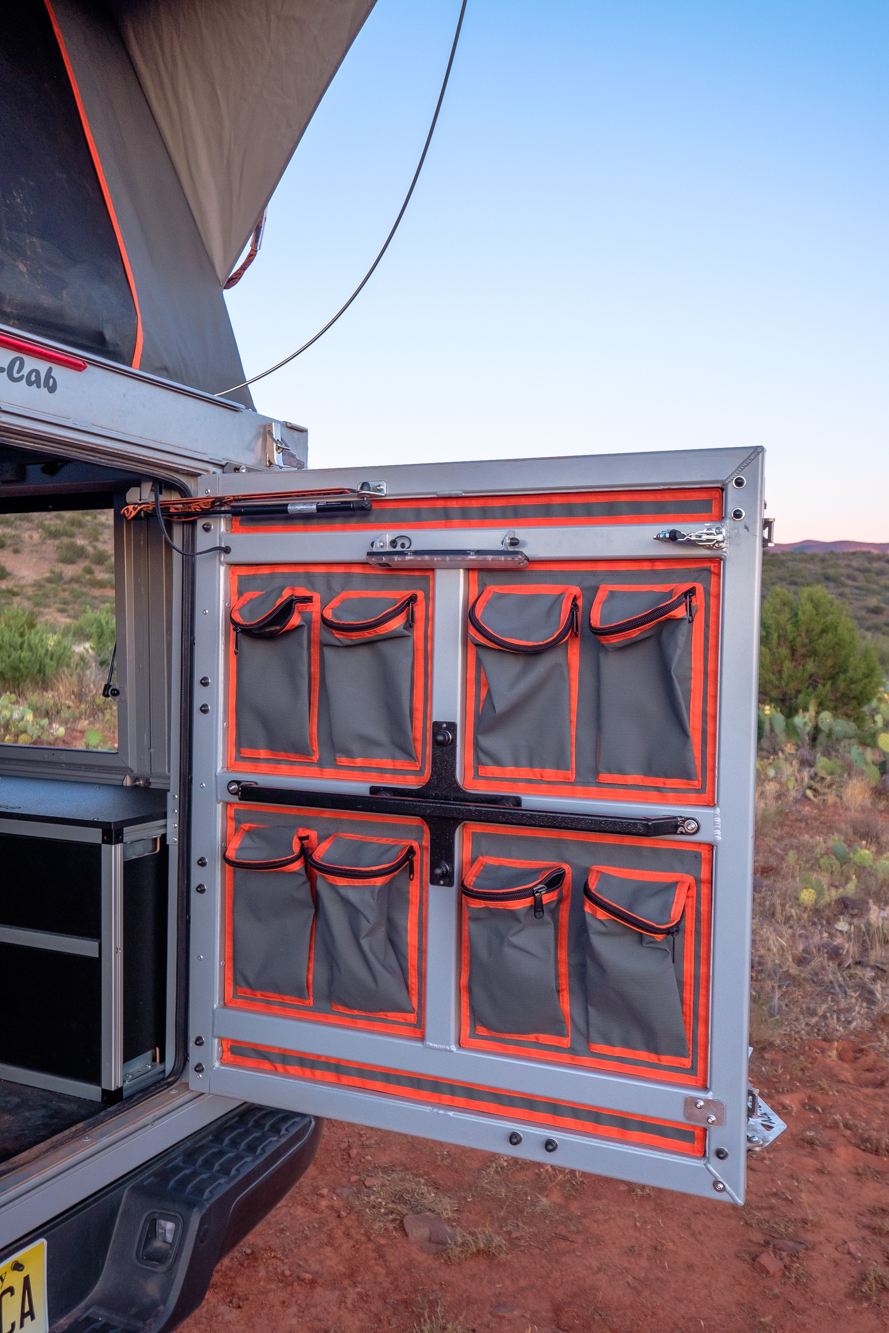
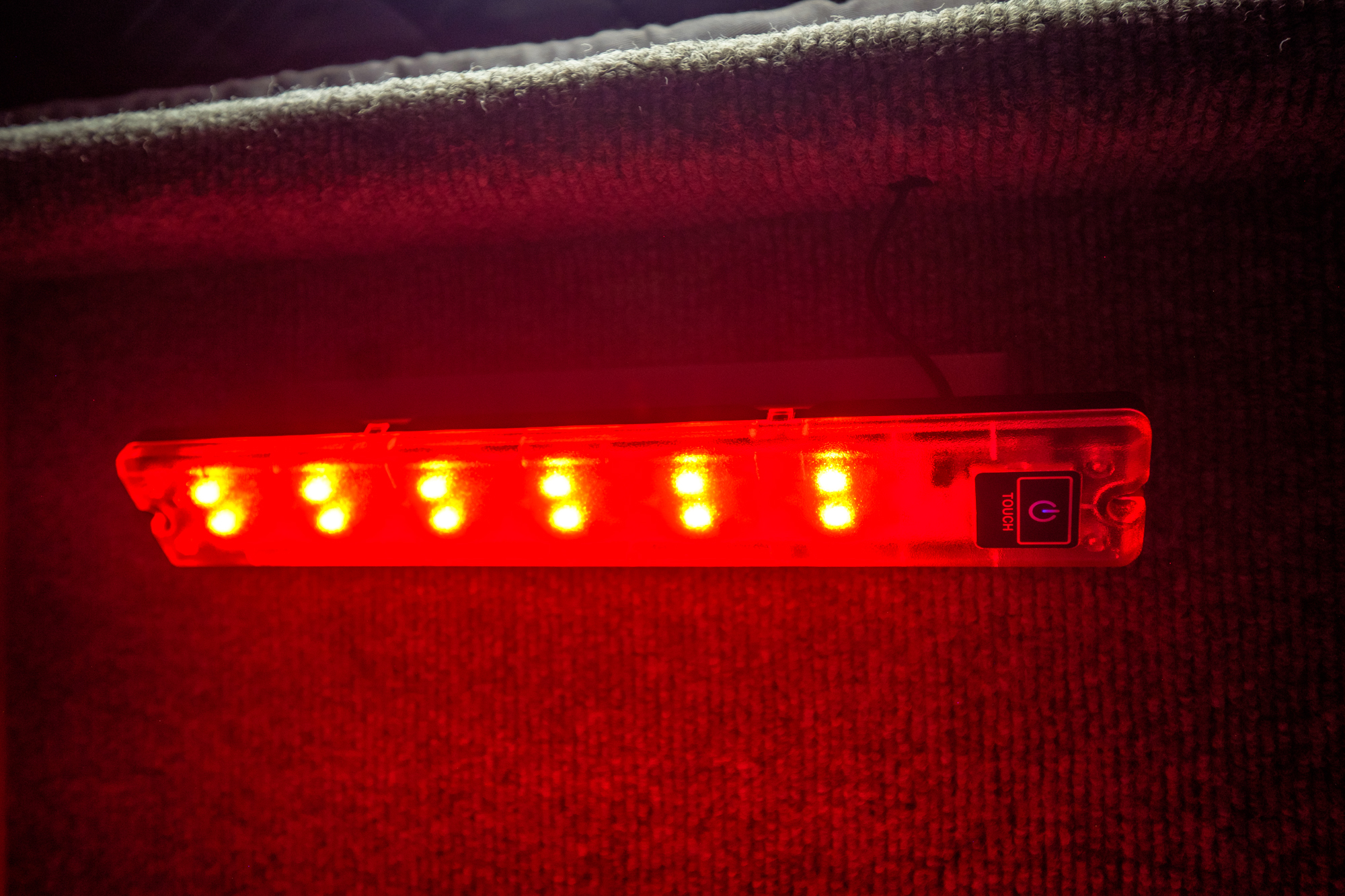
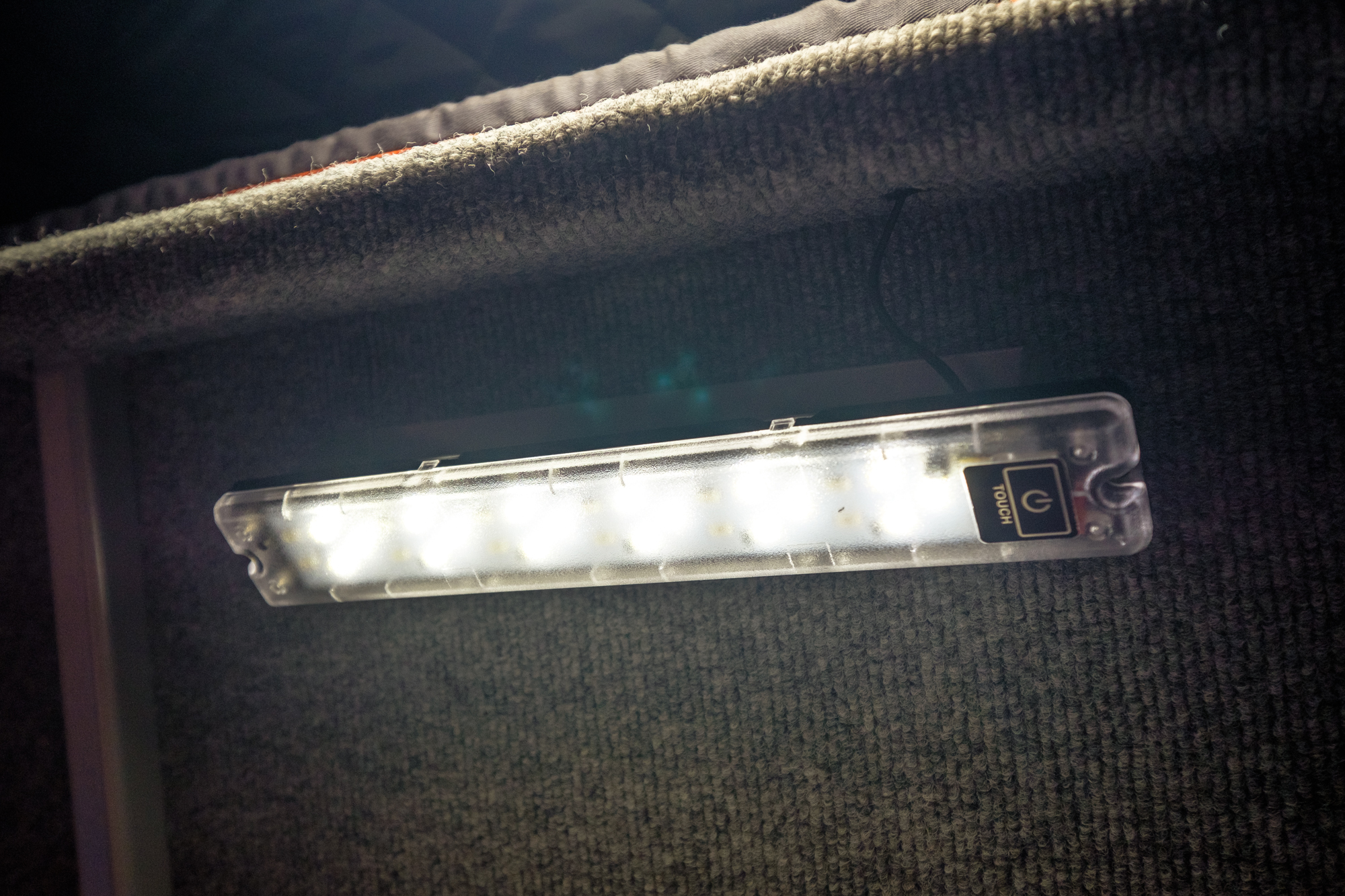
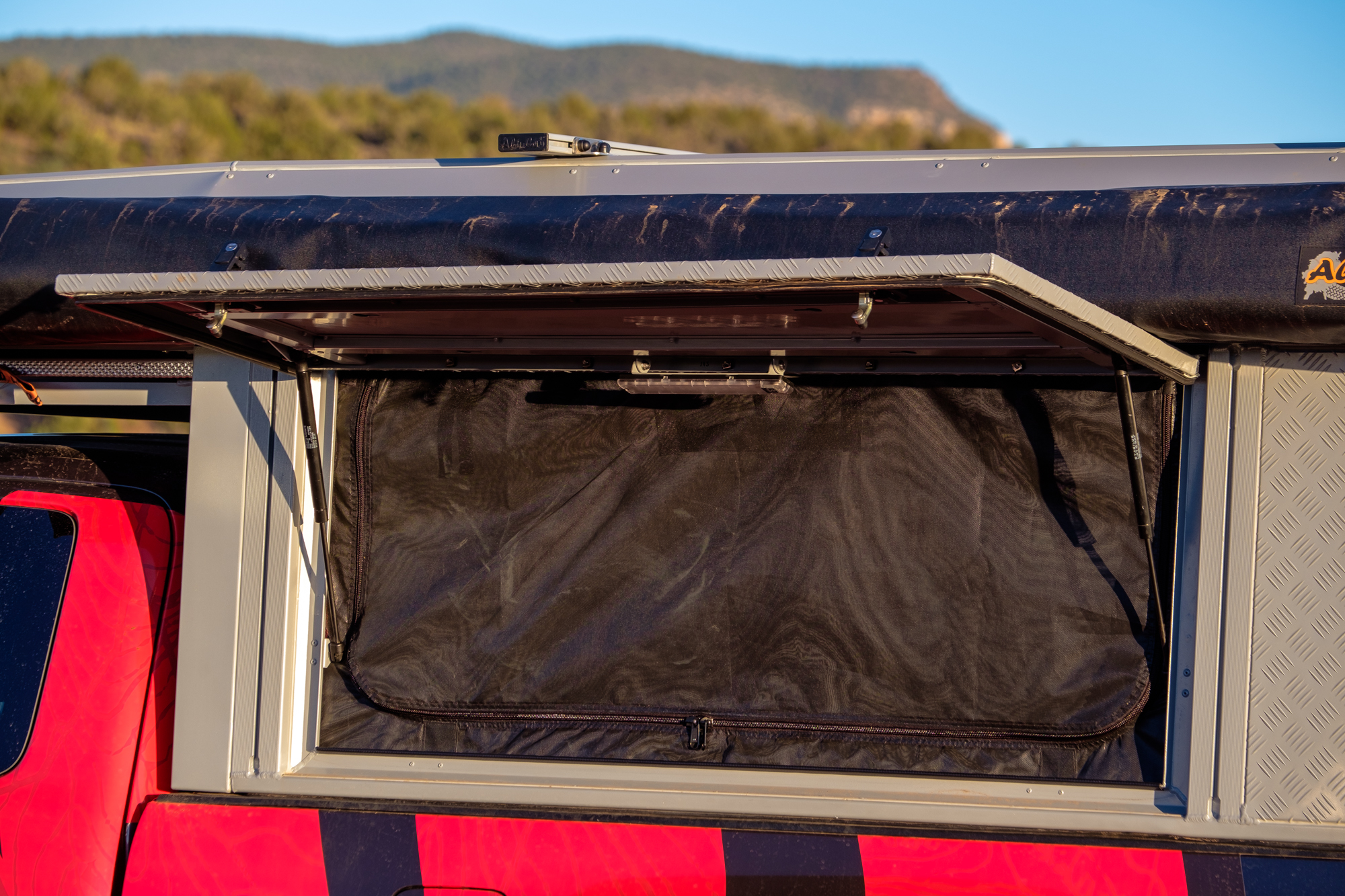
Living space is bountiful, with up to 116 cubic feet in which to stand, move about, or relax in. I found that it actually felt larger than one of the full-size shells we reviewed, thanks to the vertical walls which maximize space efficiency. The downside is that the walls stick out past the cab of the truck, increasing wind resistance and making them easier targets for branches and obstacles. Still, that’s a downside I’d be willing to accept for the space it affords.
I liked the “dual-layer tent,” which is constructed from a 400-gram, UV-resistant, rib-locked waterproof canvas, but I would have appreciated clear windows in addition to the bug screen in order to enjoy natural light and views during rainy or cold weather. I would have also liked to see an optional tent insulation package for a camper shell of this caliber, as it is certainly one of the most “full-time-able” options in our test. OK4WD states that a mild insulation package will be available by the end of 2019 though, and the roof already includes 25 millimeters of closed cell foam between the headliner and frame.

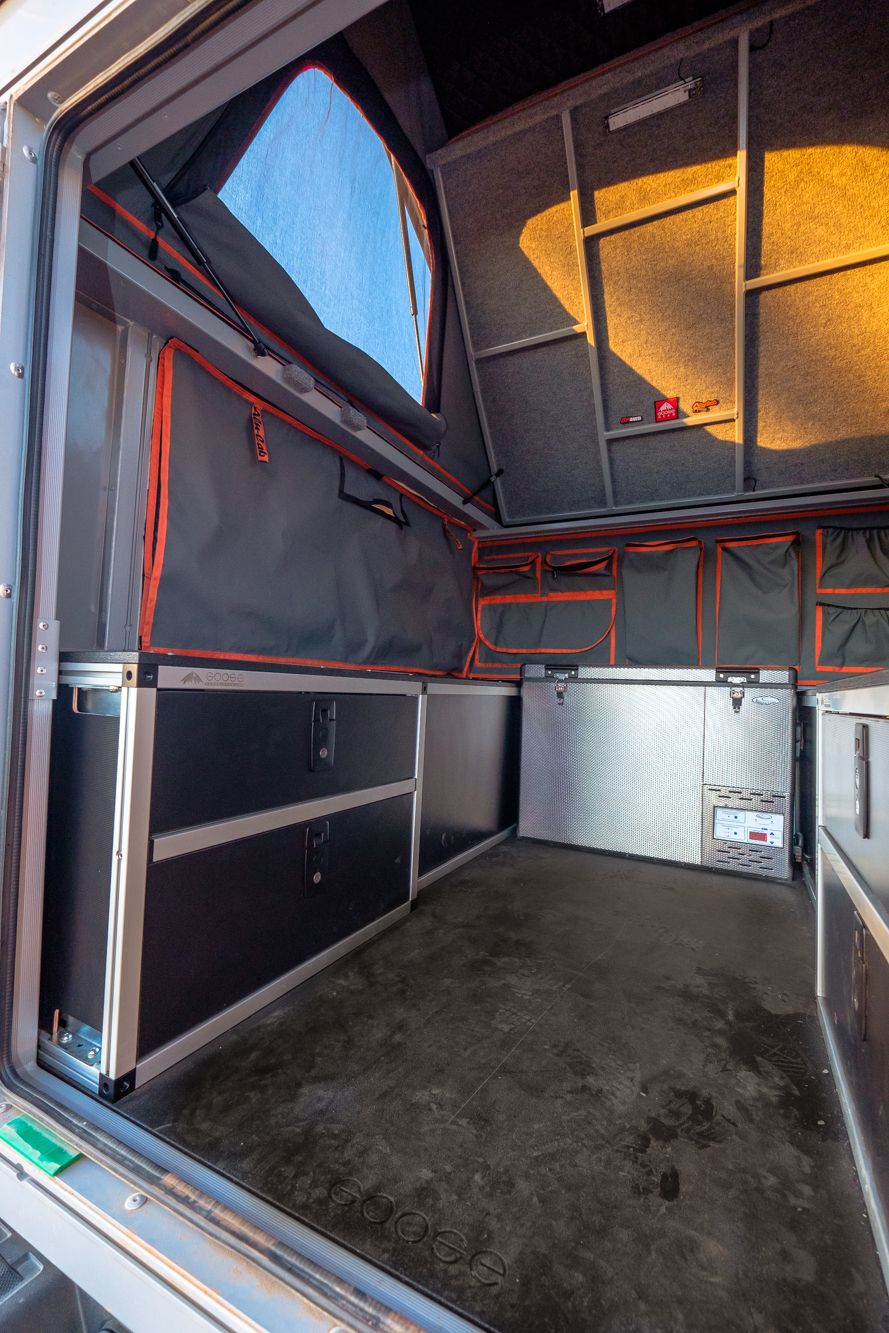
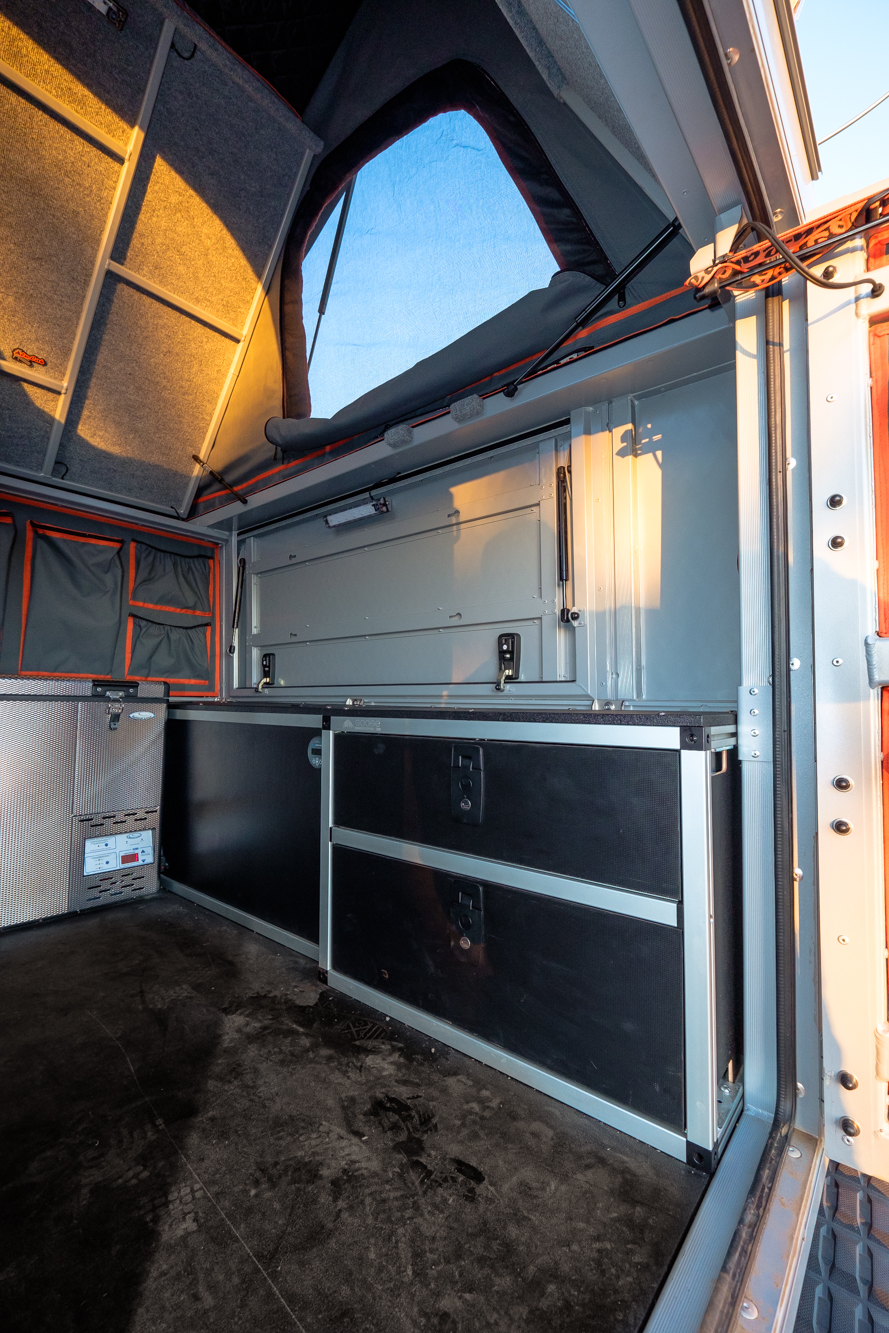

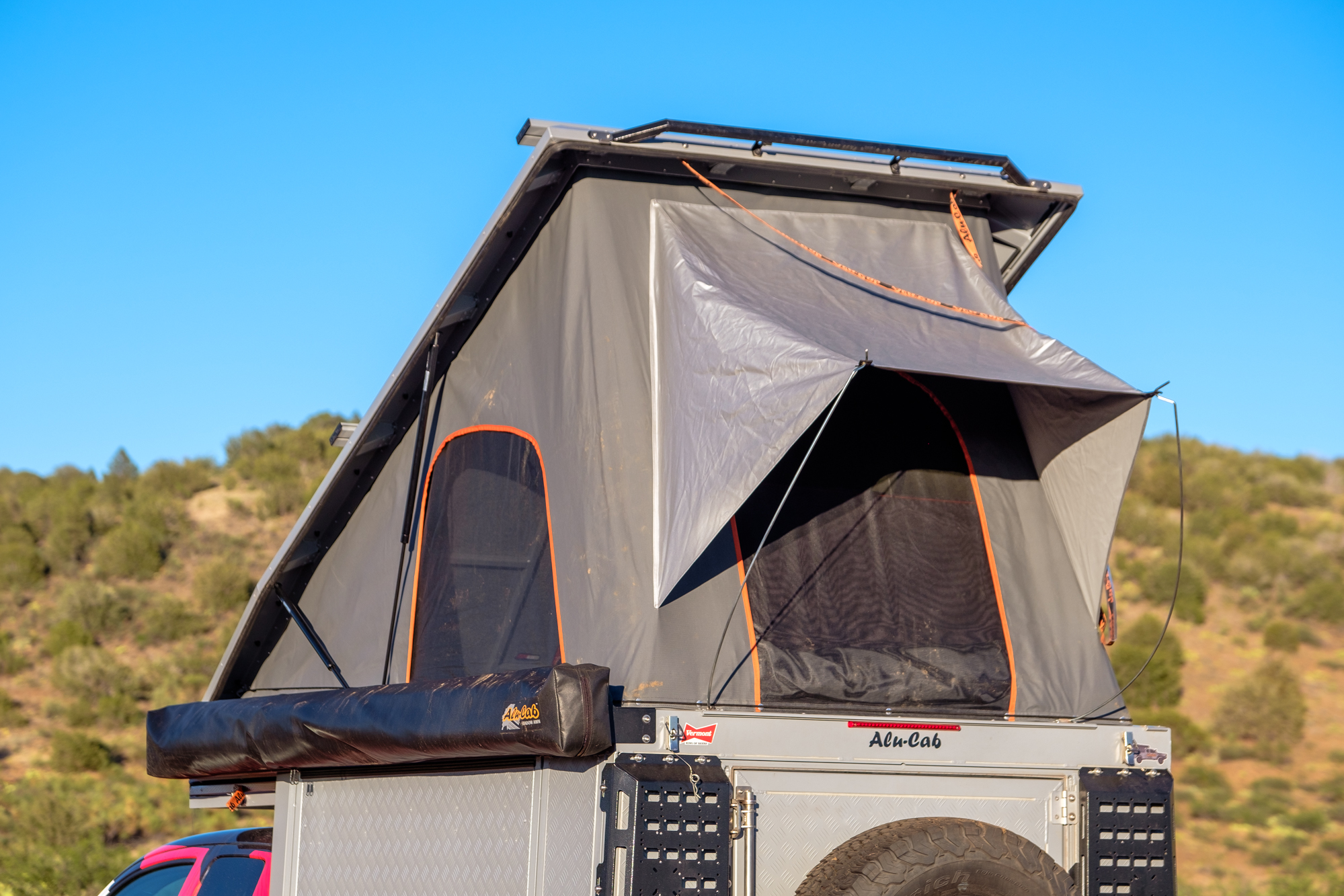
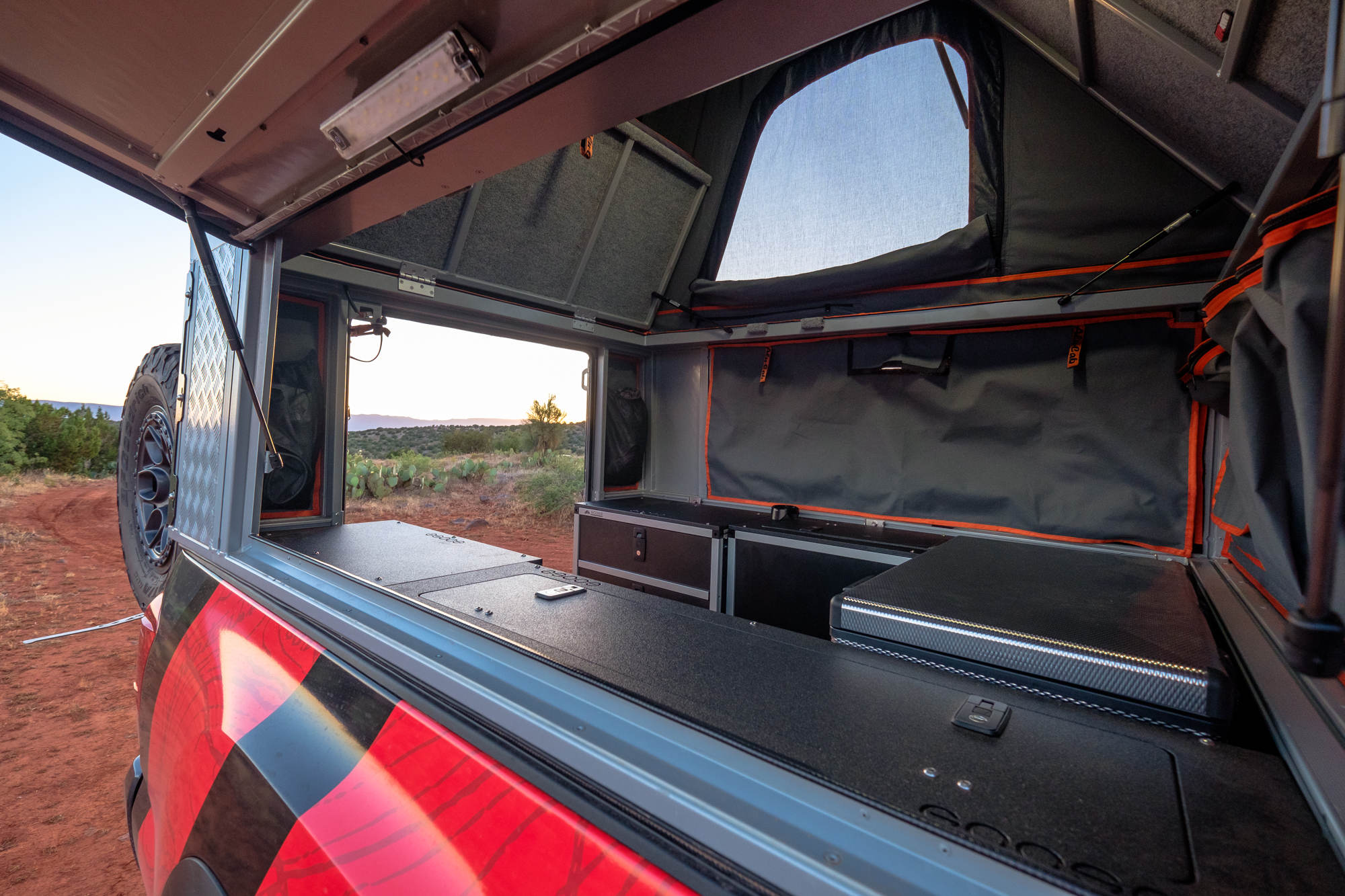
Water and dust resistance was excellent. However, the fabric flapped in the wind at night and I didn’t like that you had to deploy spring steel bars each time you popped the tent; this just added additional time and complexity to a product which didn’t need it.
The bed is the largest in the test, measuring in at 100 x 54 inches when fully deployed, but it certainly wasn’t my favorite. That’s because it is split into two sections at 78 inches to allow occupants to climb between the lower camper and the upper bed. This might seem okay on the surface, but if you wake up to use the restroom in the middle of the night, you’ll need to move whoever is sleeping next to you, ask them to scrunch down to the bottom of the bed so you can open the panel, and then when you come back, have them do it all over again. It’s possible to sleep on the 78-inch side alone, but you’ll need to remember that the angle of the wedge can make that space too tight for your feet or head, so it’s not really 78 inches of usable bed space. The mattress was much too firm, and I would need to substitute it or add cushioning if I were to own one.
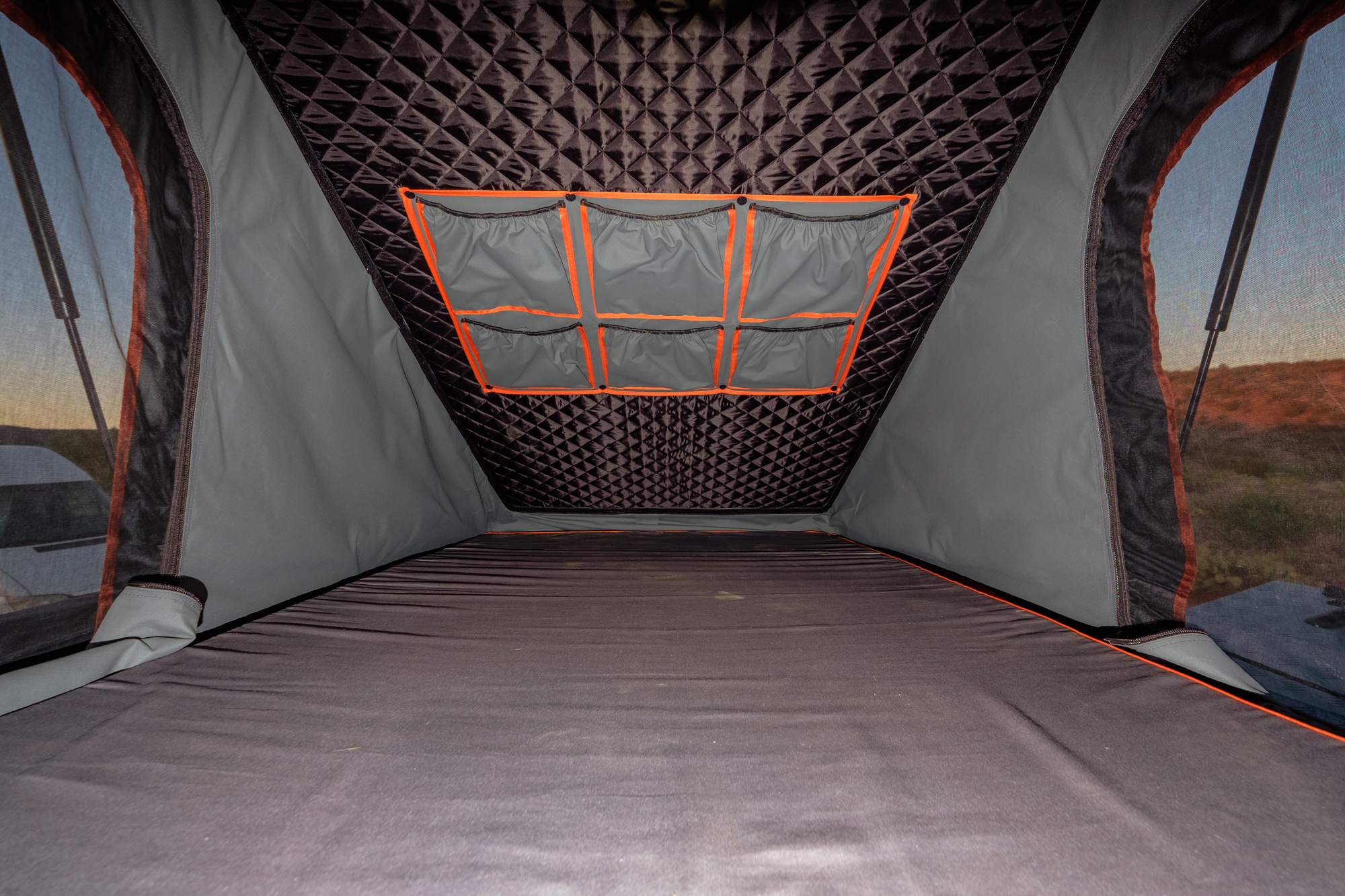
Finally, while the price of the Canopy camper is the highest of the group, it comes standard with side-access doors, lift struts for the bed, and a National Luna interior lighting system wired right in, which would quickly boost some competing campers past the $10,000 mark. In other words, it’s still a good bang for your buck. Just don’t get your hopes up if you own a 1/2 ton or larger truck because the Canopy is only made for mid-size options like the Ranger, Colorado, and Tacoma.

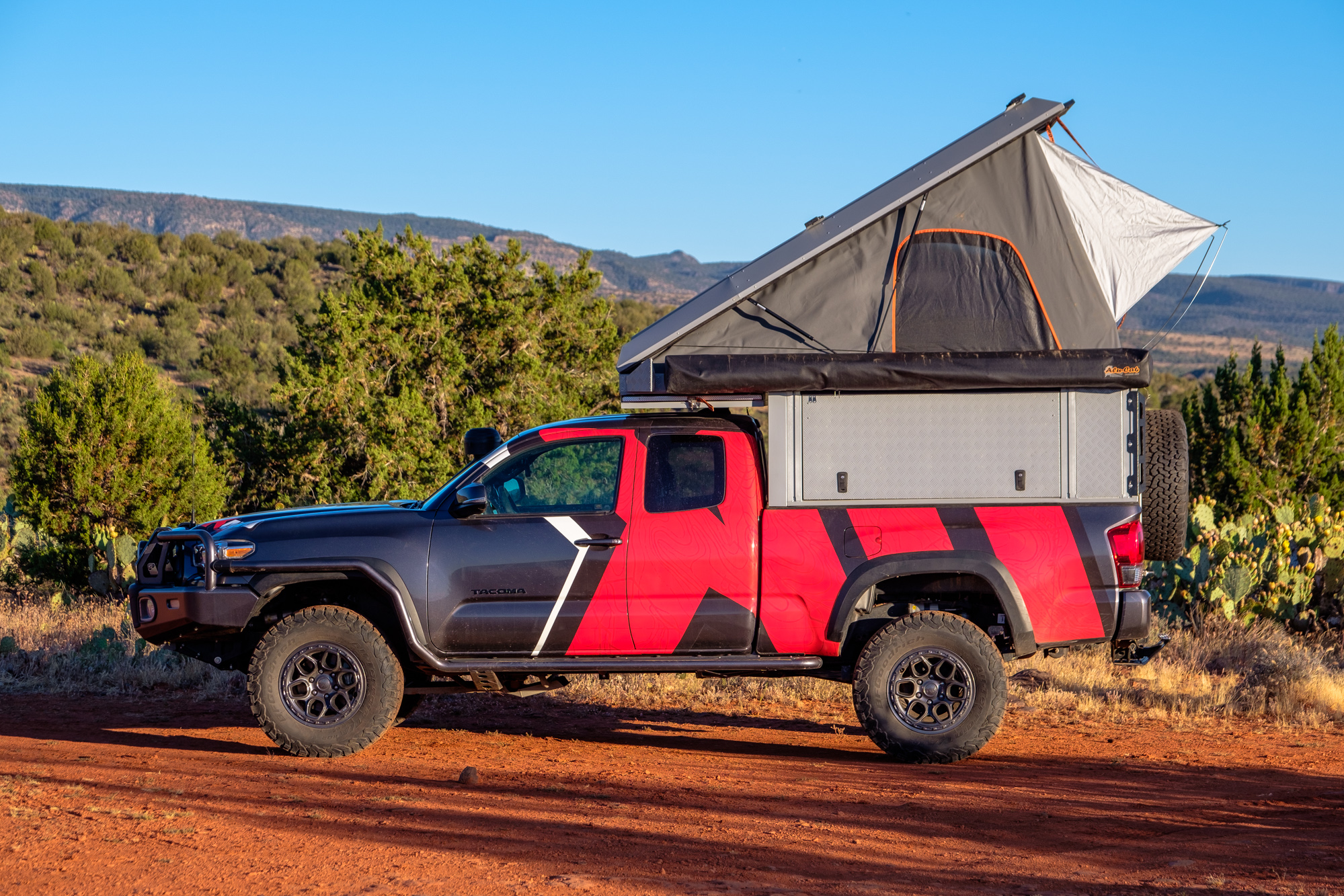

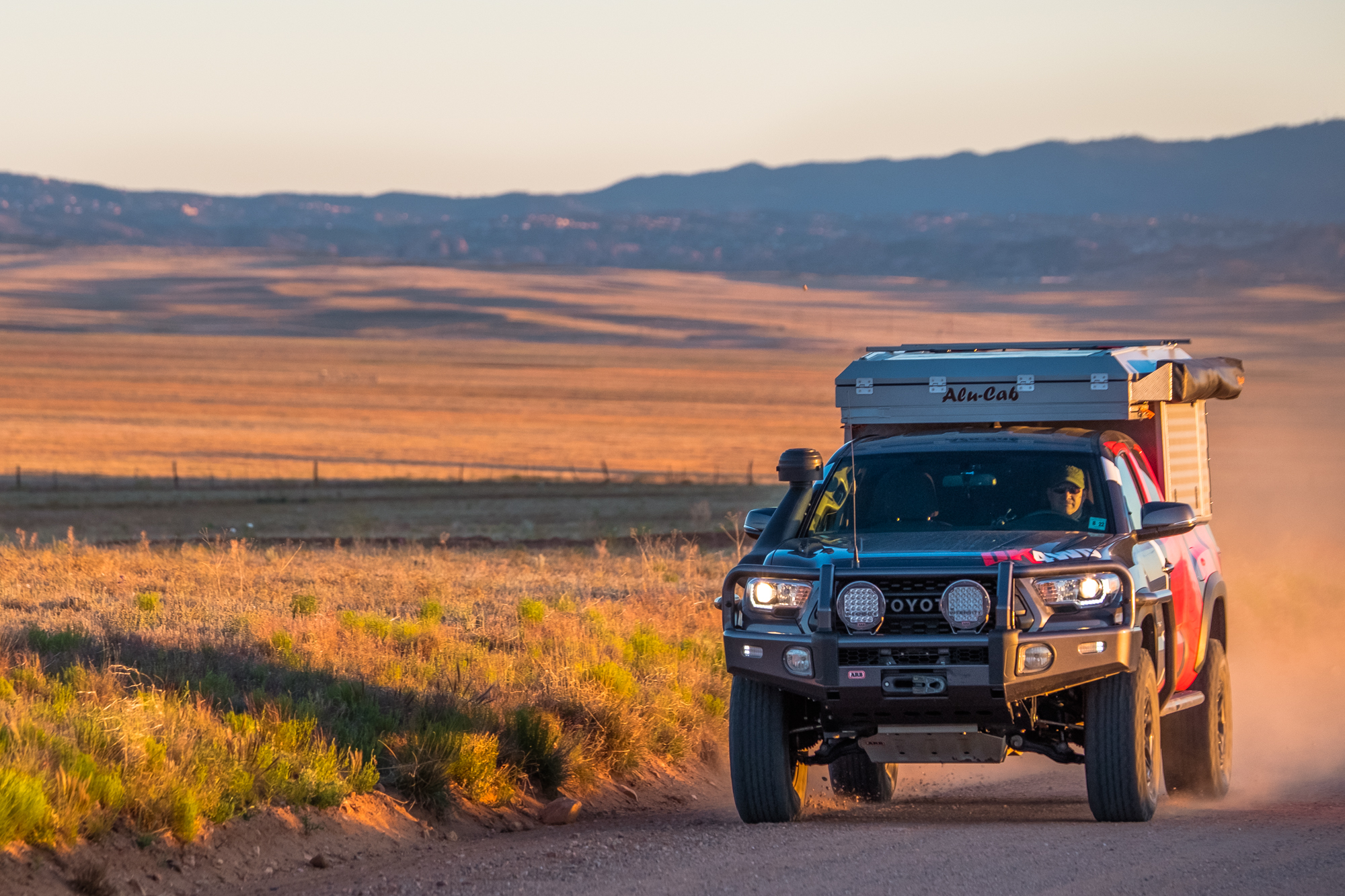
Pros
- Expansive interior
- Impressive fit and finish
- Unique options
- Well sealed
Cons
- Hard mattress
- Tent can flap in the wind
- Split bed design
- Only available for mid-size trucks
AT-OVERLAND SUMMIT | EDITOR’S CHOICE MID-SIZE
Starting at $8,900
This four-season wedge camper can be used in the heat of summer or the dead of winter and boasts an interior you’ll love. It’s creature comforts will make even the most demanding glampers happy, and there are many clever features which stand out amidst the crowd of competitors. But the biggest reason to buy a Summit isn’t the niceties, but the tent and insulation package which was without a doubt the best in our test.
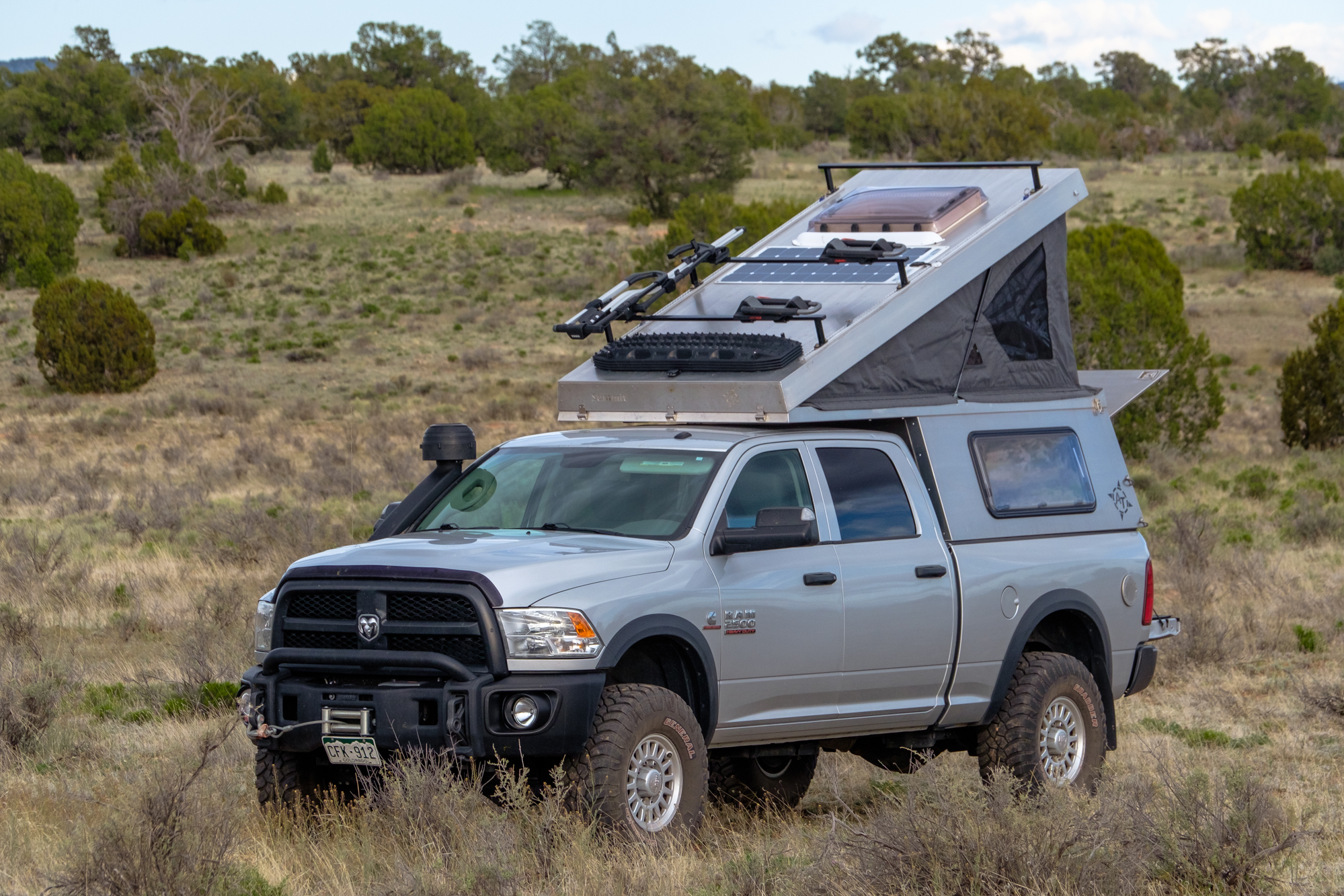
At first glance you’ll notice the Summit’s apparent advantages: the stitching is impeccable, the windows are lined up perfectly, and the fabric feels smooth with no rough or frayed edges. The more time you spend inside of it, the more you appreciate the details. You’ll notice how quiet it is because the material is just taut enough to not flap in the wind, while remaining loose enough to be easy to zip. The bug screens are made from a material designed for the military so they won’t snag or tear, and there’s an integrated peek hole so you can easily roll over and see what’s going on outside the tent without unzipping a huge window every time. Opt for the additional insulating liner, and you’ll find yourself tucked away in a warm and peaceful escape from the outside world. It packs an R-value of 1.4, which provides 34° to 36° of heat retention over just a standard tent. Don’t think it will be dark or dreary inside though, because the liner’s interior is white to reflect light, which provides a sense of spaciousness while reducing the number of lumens needed to keep the interior bright.
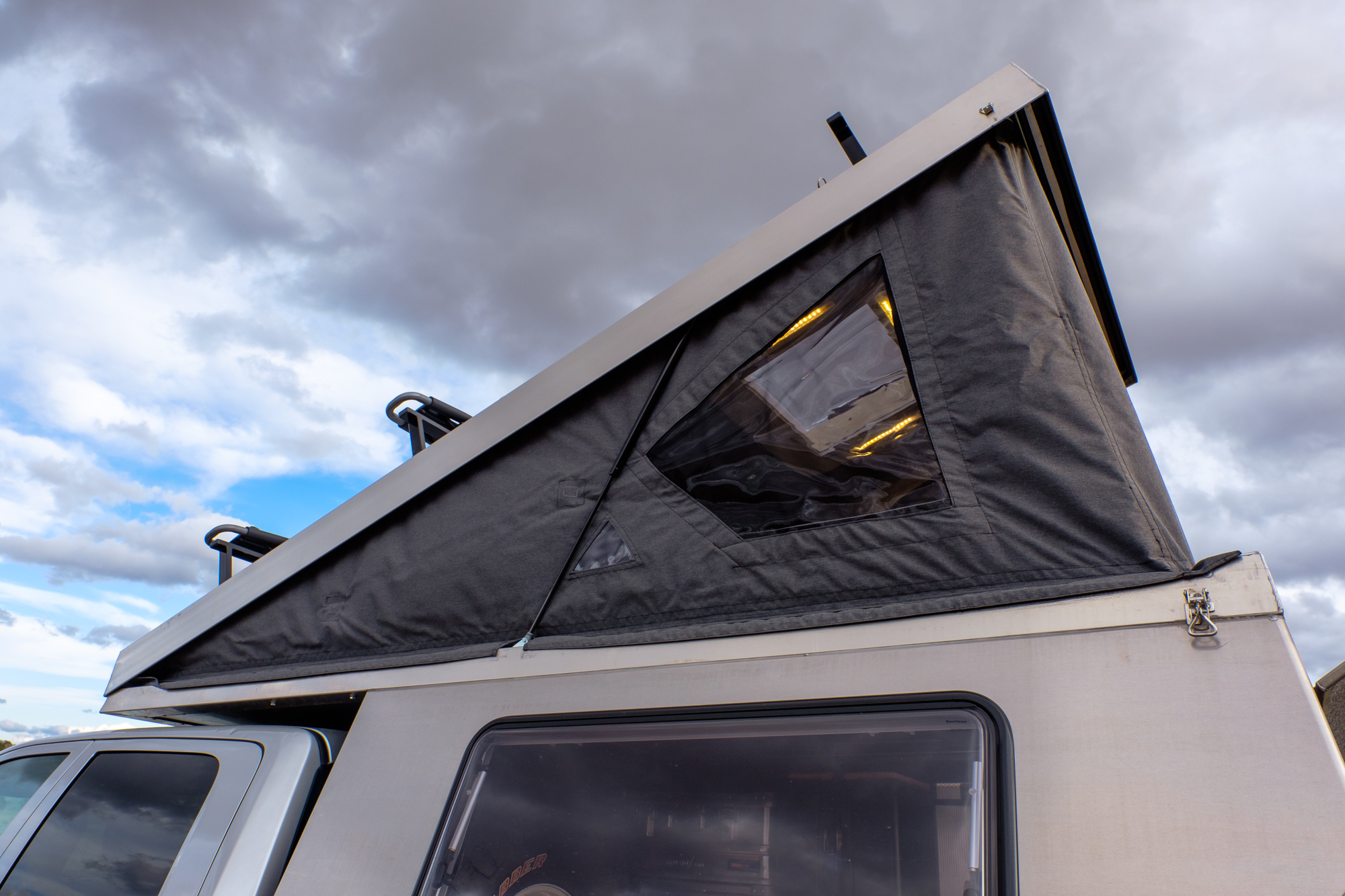

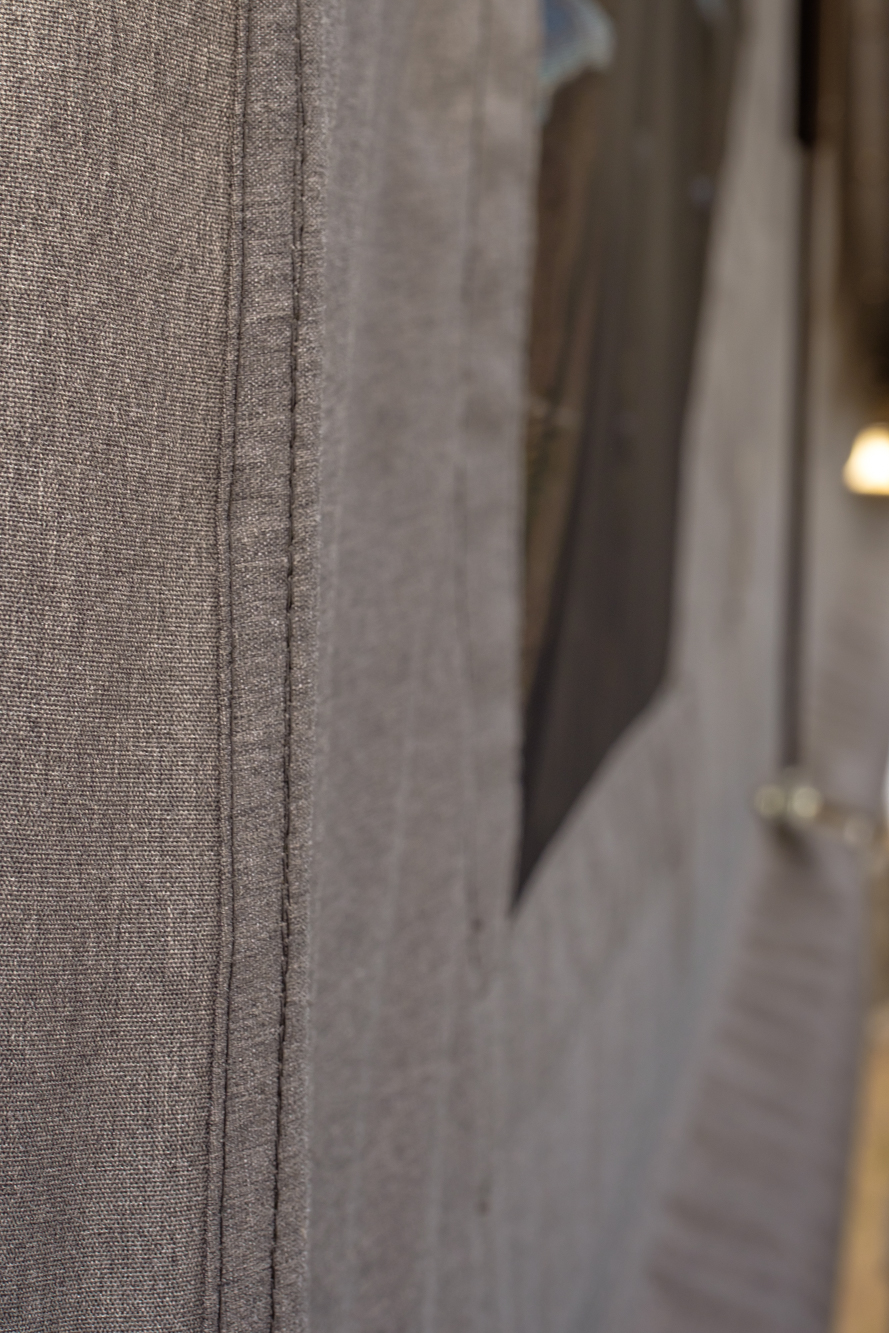
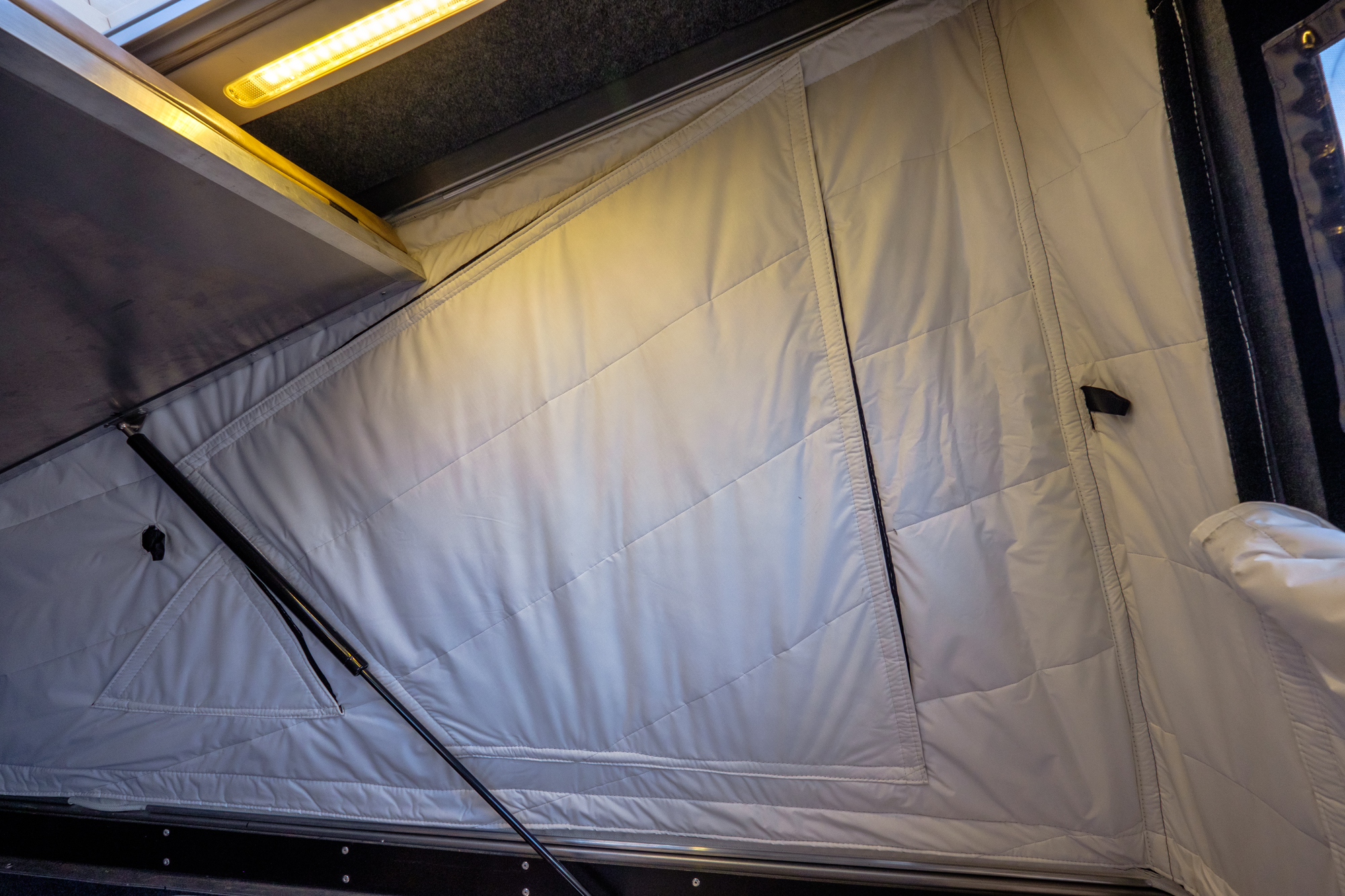

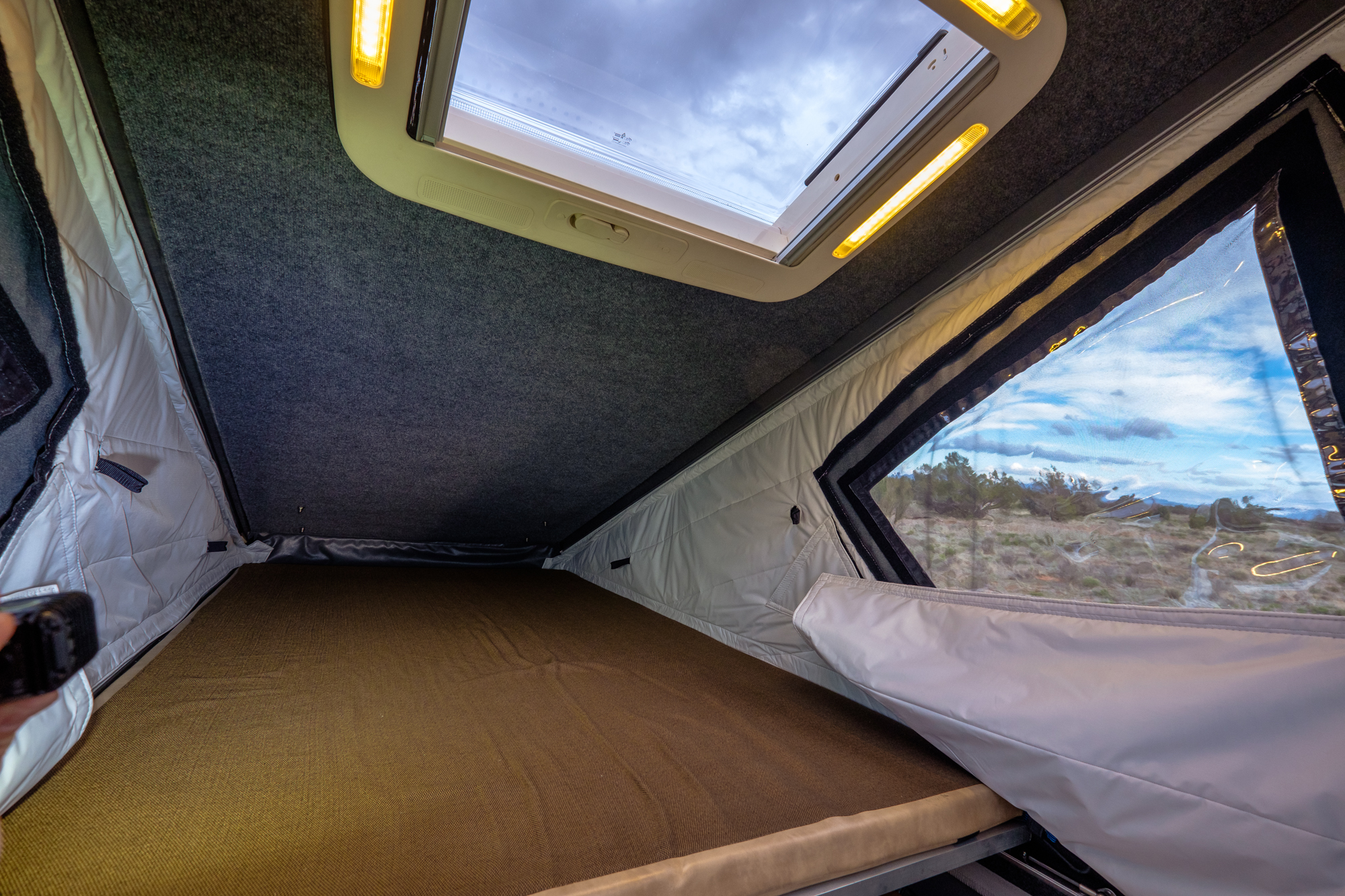
With all of this excitement around the tent, you might think that they slacked off on the rest of the camper, but you’d be wrong. The shell is made from .060” 5052 CNC formed aluminum with insulated aluminum composite panels and stainless steel hardware throughout. It is reinforced in stress points like the top rear corners, and designed to hold a 100-pound dynamic load on the roof or up to 600 pounds of people walking on it. Buyers can add side access doors, sliding windows, or a roof rack system.
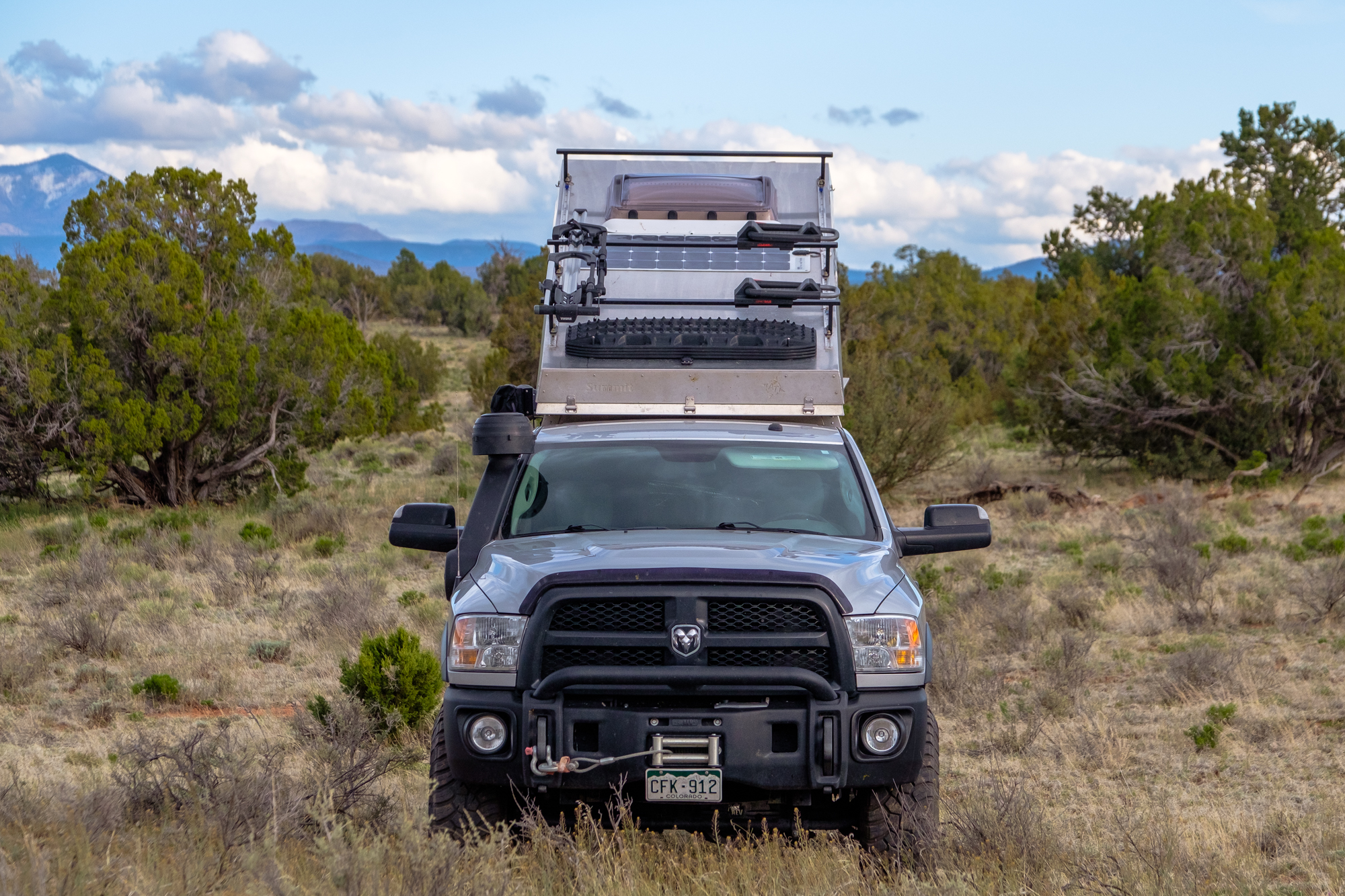
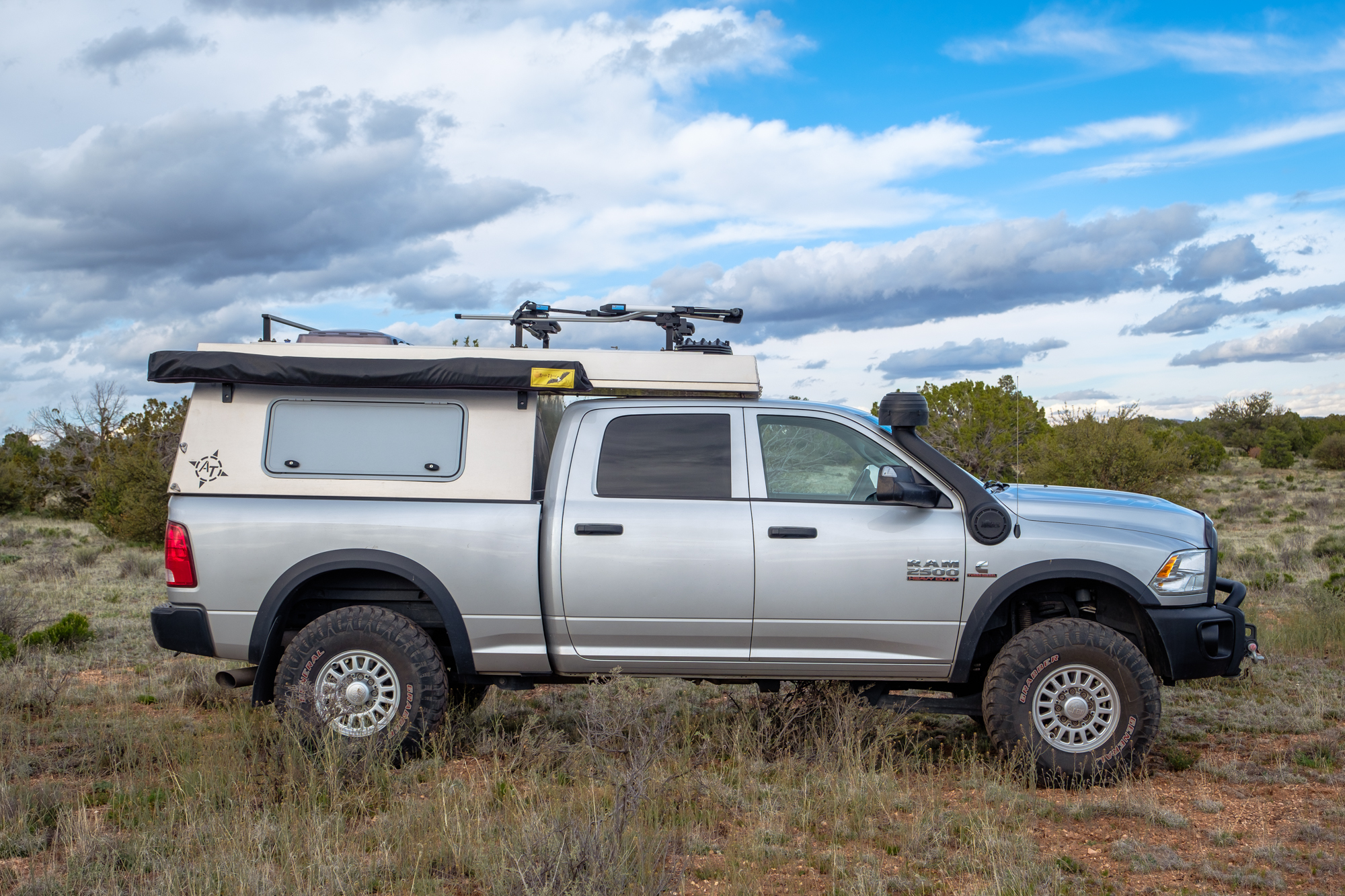
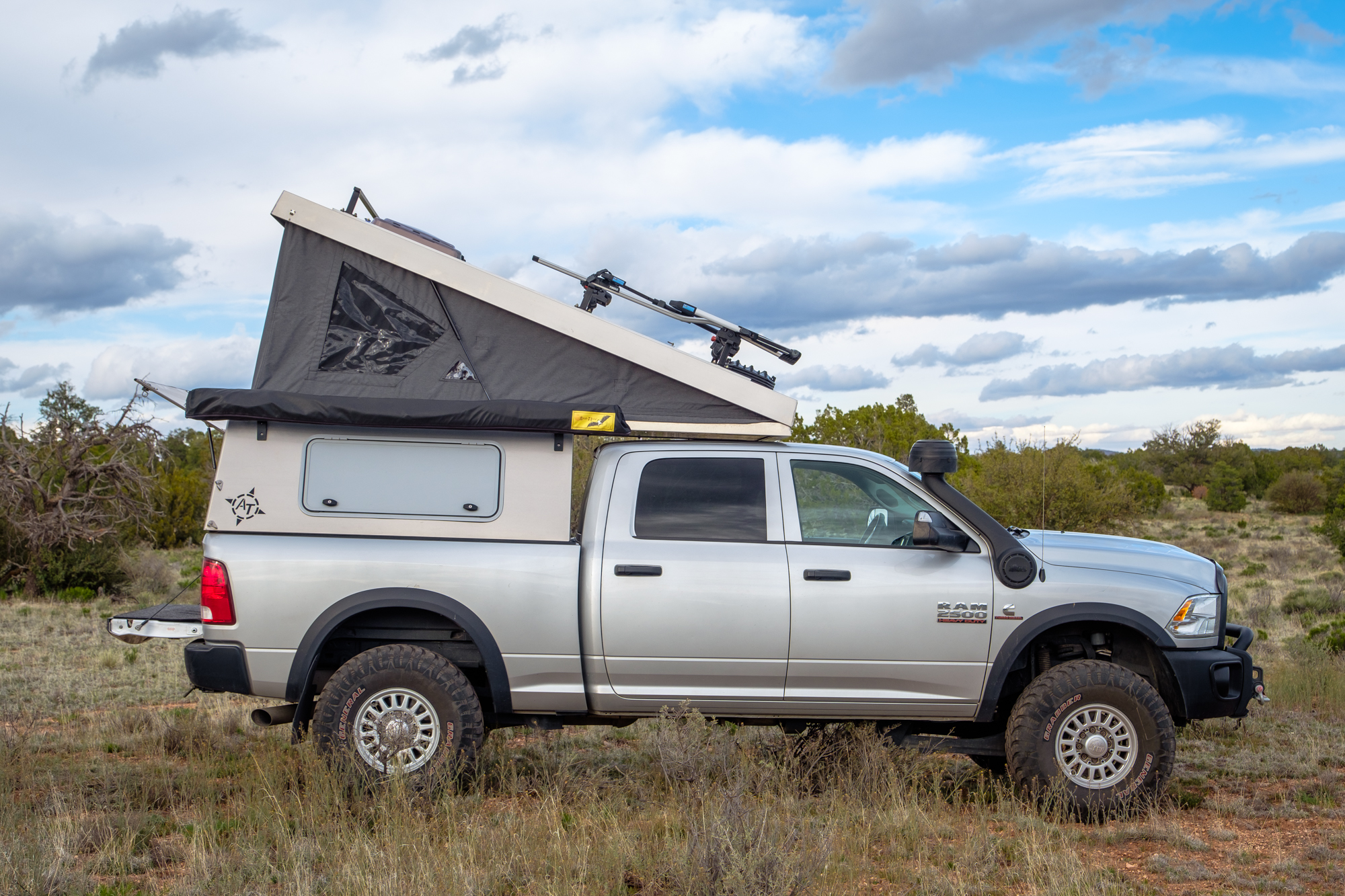
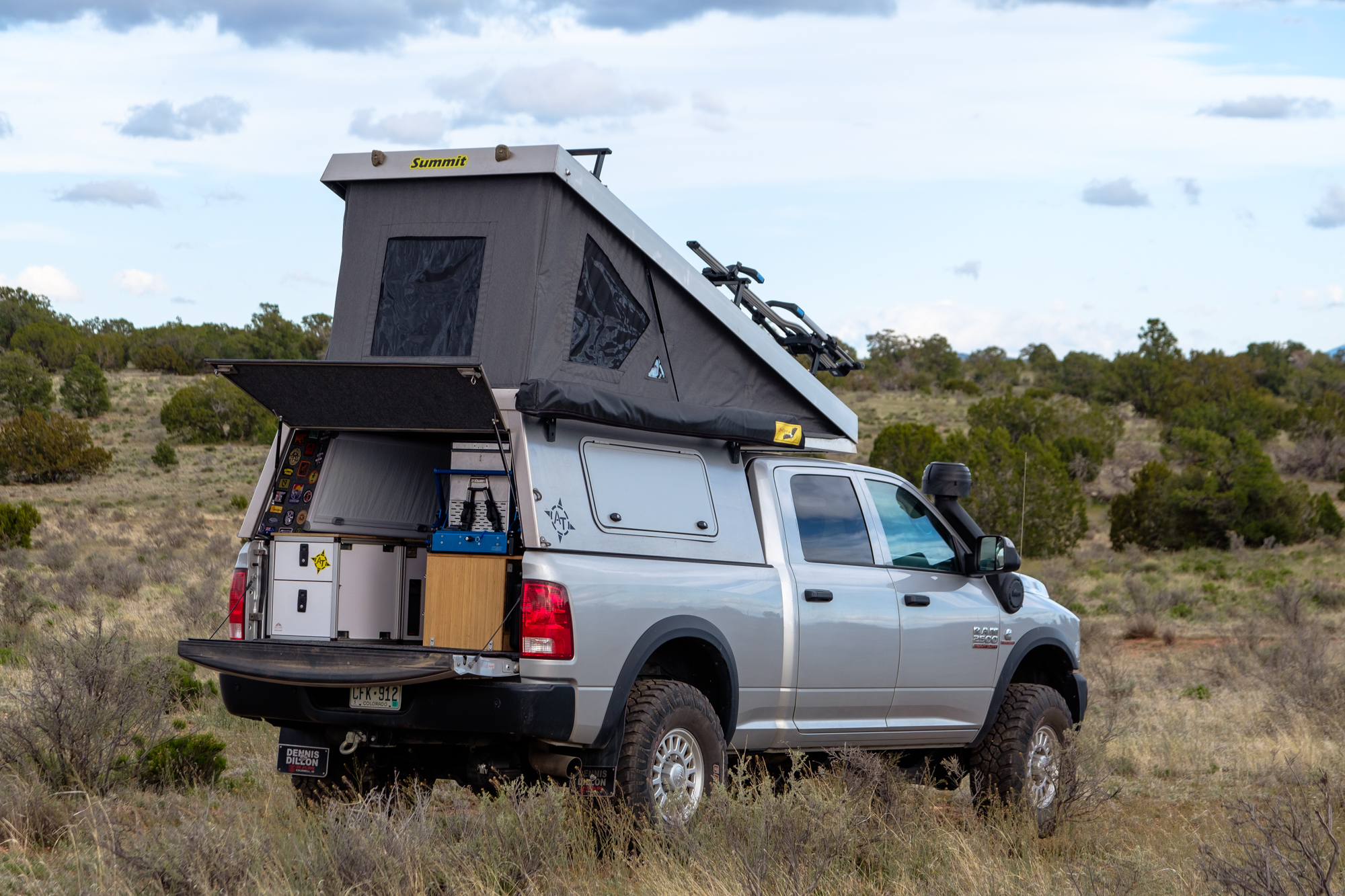
Inside you’ll find a 48 x 80-inch bed with one of the most comfortable mattresses of the test; it easily lifts up thanks to two gas struts, clearing the way for a spacious living quarters below, and we do mean living quarters. The interior can be equipped with so many options that it will practically feel like home. There are lighting and electronics packages, interior storage systems, kitchen systems, and even an optional toilet. You can add a skylight panel that opens up to give you a view of the stars, includes a bug screen, and features integrated lighting for the cabin, or a forced air heating system which pairs with the insulation package to deliver year-round comfort. The shell can be left in raw aluminum coated in Sharkhide to prevent corrosion or painted to match the truck, and the walls come carpeted as standard for a soft touch and additional insulation. I should note that while I love the look and feel of the carpeted interior, I can only imagine what it must be like to clean it after a German shepherd or malamute runs through it.
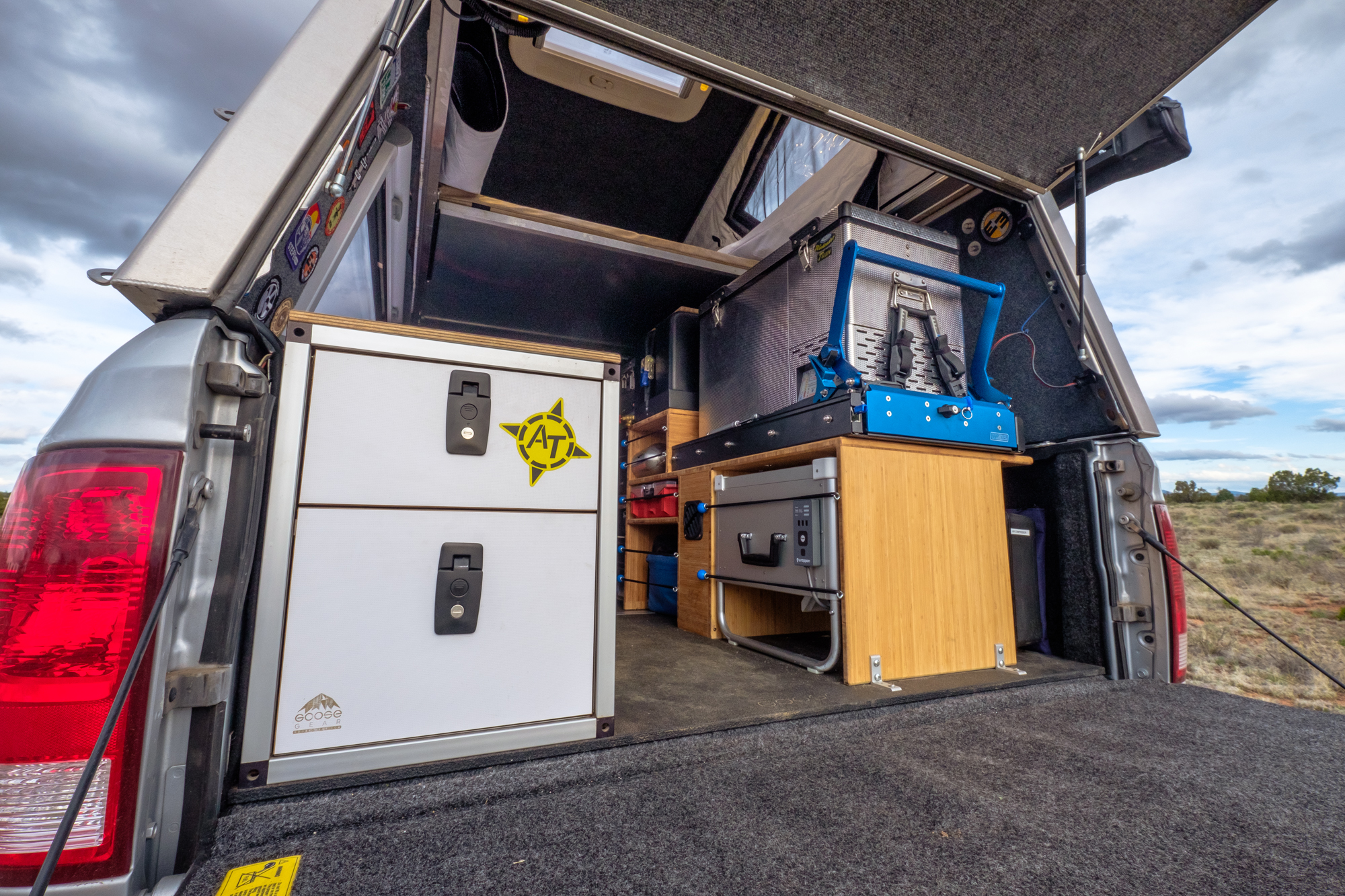

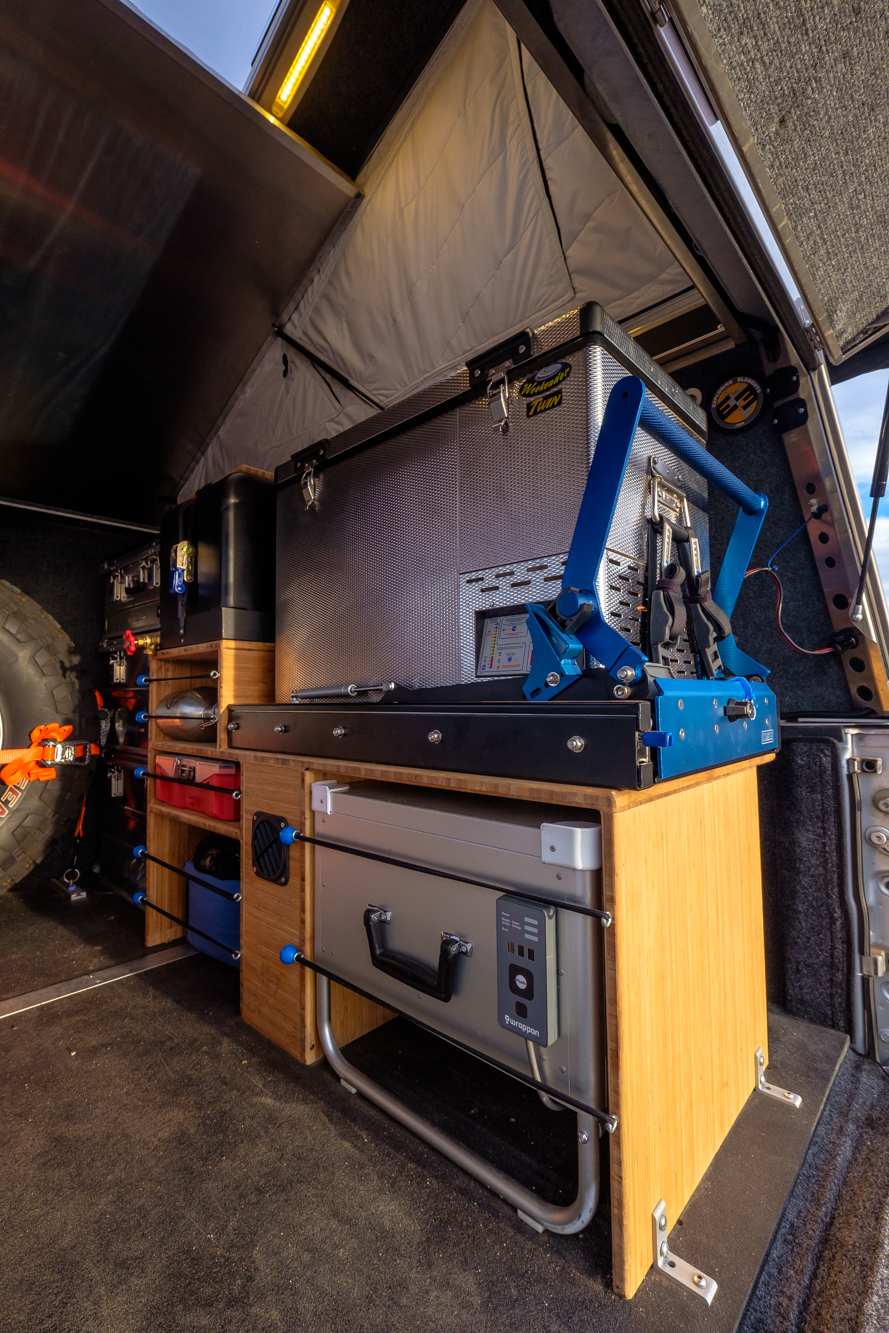

Setting up and breaking down the Summit is a quick task, with times near the lower end of our results. With one person, setup took just 18 seconds, while breakdown from start to finish took 37 seconds.
The Summit fell short in two ways. First, some of the interior edges on the raw aluminum shell were sharp. I felt that more trim coverings or grinding were needed. My larger concern, and the reason why this is only my Editor’s Choice for mid-size trucks, is the slant in the walls on full-size models. Because the Summit shares a single bed size between mid-size and full-size trucks, the full-size shell must slope in from the edges of the truck bed to the actual bed up top. This creates a notable angle, which becomes a big issue if you plan to install an interior system with any sort of seating, as it forces you to lean forward instead of sitting upright against the wall. This isn’t a huge deal for short periods of time, but try working in the camper or hanging out for a few hours and it will become fatiguing.
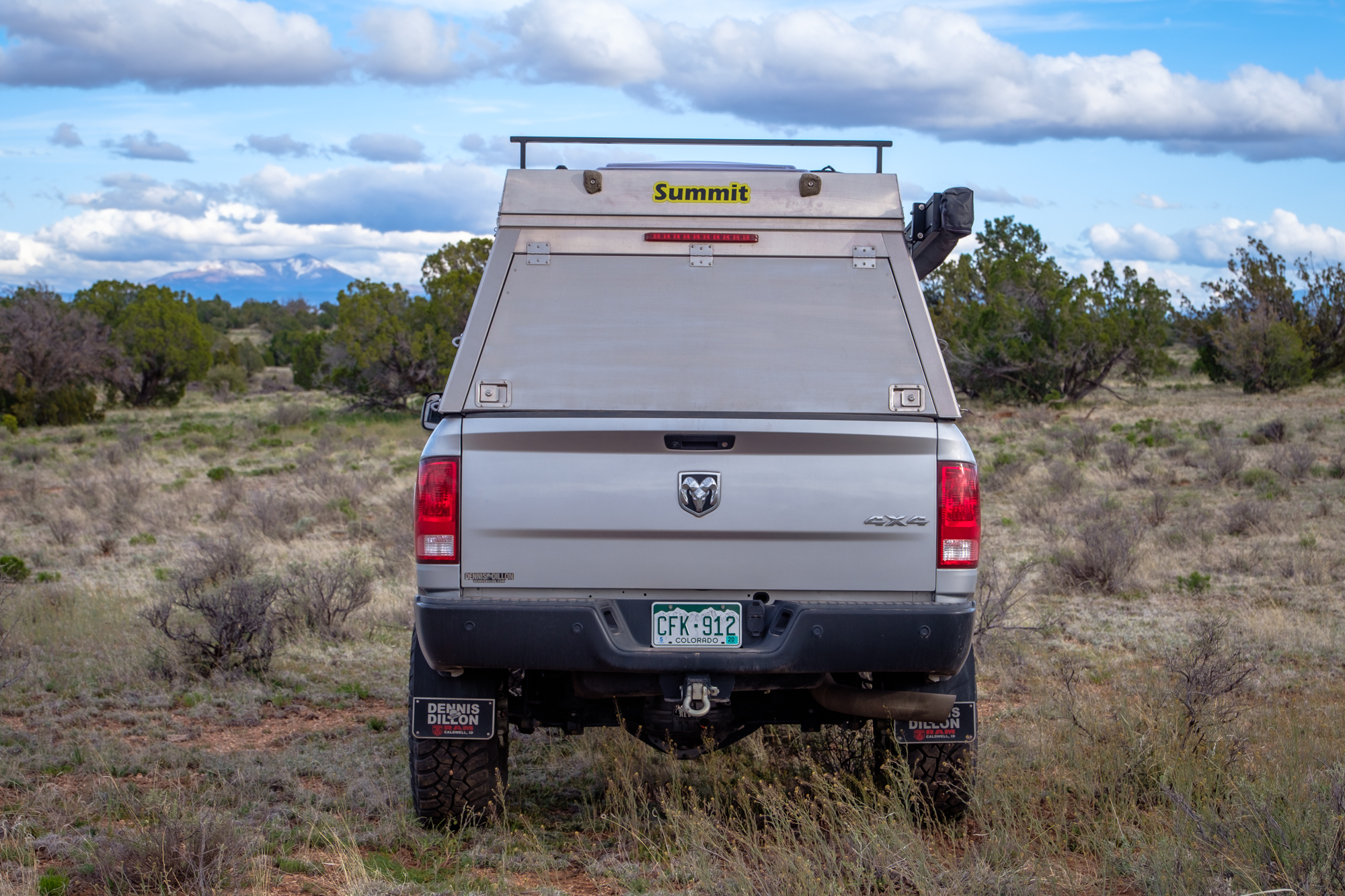
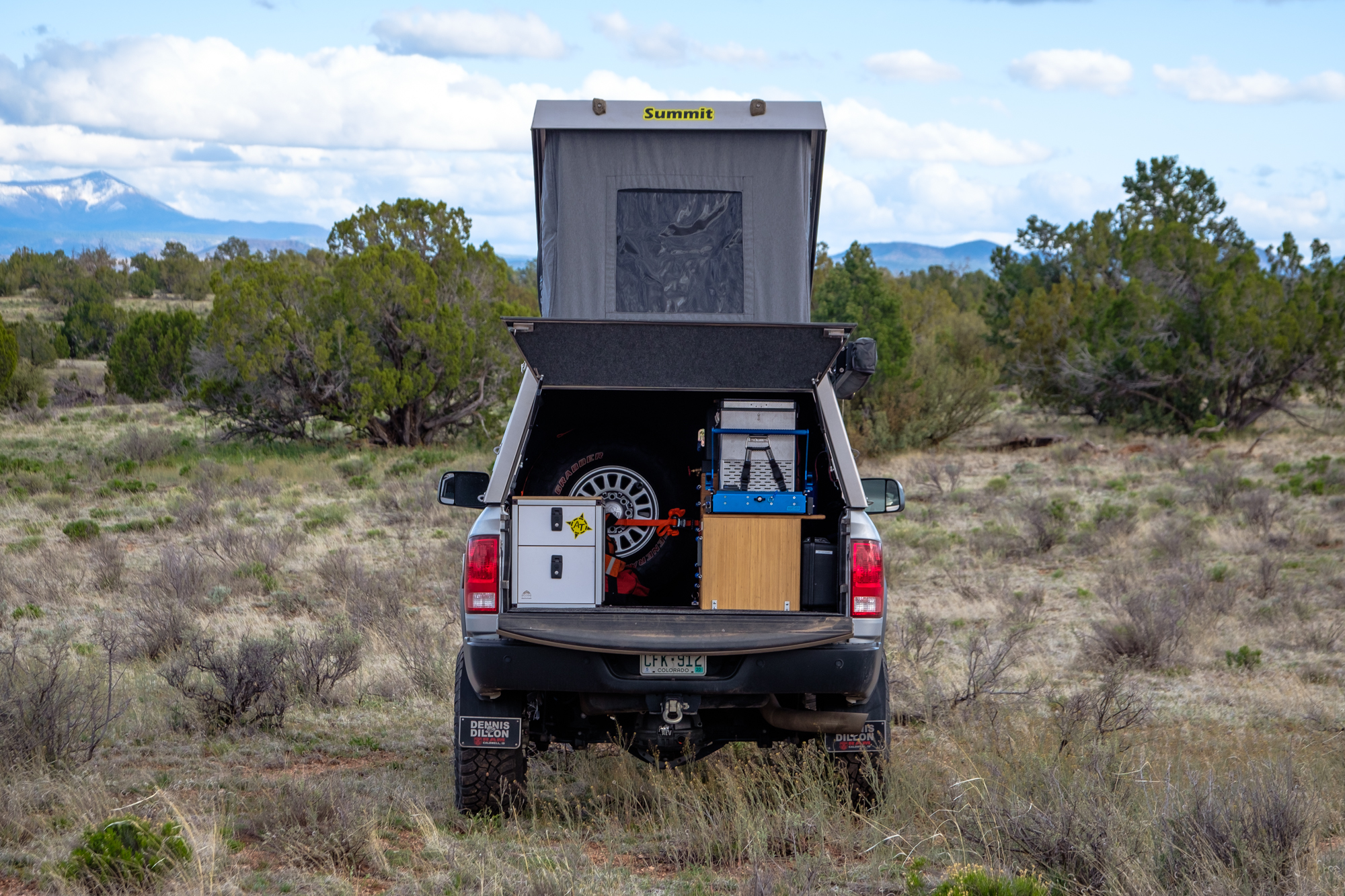
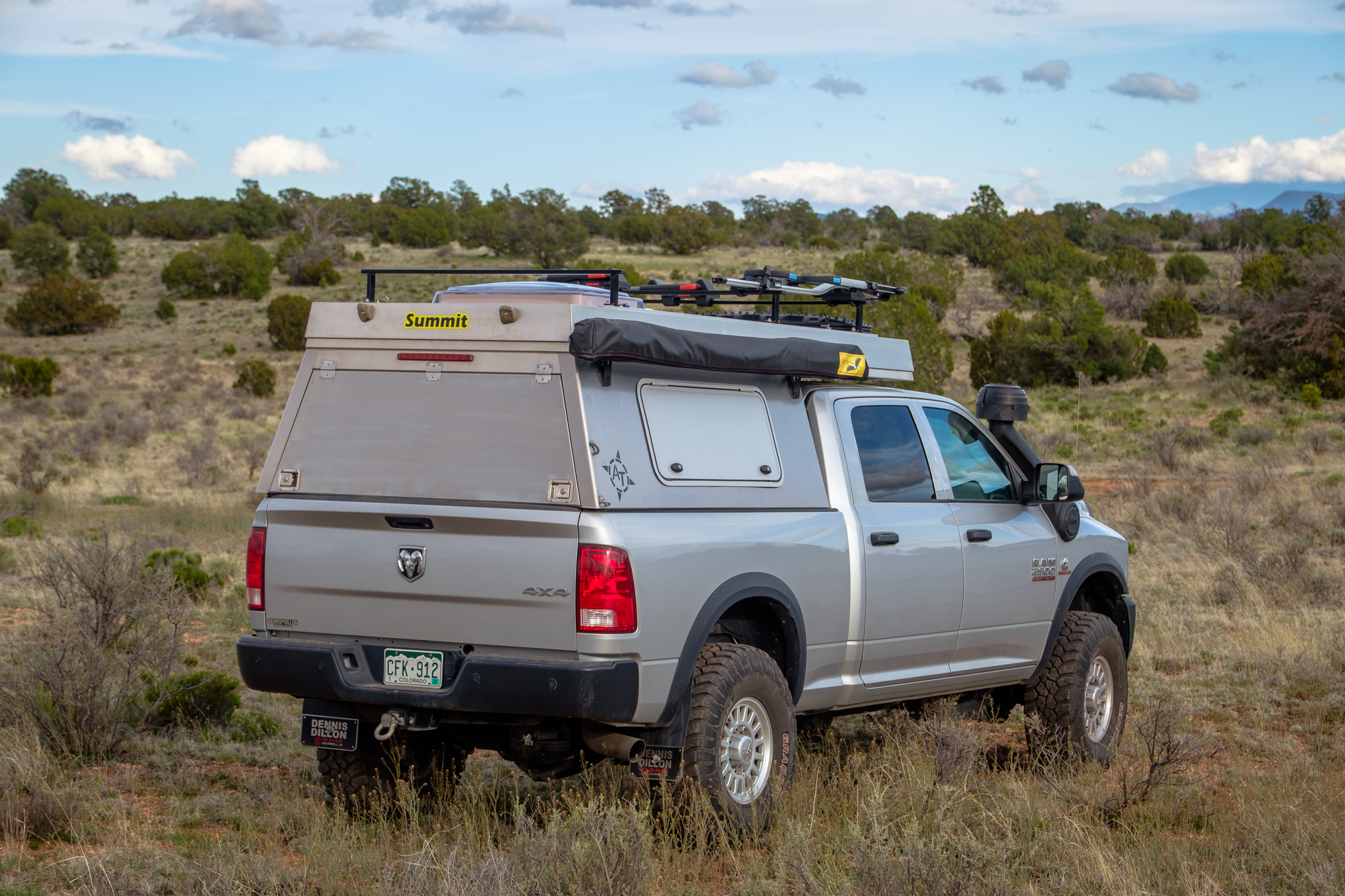
Pros
- High-quality tent and insulation
- Loads of options
- Comfortable mattress
- Better use of living space
Cons
- Some sharp edges and corners
- Single-size bed means walls are too slanted on full-size
GO FAST CAMPER | VALUE AWARD
Starting at $6,450

If the AT Overland Summit were a symphony, the Go Fast Camper is a rock concert. It’s a raw and honest take on a wedge that ditches the frills and conventions of the industry in a stunning display of function and design. You see everything, from the billet aluminum tent frame to the CNC-machined corners and welded DOM tube space frame. There’s no carpet covering the walls or recessed paneling to hide the wiring, no fantastic fans or fancy skylights. What you see is what you get, and that’s a whole lot more than you might think.

It’s well known that GFCs are priced more affordable than other wedge campers, but most people don’t realize just how much more affordable they are. For $6,450, you receive a fully painted and assembled camper with operable side panels and your choice of several standardized powder coat colors. To spec a competing camper with those same options, you’re looking at roughly $10,000 to $12,000, or nearly double the price.
Despite the reasonable cost, the company doesn’t skimp on materials or construction methods, and each camper is made in Bozeman, Montana. The tubular space frames are built to be as light and strong as possible, the roof and floor are made from a honeycomb composite, and the majority of the remaining components are machined from billet aluminum. Even the tents are heat pressed and sewn together by GFC employees using a 600D polyester fabric coated with polyurethane. This begs the question of how the product can still be so reasonable in price if these tents aren’t built “cheaply.”
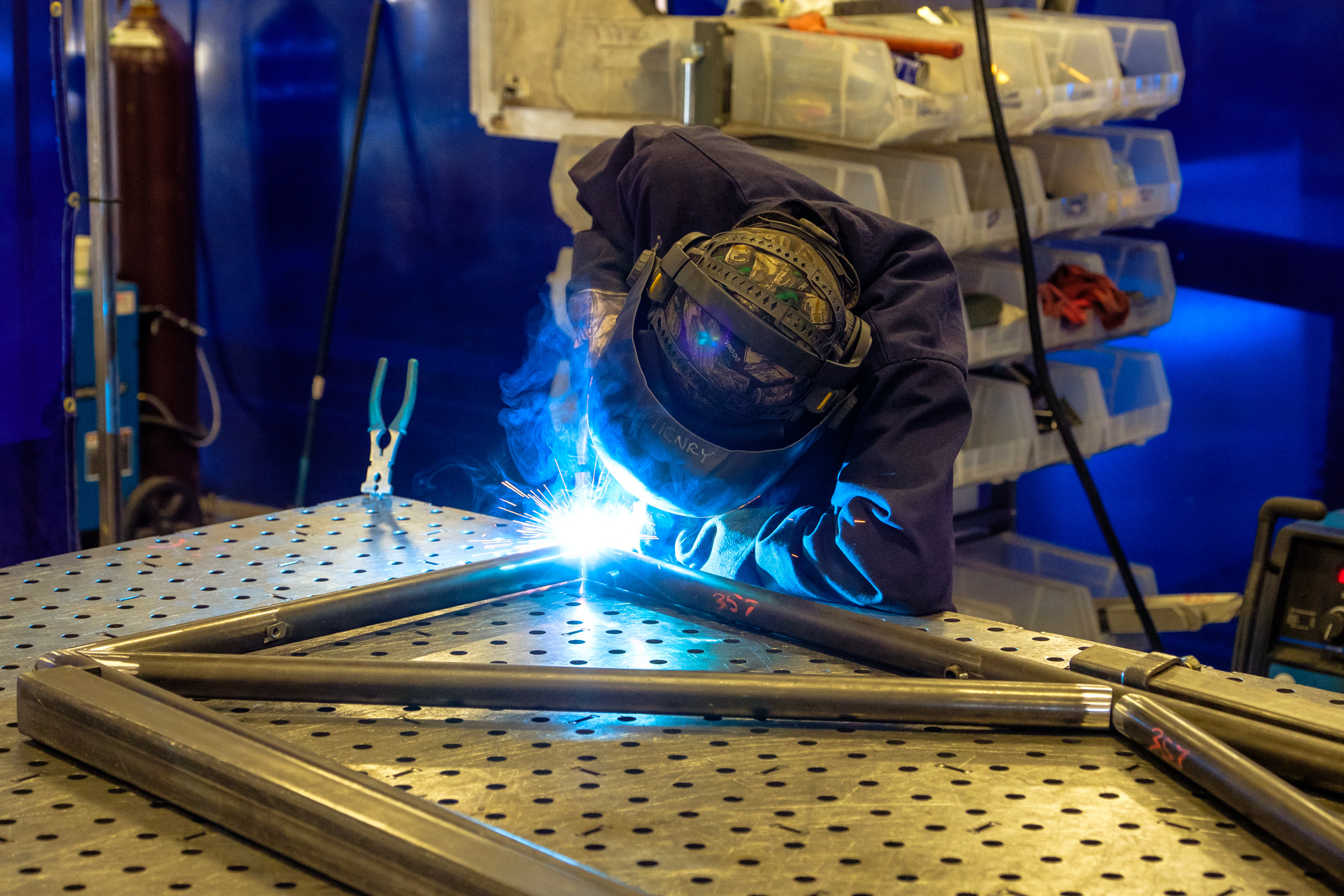
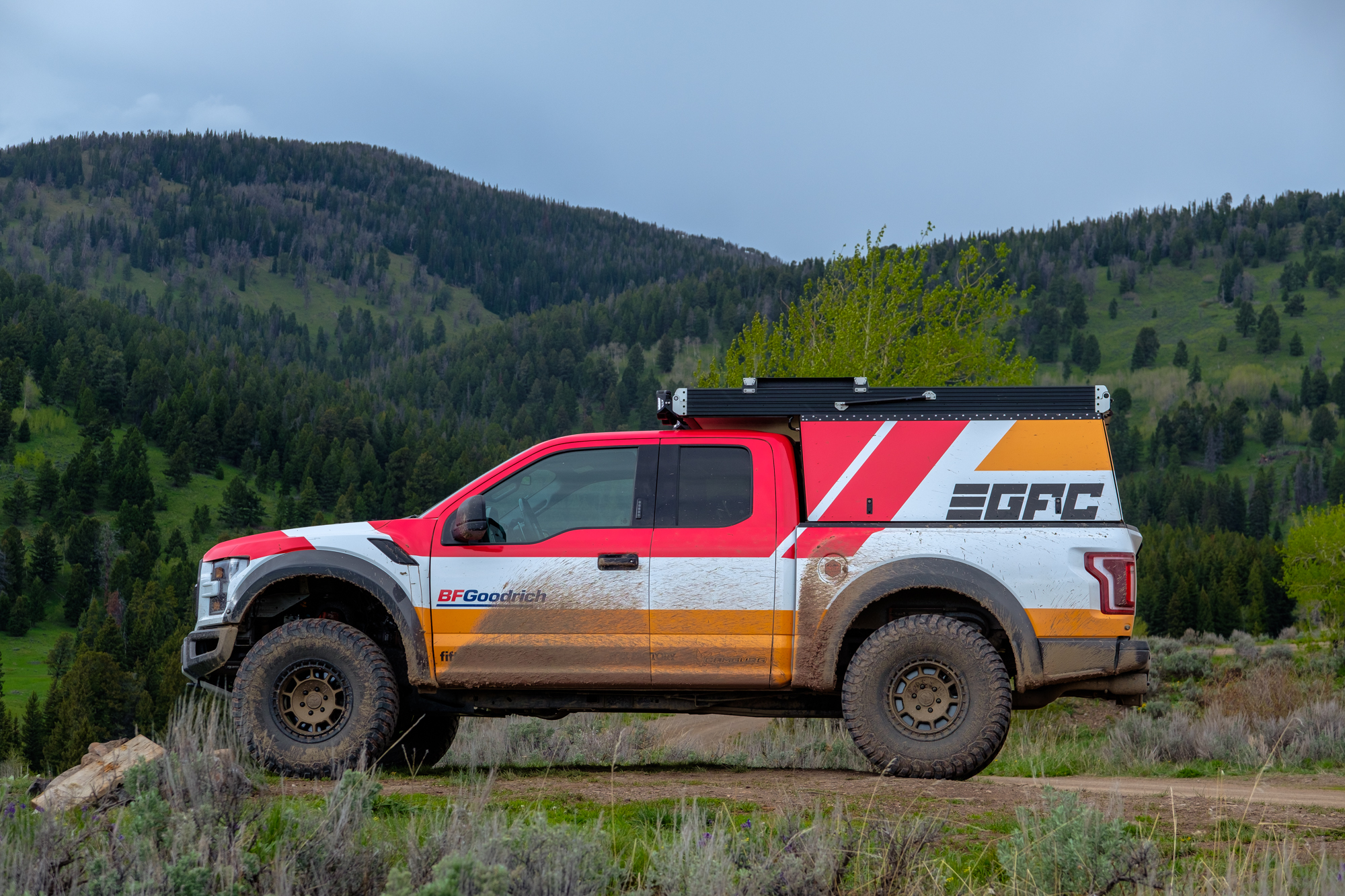
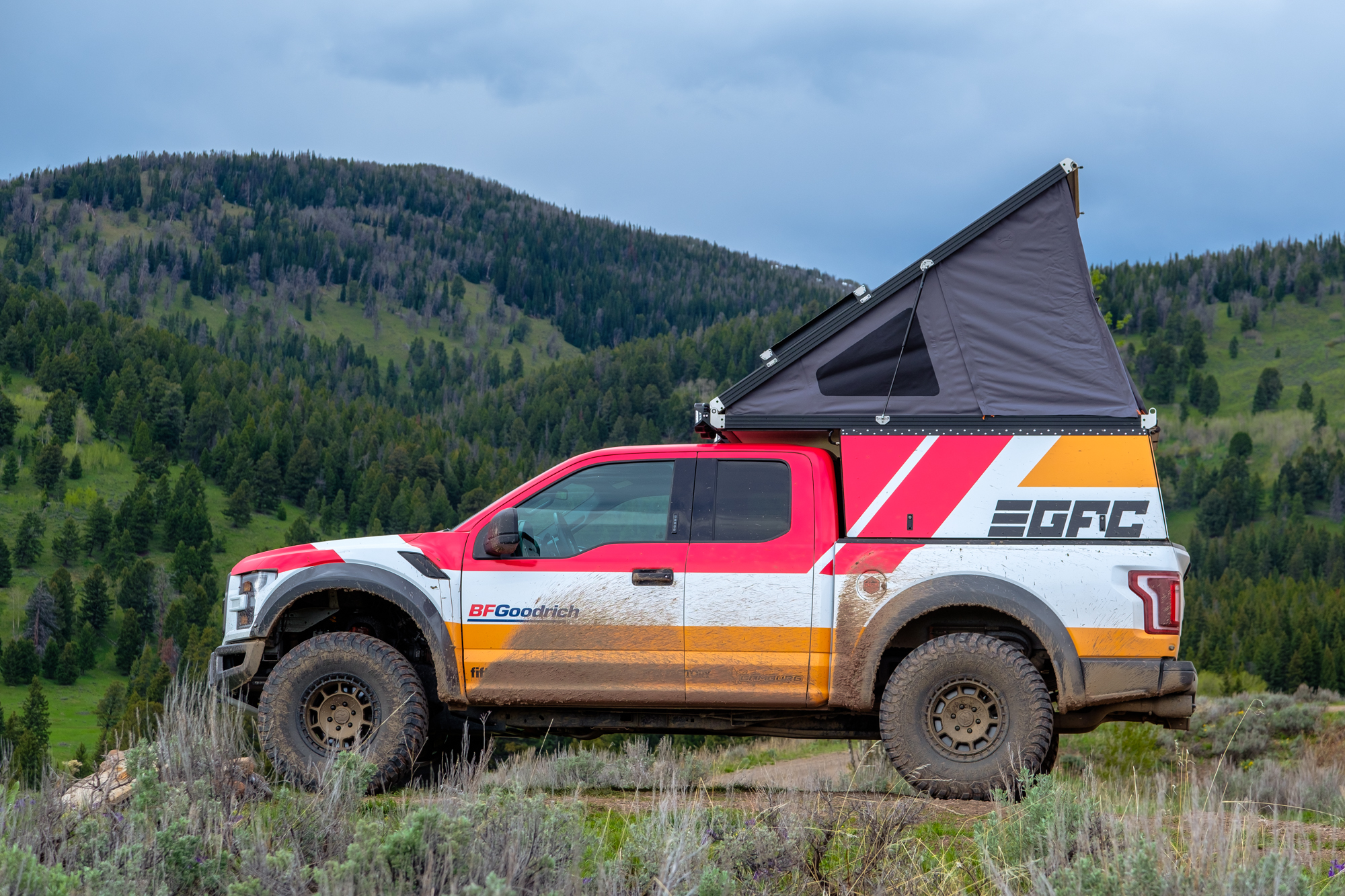
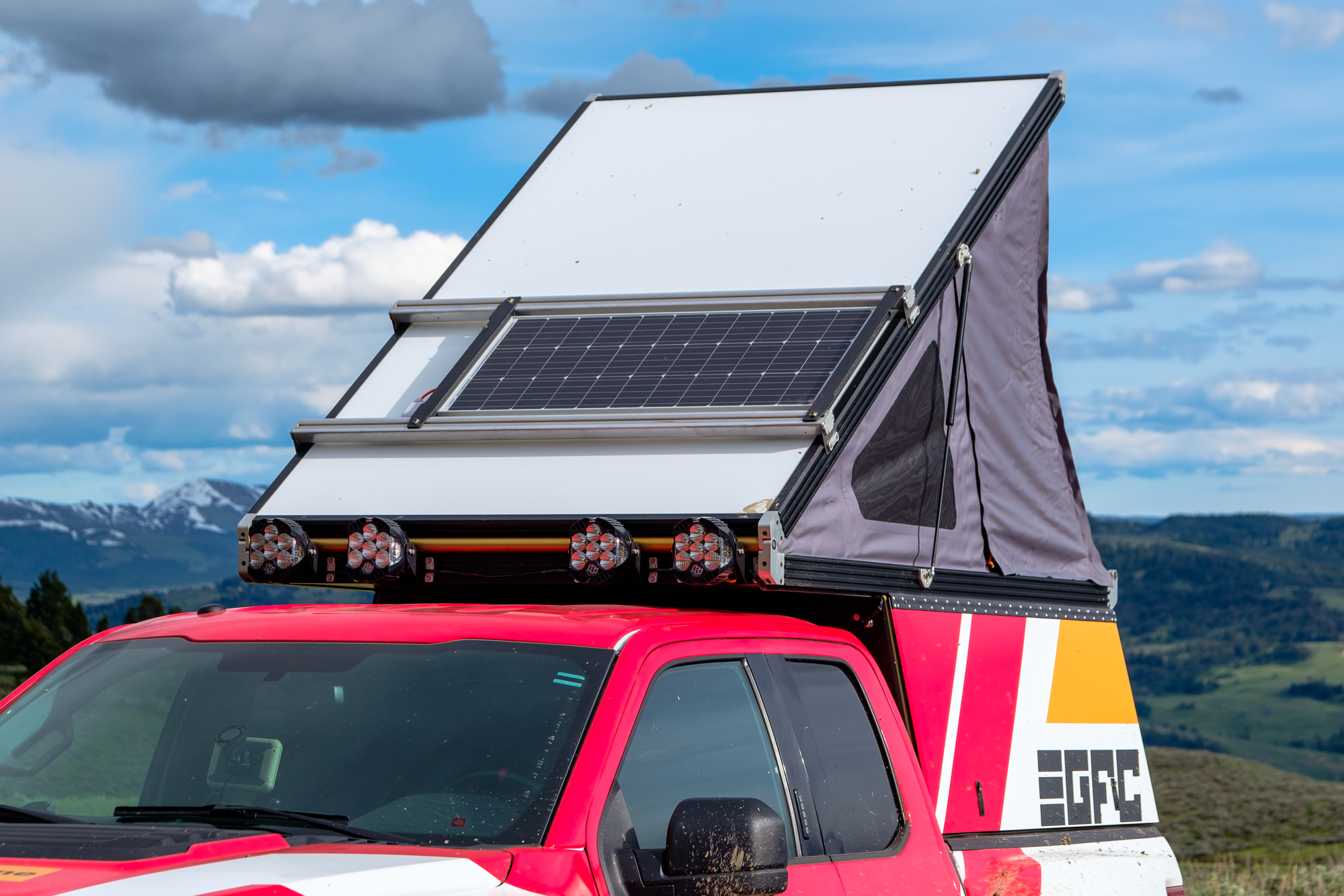
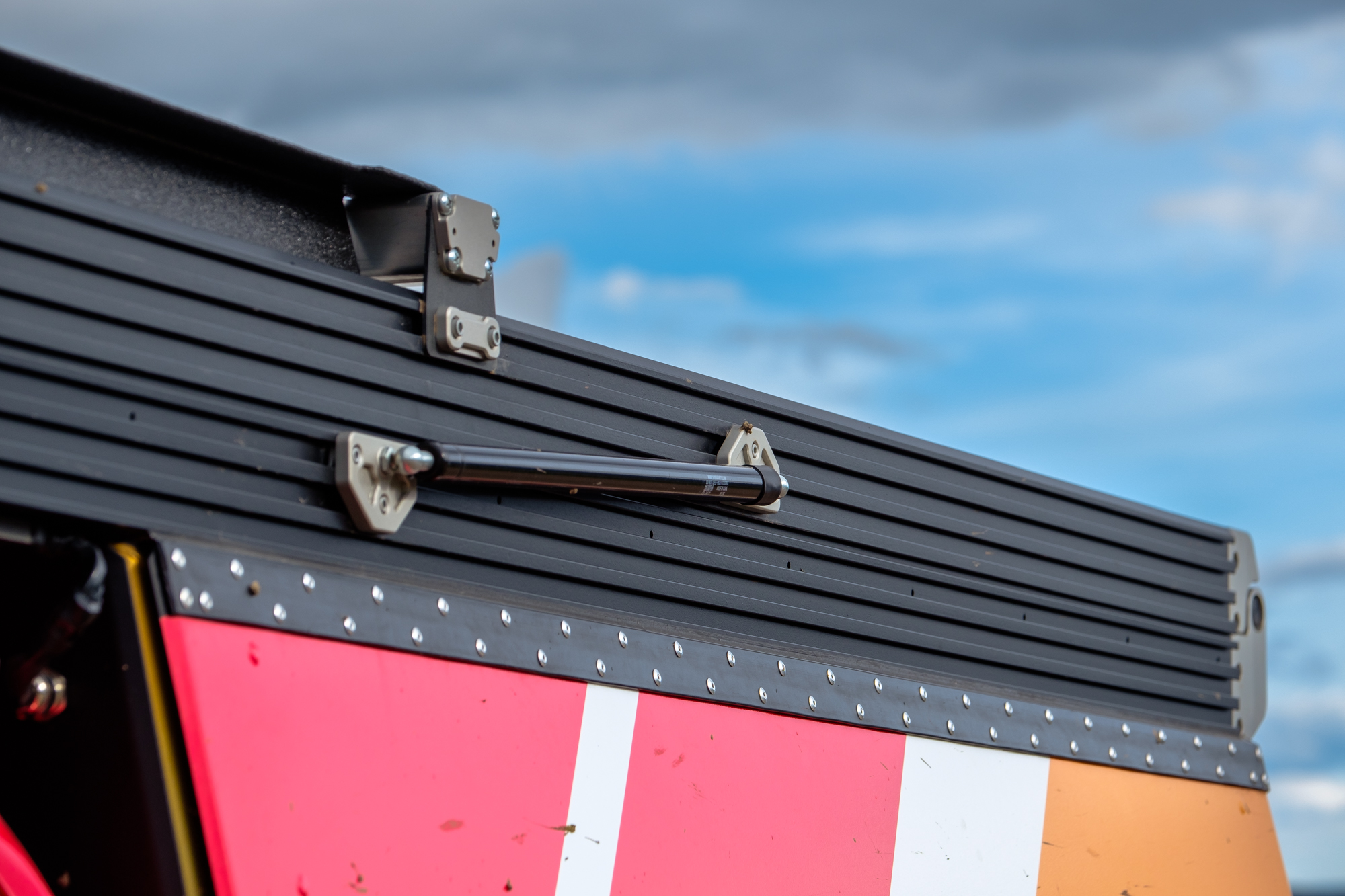
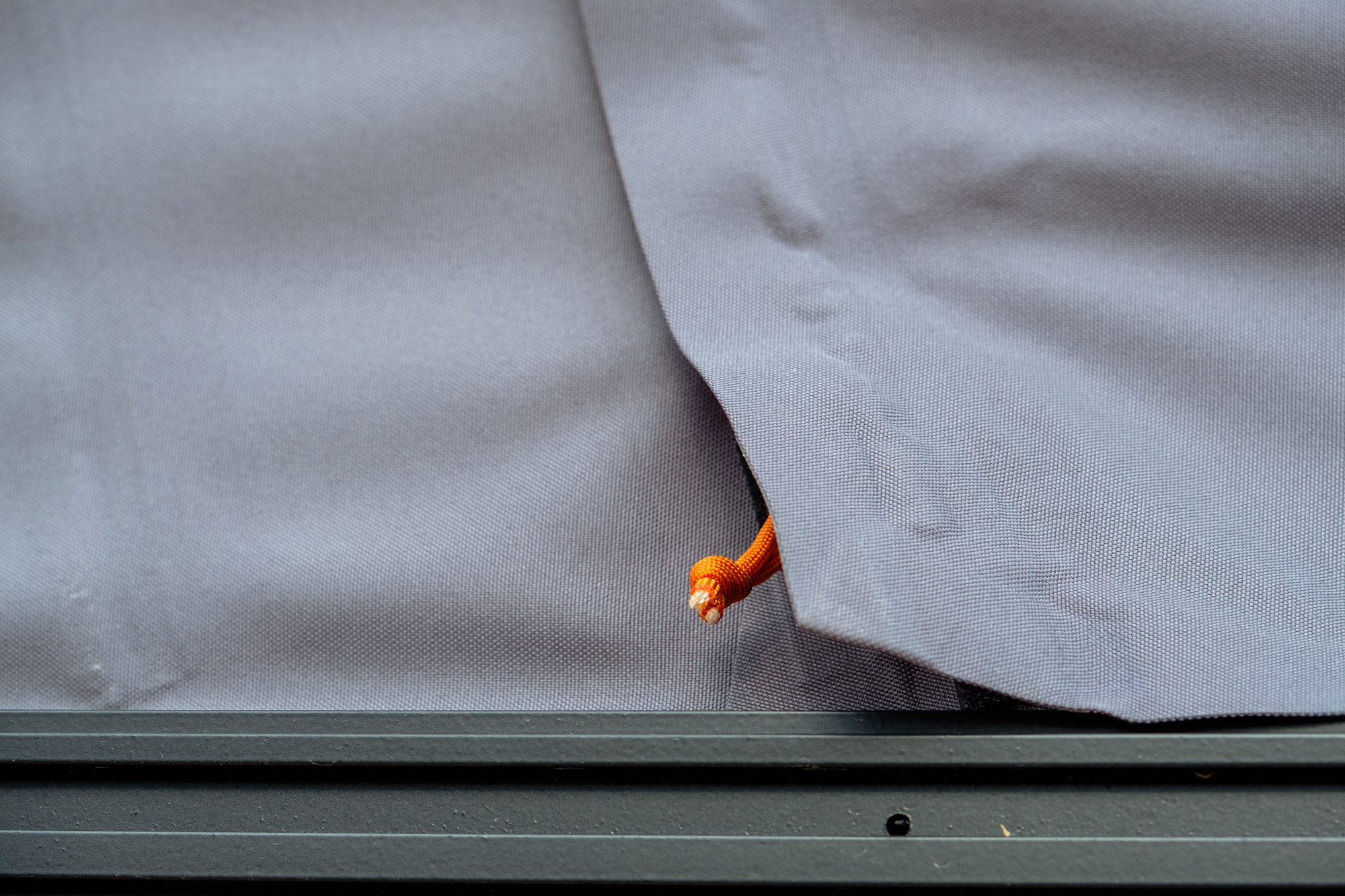
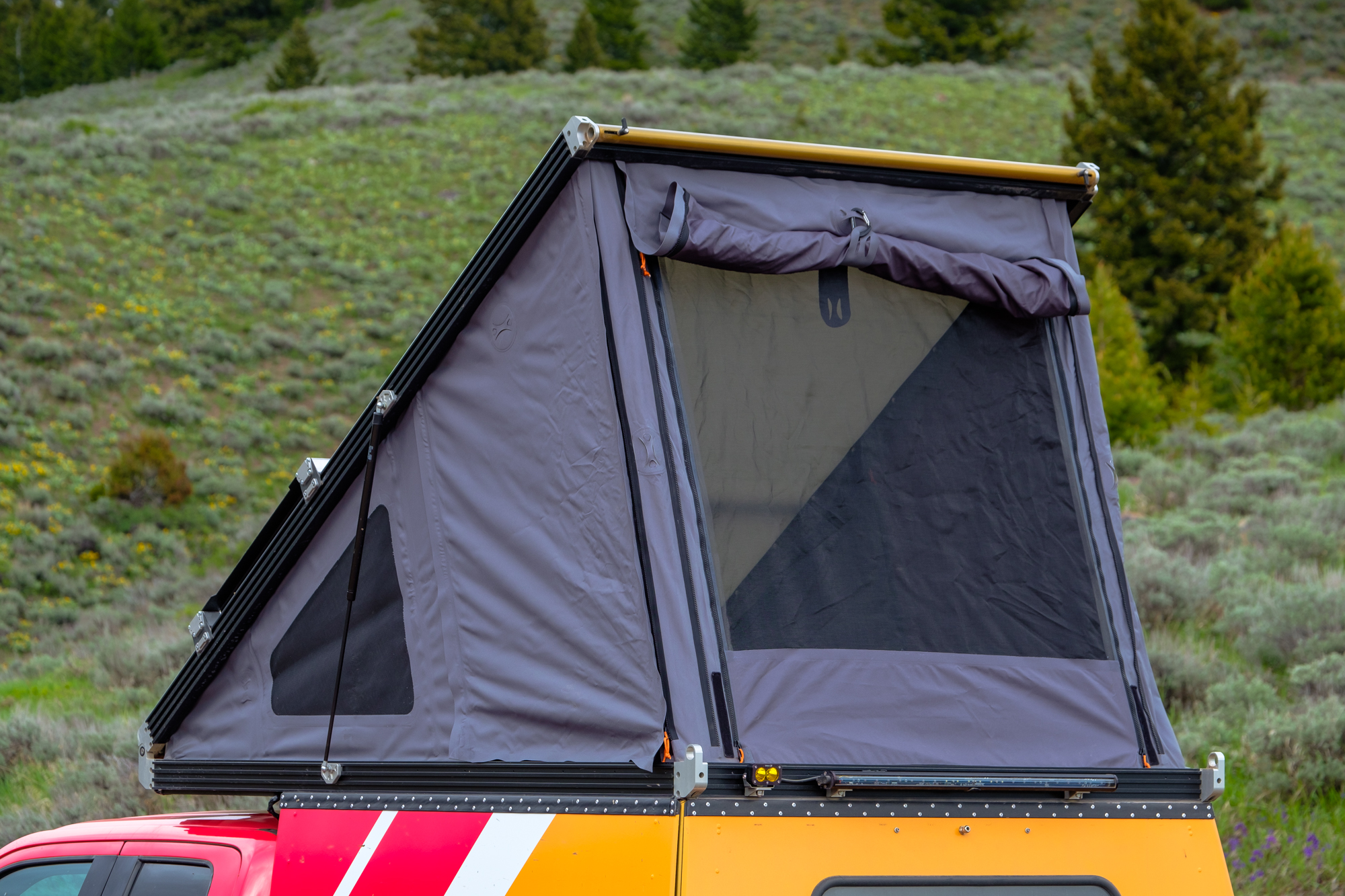
It turns out GFC has a secret weapon, one you might not expect such a small business to possess: robots. Cue the sci-fi music. By using automated production systems to work through the night, GFC has been able to take advantage of economies of scale by producing more campers to lower the overall price, a savings which they pass on to the consumer.
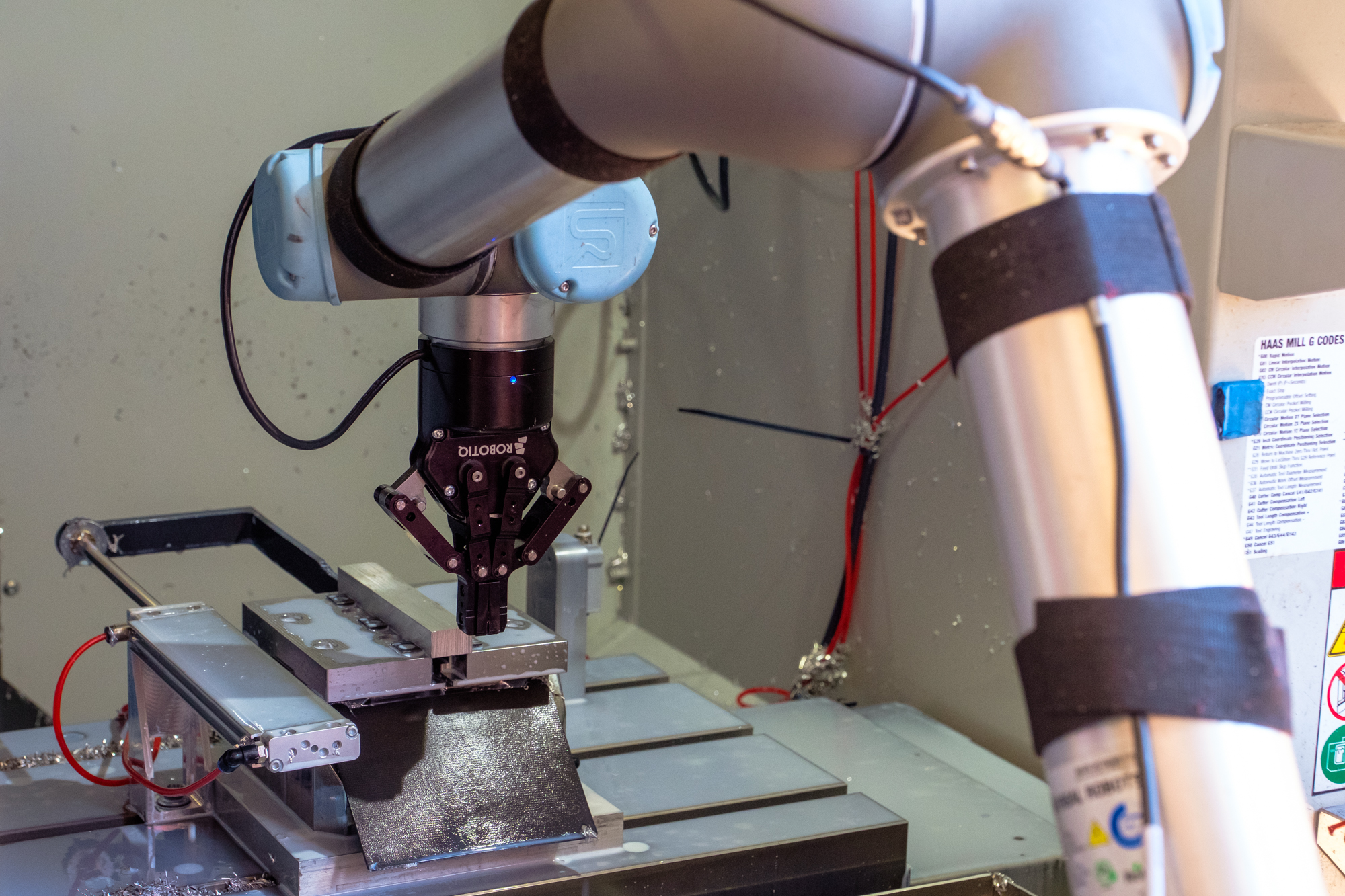
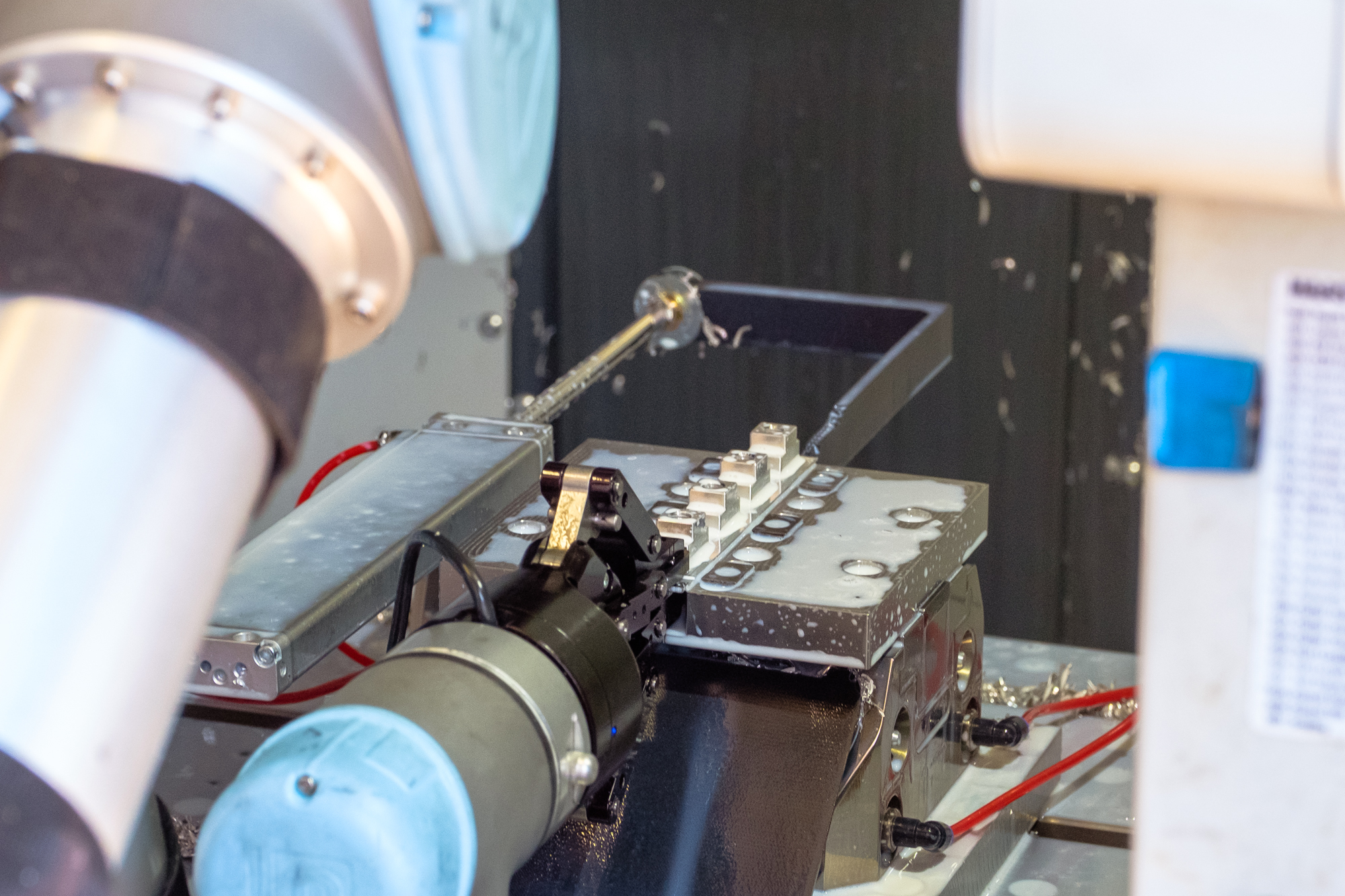
But GFCs are more than just durable and affordable, they’re also practical thanks to full- length opening side panels which provide unequaled access to the bed with the security of a truck cap. The tent frame also includes T-slots down the side for mounting a roof rack which can support up to 500 pounds of whatever cargo your heart desires, from lumber to piping.
Setup and breakdown were a breeze, achieving the fastest times of any camper in the test, just 15 seconds for setup, and 35 seconds for breakdown, though the owner topped our breakdown time with a blistering 21 seconds.
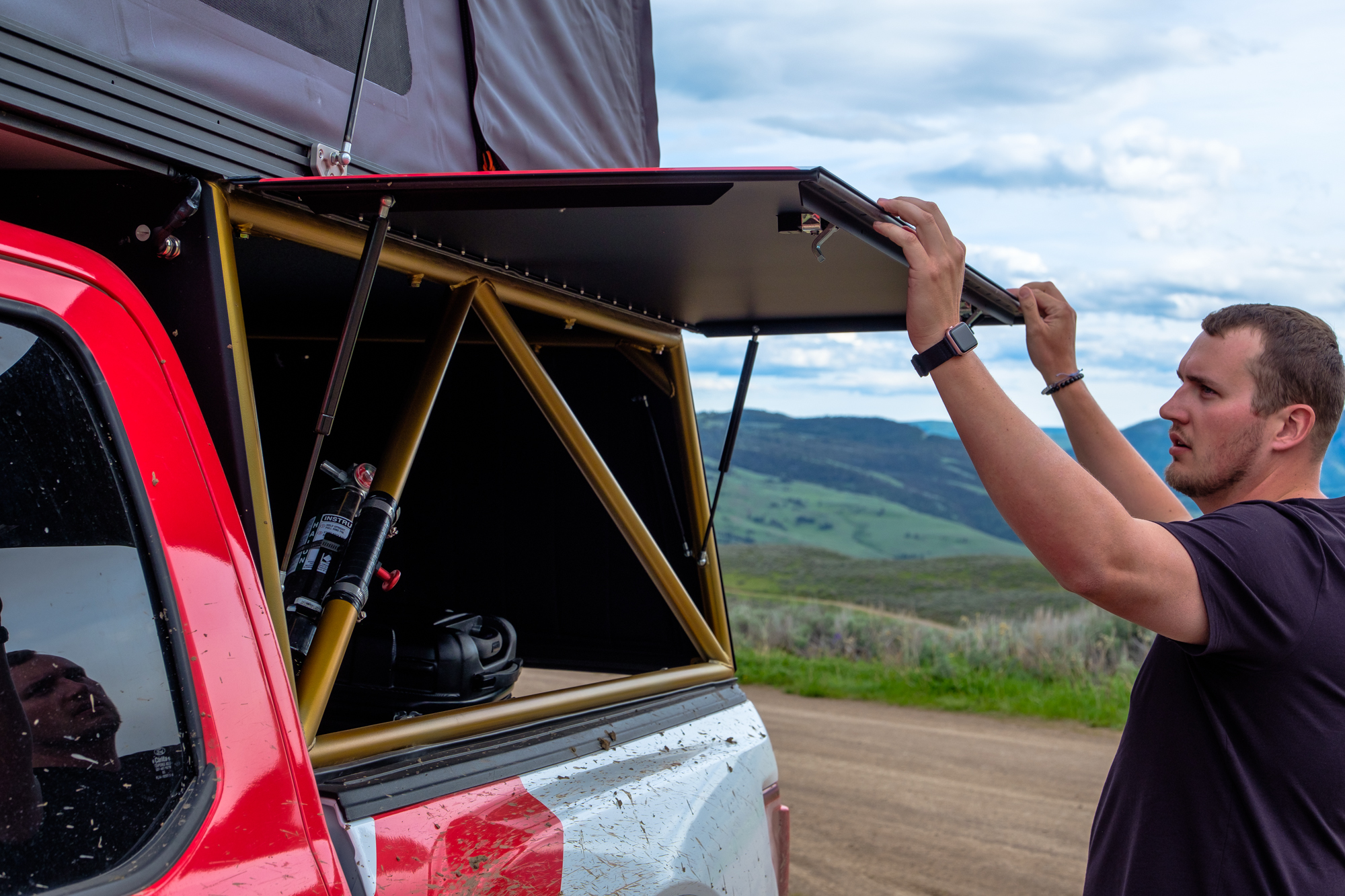
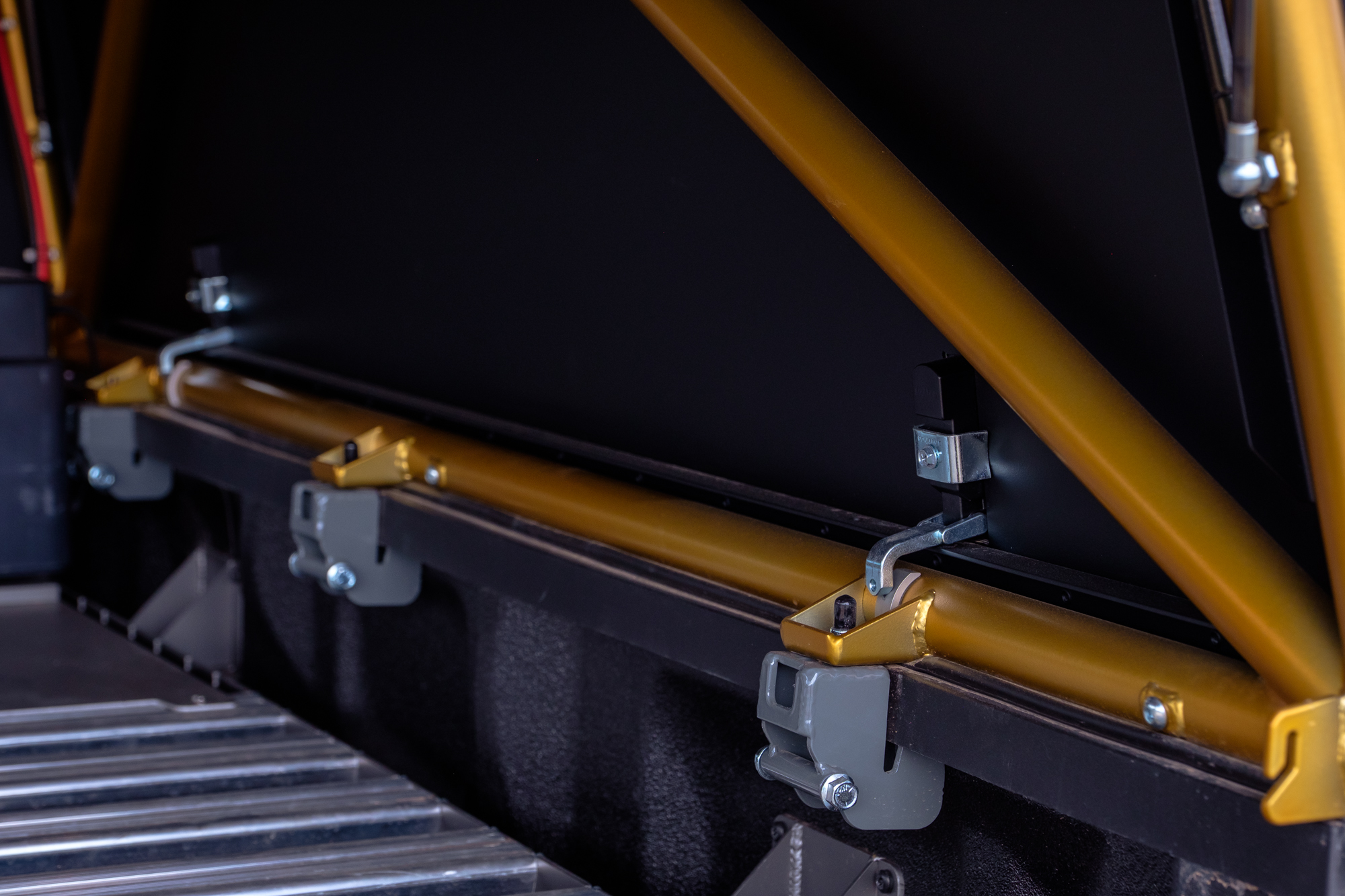
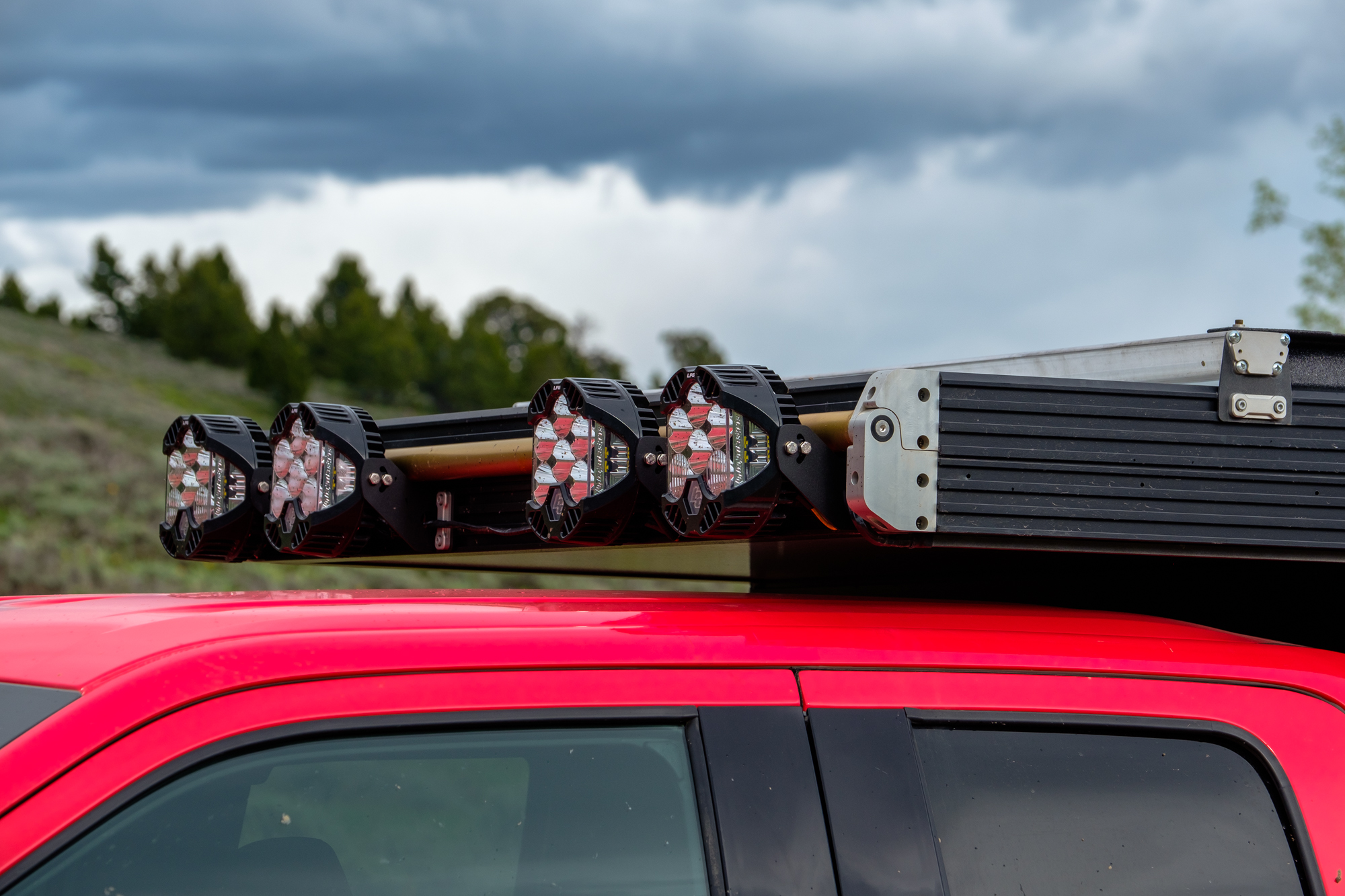
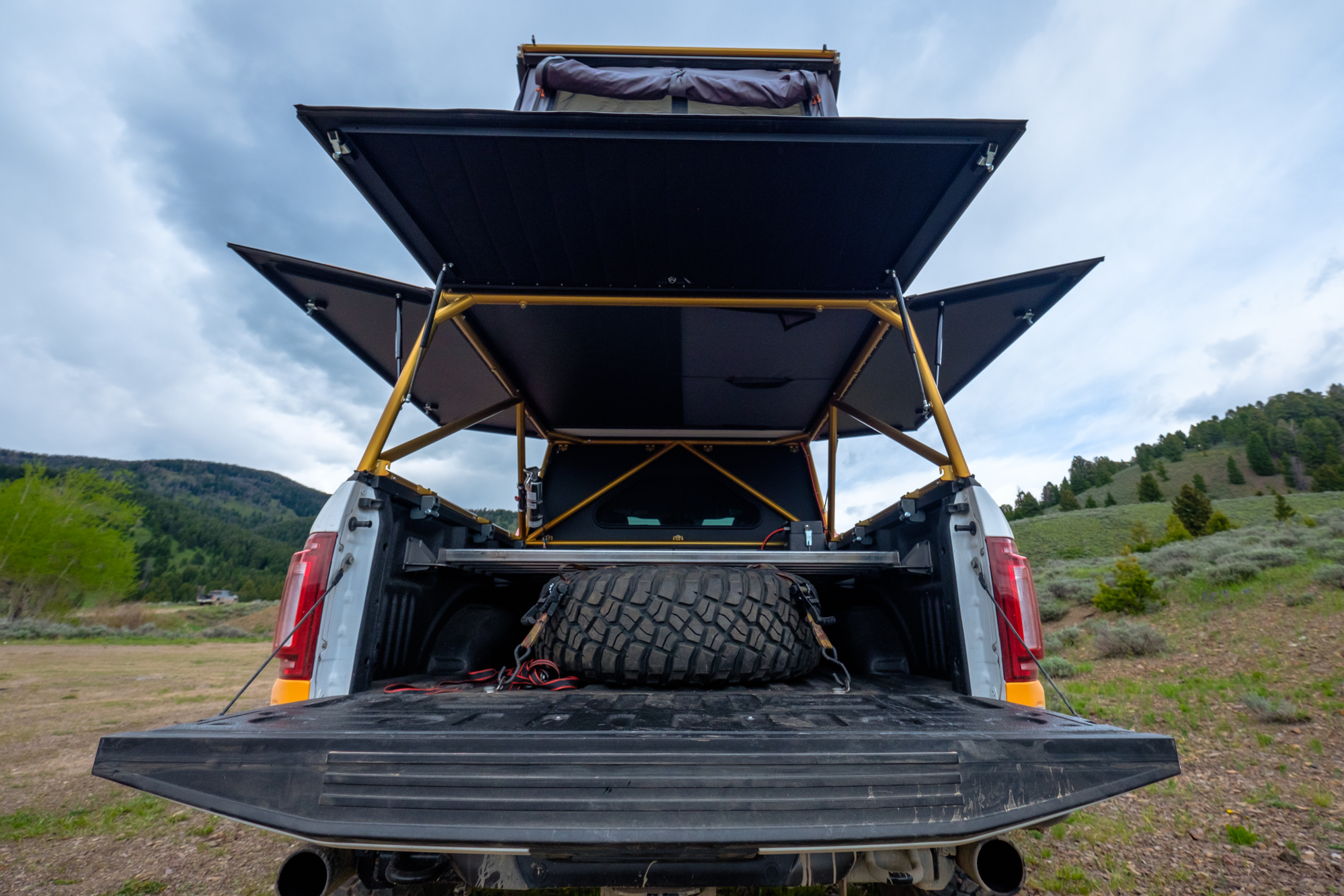
Inside there’s more to love, such as the way the composite roof lets a dull white light through in the mornings or the convenient welded pockets for your phone and keys on the tent. The new tent, the one tested here, features an optional large zipper window which doubles as an external entrance, carabiners which secure the rolled-up windows when open, and zippers that were burly and oversized to handle the stress of extended use outdoors. Combine that with a look and feel that stole my heart, and GFC’s camper was well on its way to becoming my favorite—yet other factors fell short.
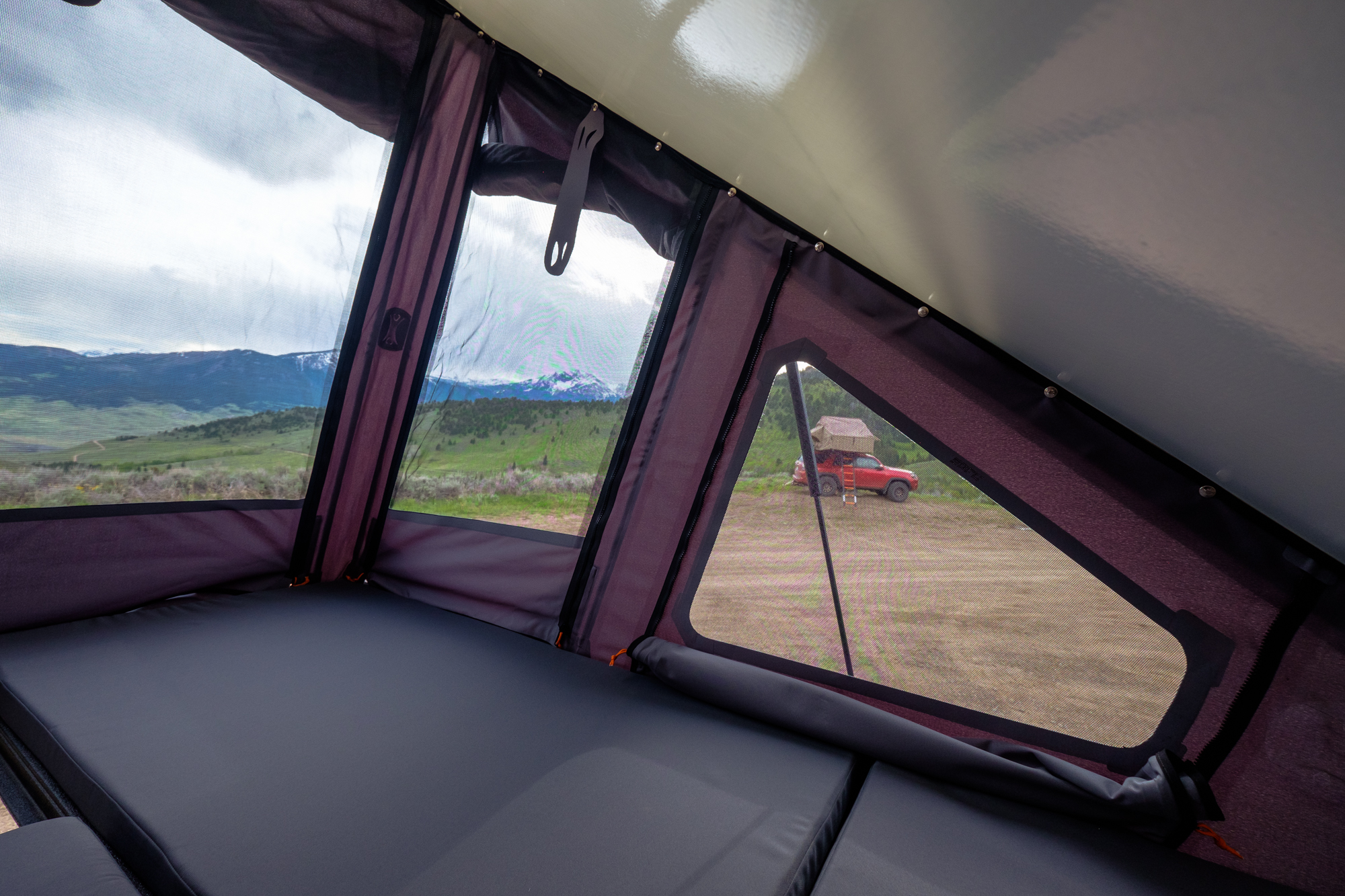
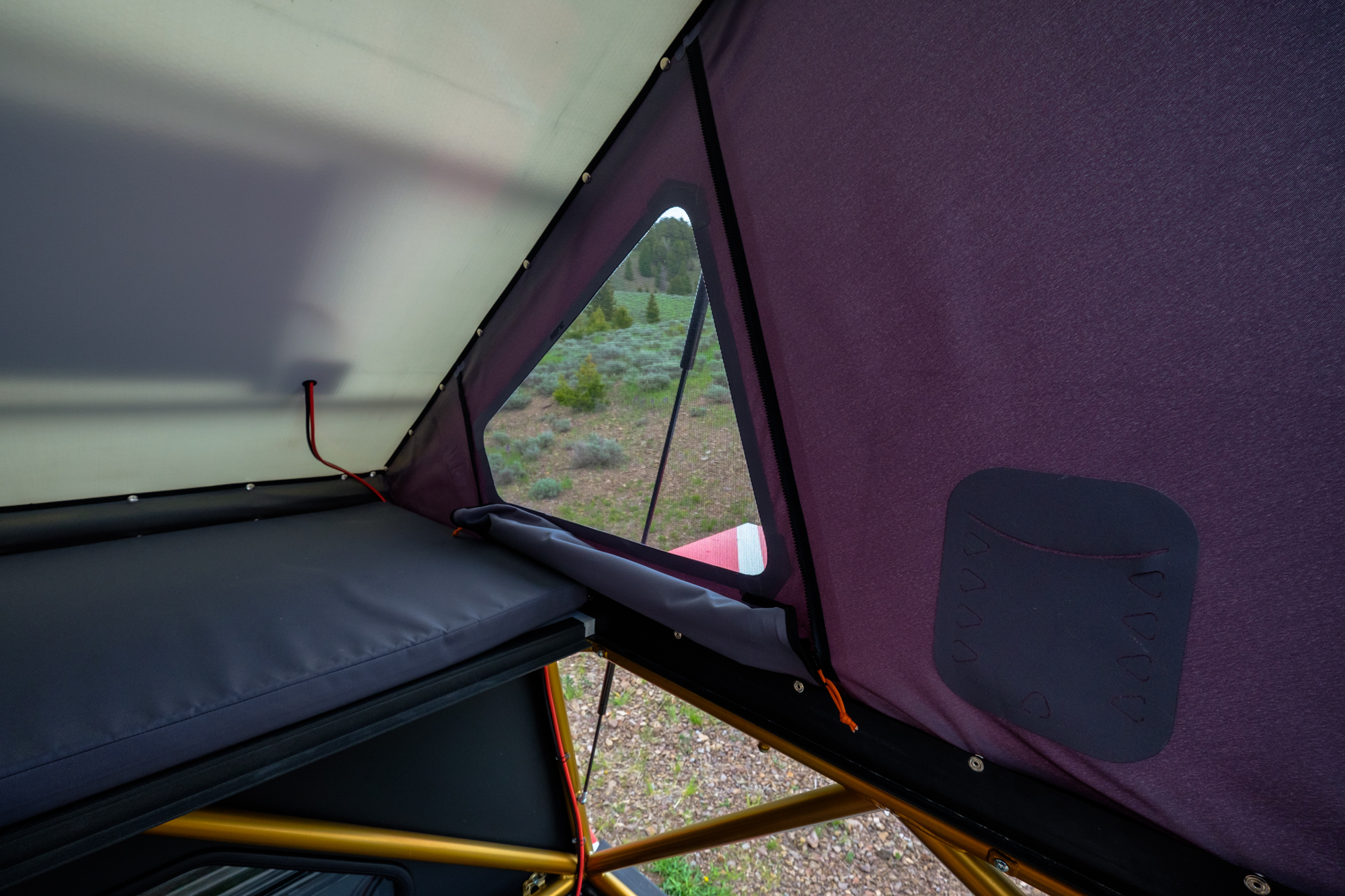
The first was the mattress. Although I’ve been told the 3-inch version was more comfortable, GFC recently switched to a 2-inch variant to make closing the top with bedding inside easier, and I found it to be much too firm.
Instead of using a keder track or similar method to prevent water and dust incursion, GFC used a rain gutter system and buttons to snap the tent into place. This has advantages like improved ventilation and easier removal or installation, and we found no signs of water ingress until we flooded the gutters with a hose. But I didn’t love that there was still a chance for water or dust to seep in, regardless of how slim that chance might be.



My biggest gripe was the fact that the Go Fast does not have an open section in which to move between the bed and the camper while the bed is deployed. This means you have to do the same late-night song and dance as in the Alu-Cab, but the Go Fast doesn’t even put the panel on gas struts, which means you have to lift it out of the way each time. This ordeal is only compounded by the fact that the rear door of the camper can only be latched or unlatched from the outside, so you have to unzip the tent, reach down, and press the latches to open the rear gate and then move the panel to crawl down. Fortunately, this problem can be solved fairly easily by adding an optional ladder to the GFC, which would allow you to enter or exit the camper like a roof tent at night, instead of trying to mess with moving panels or opening hatches.

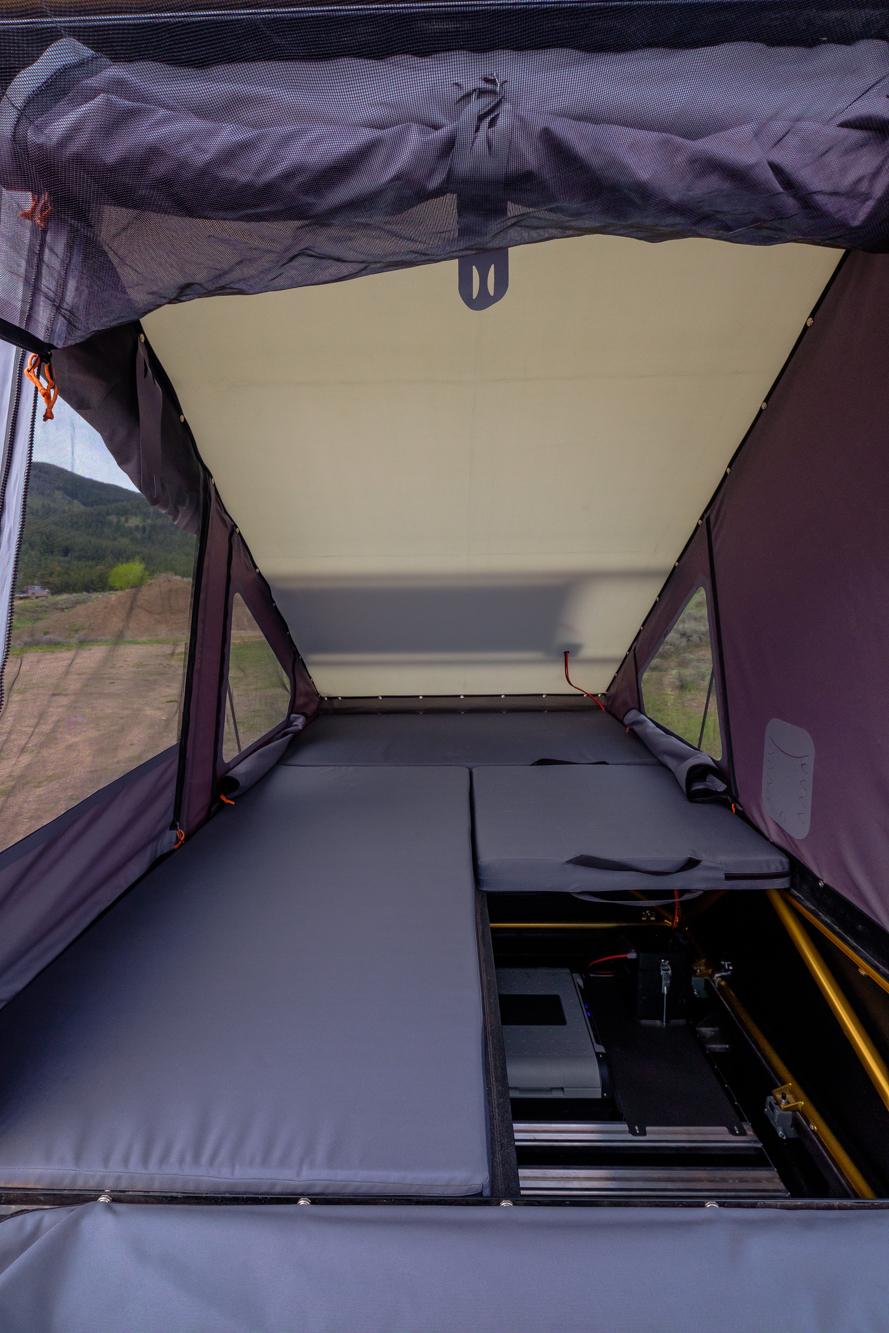
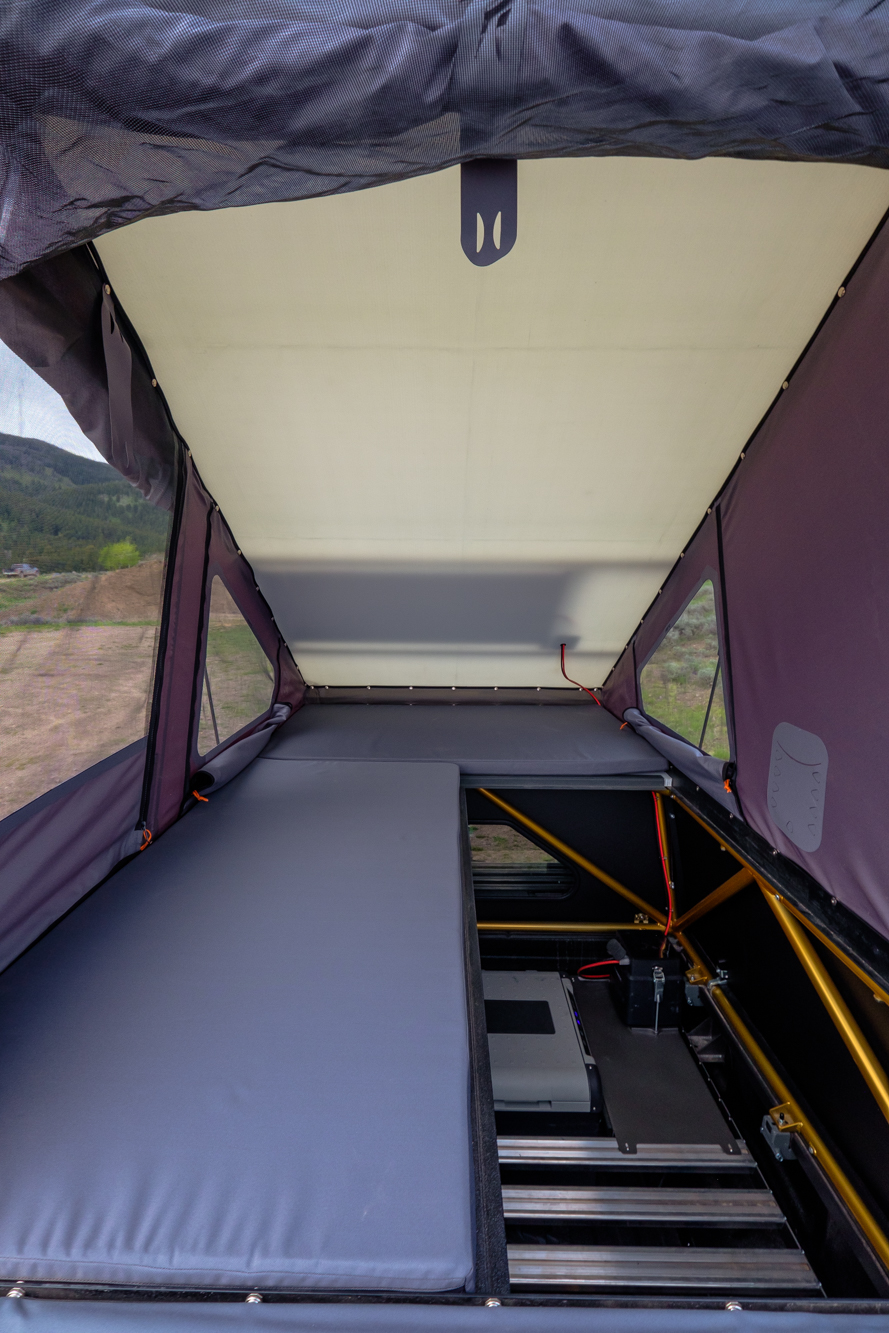
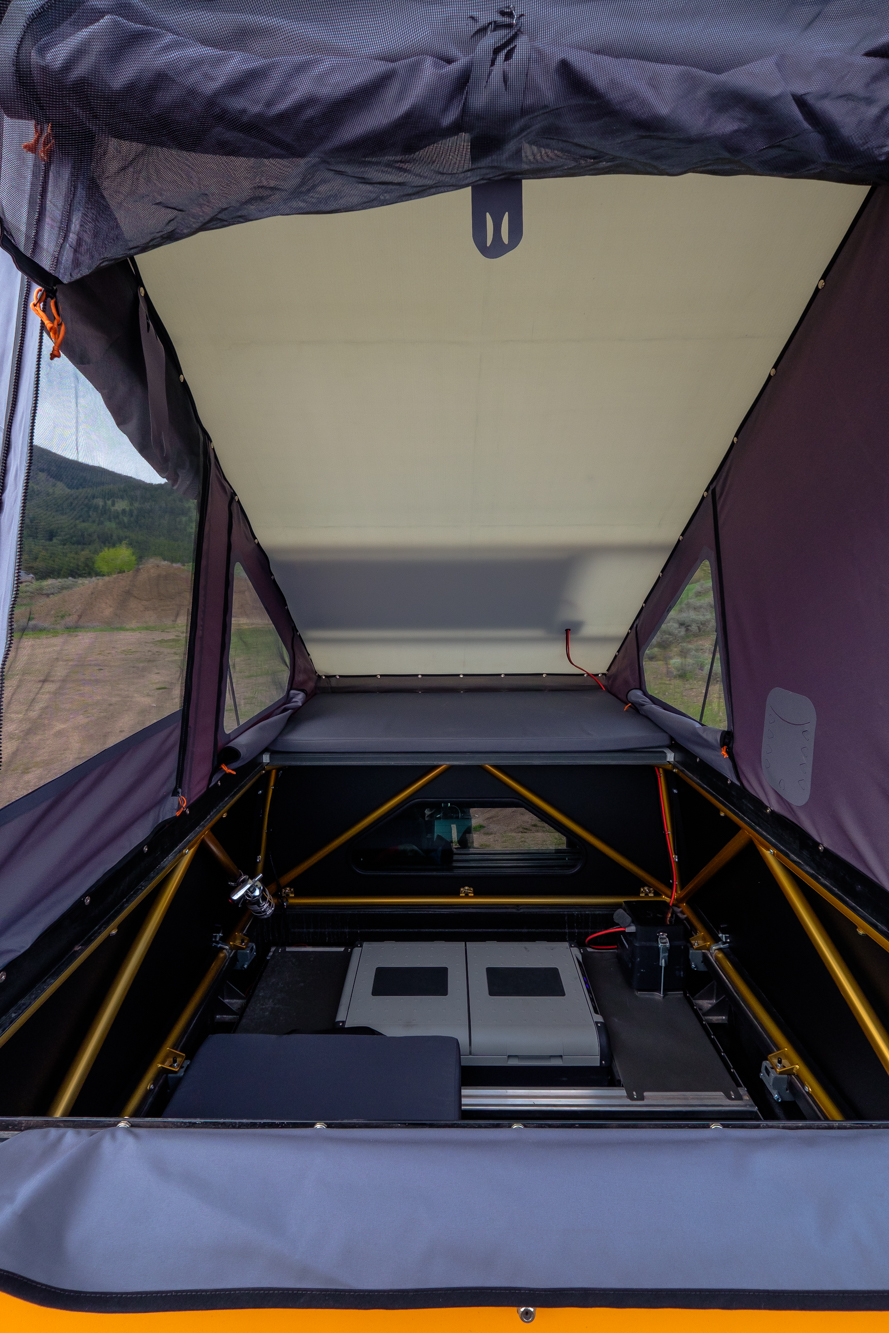

Pros
- Strong and lightweight frame
- Versatile design for storage, bed access, and mounting accessories
- Utilitarian design is functional and easy to clean
- Sleek modern looks
Cons
- 2-inch mattress is too hard
- Accessing the bed is cumbersome
- Tent seal could be better
SNAP! OUTFITTERS TREEHOUSE
Starting at $6,500
Snap Outfitters is a small East Coast company that was born out of a need for a better truck camper. The owner, Richard, wanted a more comfortable way to camp while kayaking in the backwoods of Pennsylvania, Ohio, and West Virginia. Wedge-style shells seemed like the ultimate answer, but at the time he couldn’t find any designed for full-size trucks. His solution was to utilize the tools and equipment at his existing company (Die-Tech) to build the camper he wanted. The result was the Treehouse, and it wasn’t long before orders from friends started rolling in.

The Treehouse has a lot going for it. At $6,500 for their bare-bones model, it is the second most affordable option in the test. Spring for the Standard model evaluated here and that price jumps to about $8,000, but you’ll be receiving quite a few upgrades for your money. The all aluminum structure is welded and riveted together for strength and corrosion resistance and powder coated black for a clean look. Enormous side access doors come standard on both sides and include stainless hinges and locking cam latches to secure them. These doors can open up for easy bed access, or drop down for secondary use as a table. In the rear of the camper, you can choose between a single or double barn door. As I mentioned with the Go Fast Camper, this sort of setup would cost $10,000 to $12,000 from some competing manufacturers, making the Snap Treehouse a good value. But with all of the other upgrades included in the package, the value seems exceptional upon initial examination.
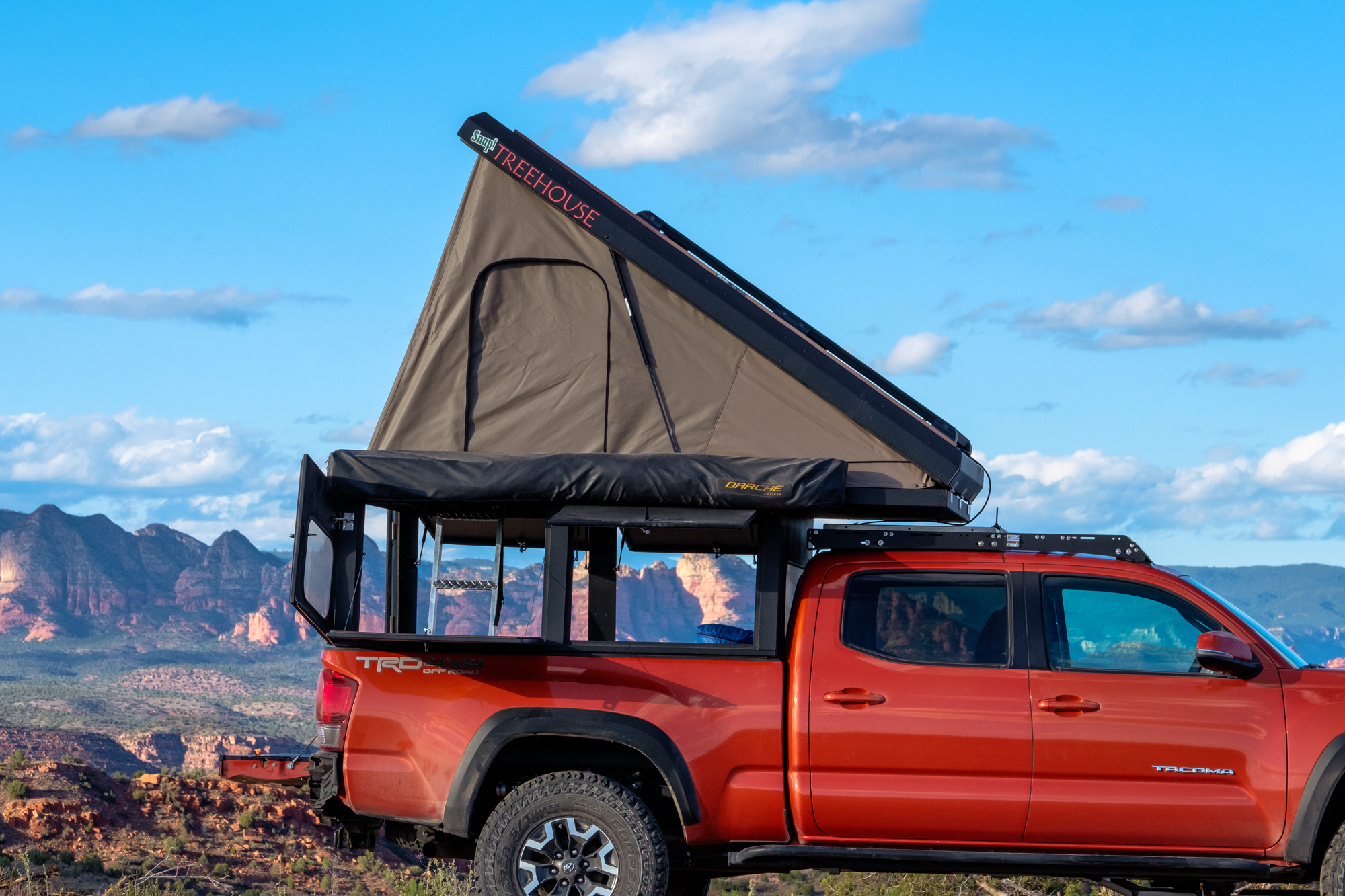


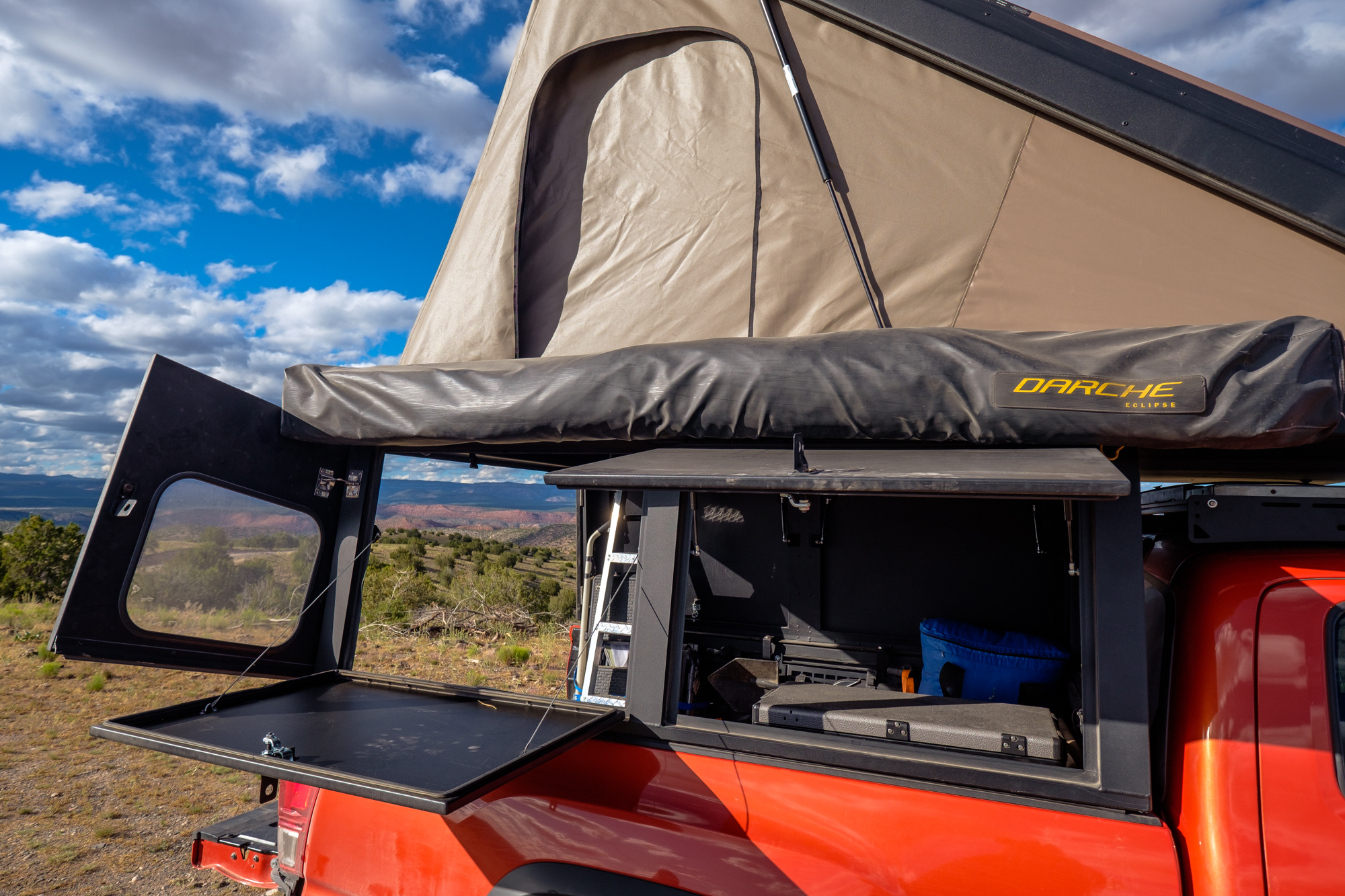
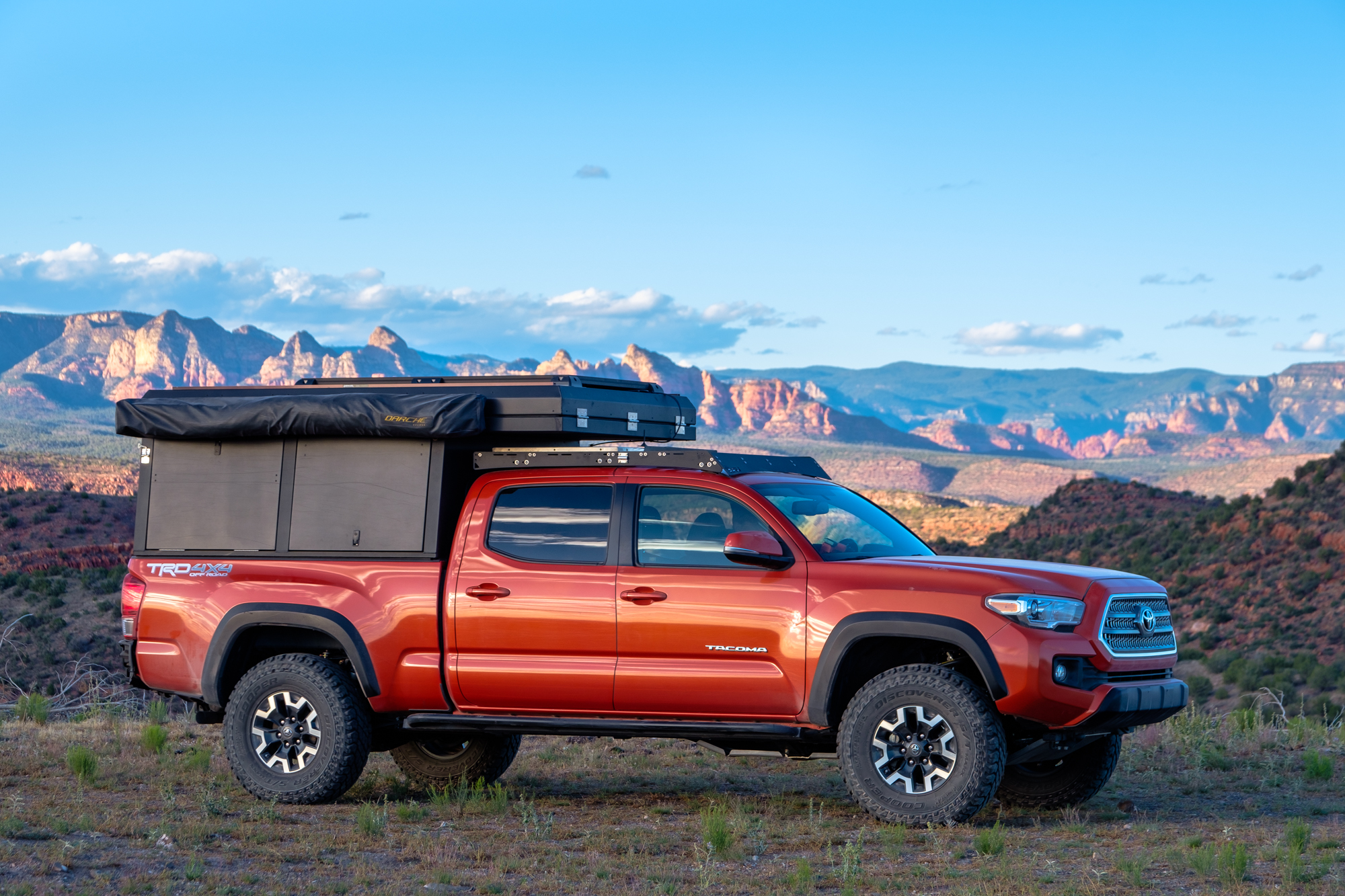
The camper also comes with T-slot channels on the roof which can accept a rack system capable of supporting 350 pounds when closed or 100 pounds when the roof is open. Inside, you’ll find an insulated and carpeted roof above a 3-inch-thick memory foam mattress which lifts up easily via gas assist struts. Two red/white LED interior lights are wired in for easy visibility at night above the bed, and two more are wired below to illuminate the rest of the camper. These are controlled through a wiring harness which also runs a 12-volt power port and two USB charging ports for your phone. There’s even a drop-down ladder which makes it easy to climb in and out of bed at night. With all of this included as standard on the $8,000 model, you might be wondering why it didn’t receive the Value Award, but there were several issues that were too large for me to ignore.
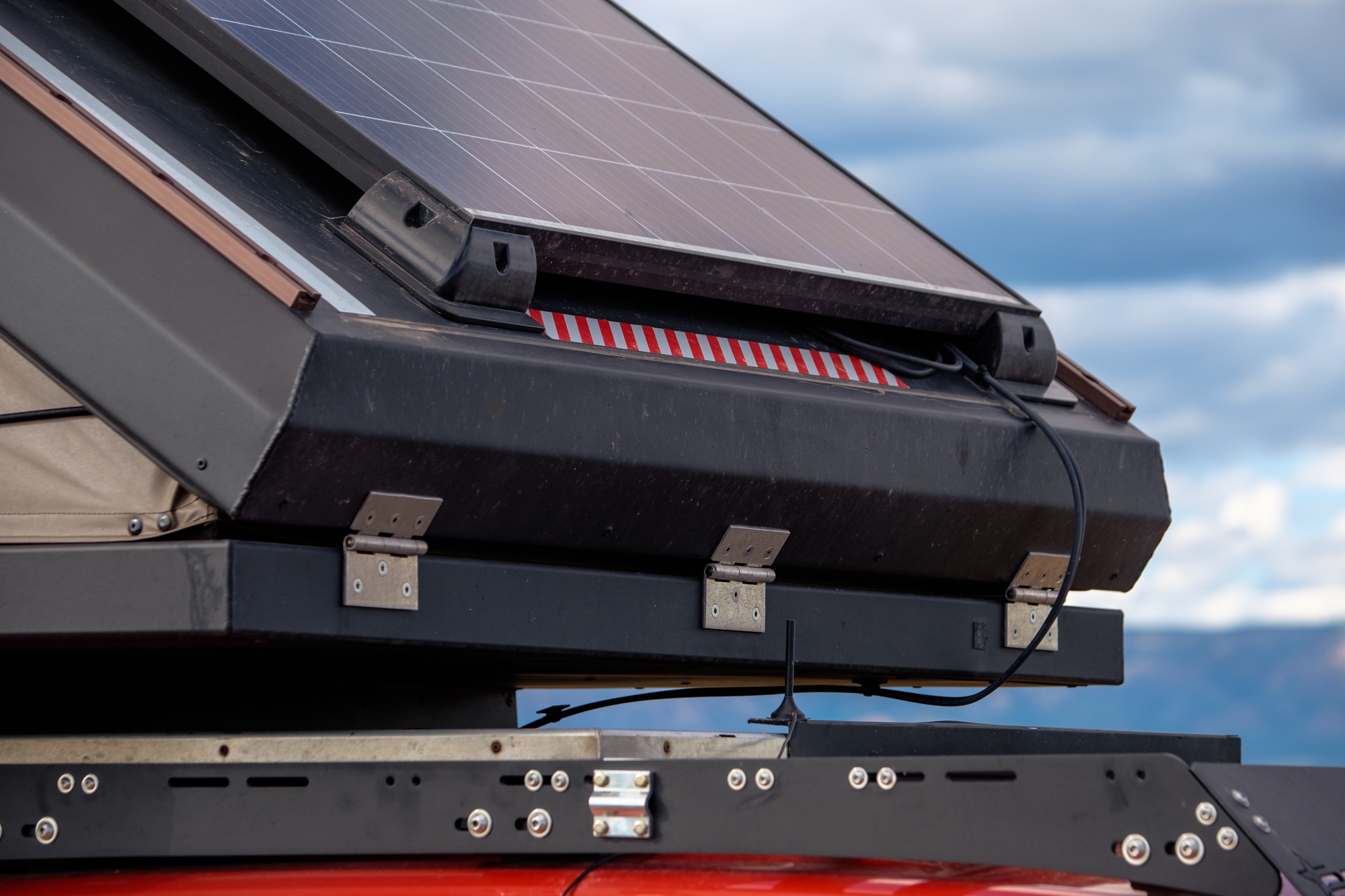
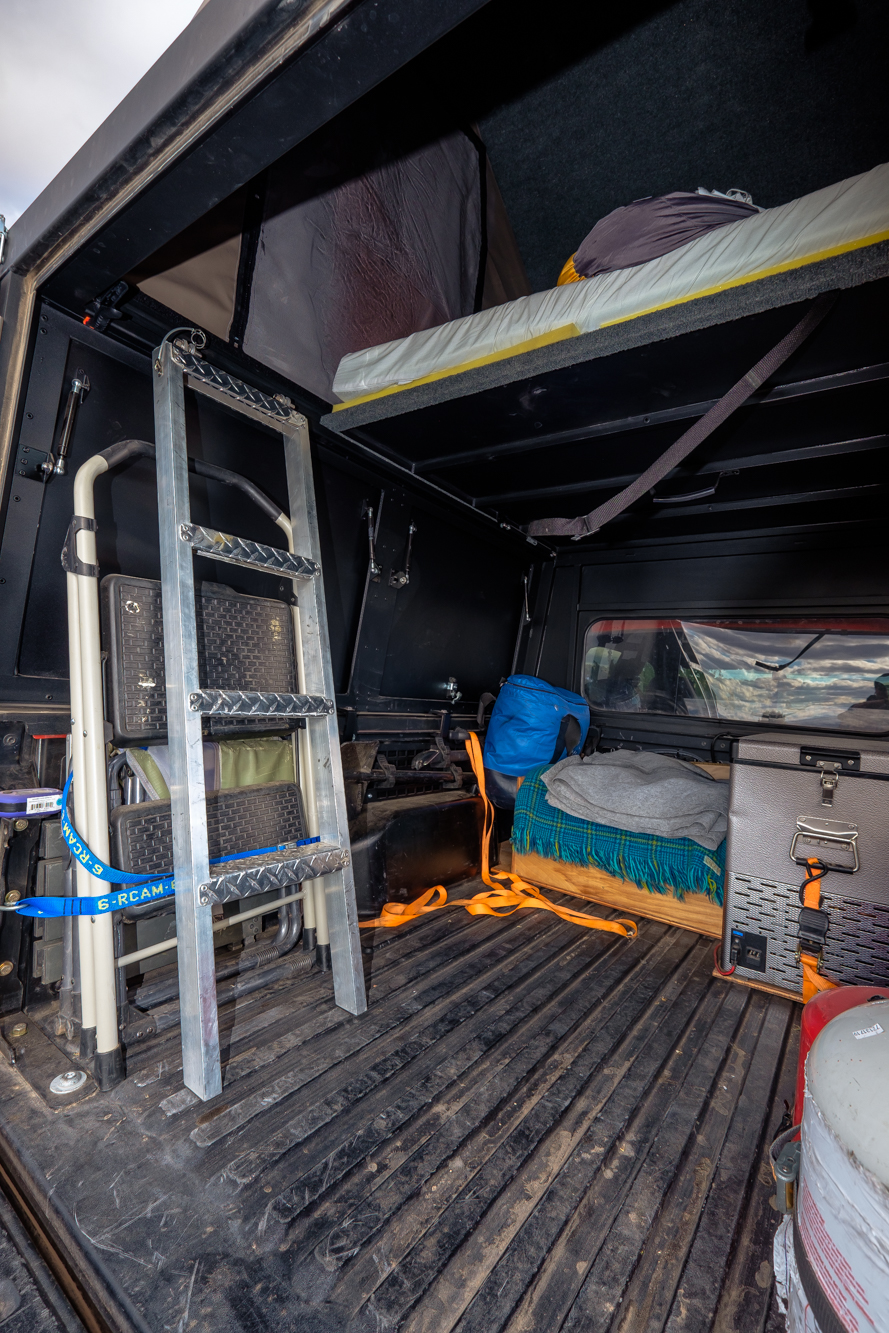
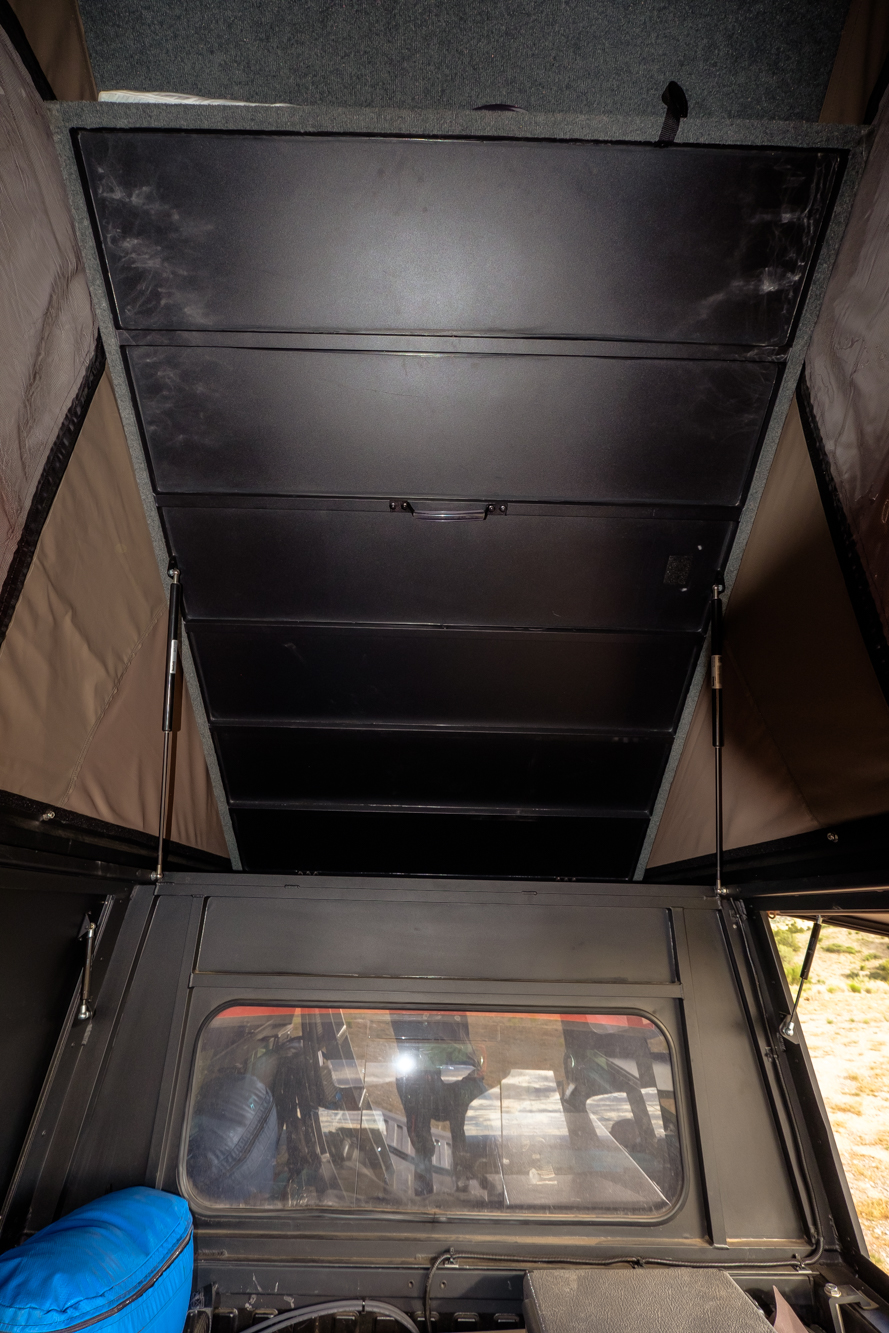
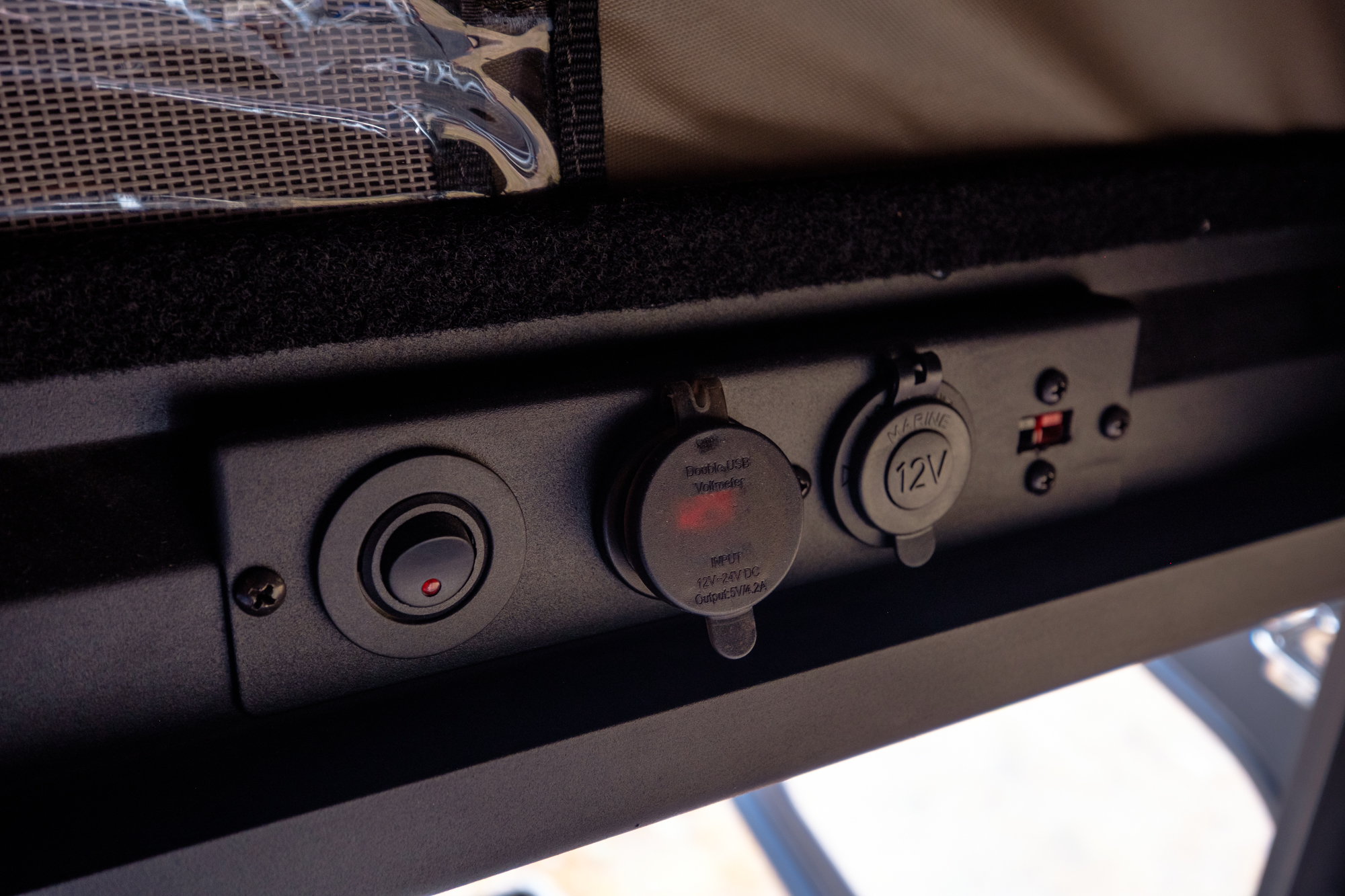
The least of these issues is the setup and breakdown time, which were the longest in the test. Setup took 41 seconds, while breakdown consumed a rather absurd 74 seconds. Realistically, this isn’t the end of the world; I mean, can you really not afford 40 extra seconds of your life? But the bulk of this time is consumed with the door latch mechanisms, which require you to walk out and around the door on each side of the vehicle to unlatch or latch them. It’s not difficult, but it’s annoying and unnecessary, and that bothers me.
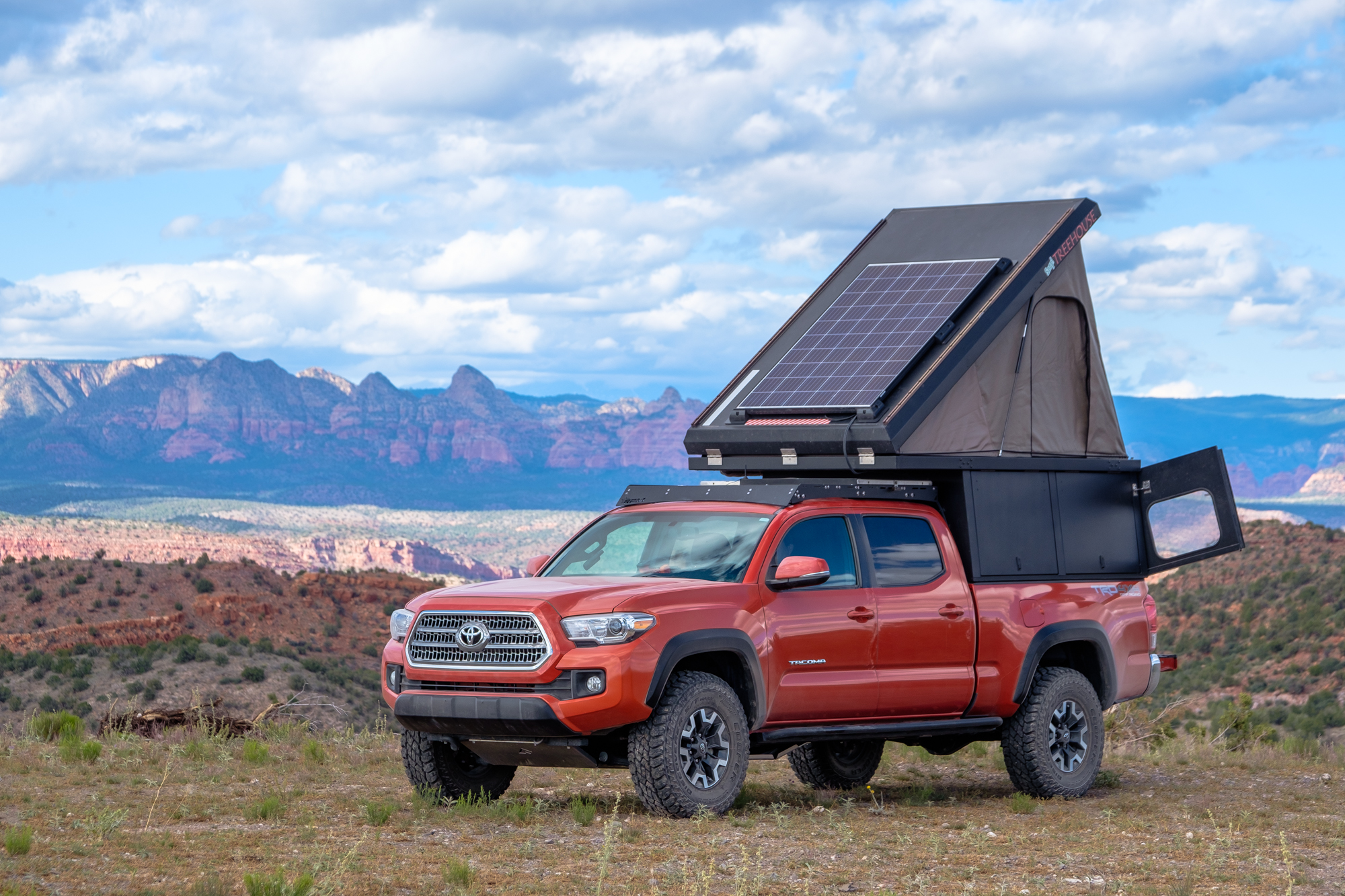
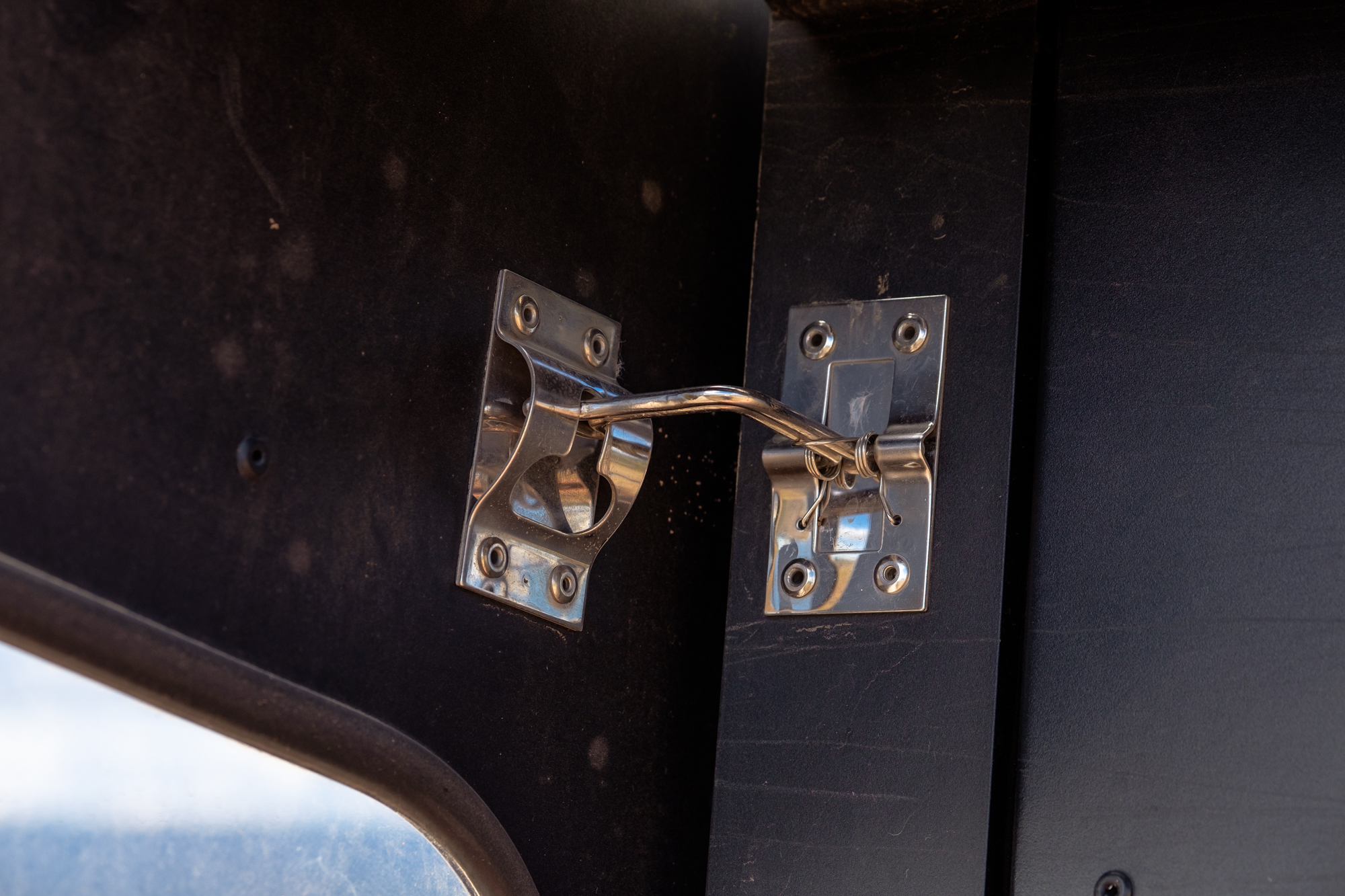
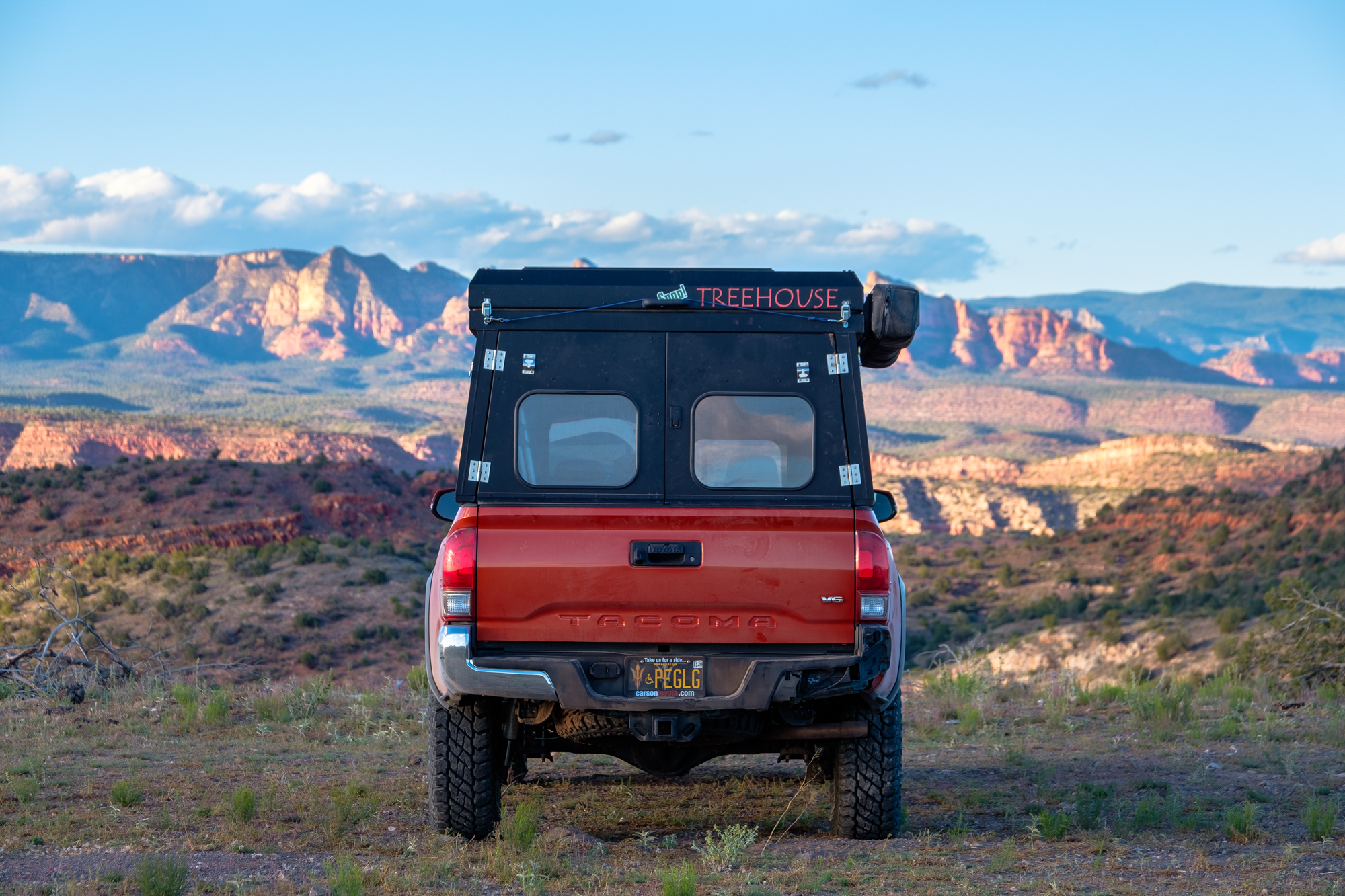
Then there are the windows, which have no straps to secure them and feel like they’re installed in the wrong order. Typically, a camper would have a bug screen on the exterior, then a clear vinyl window, and then the actual tent material as the last piece on the inside, allowing you to open up the camper in steps. In the Snap, the tent material is on the outside, the clear vinyl is on the inside, and the bug screen is sandwiched in between. So if you want to open up the window to look outside during a rainstorm, you have to fully open the camper to the rain by dropping all three layers, leaving the external tent layer and bug screen to hang outside, and then rezipping the vinyl window up. If you want just a bug screen for ventilation, you must once again drop all three layers and open up the tent to bugs, then rezip only the bug screen, leaving the tent to hang outside and the clear vinyl to hang inside.
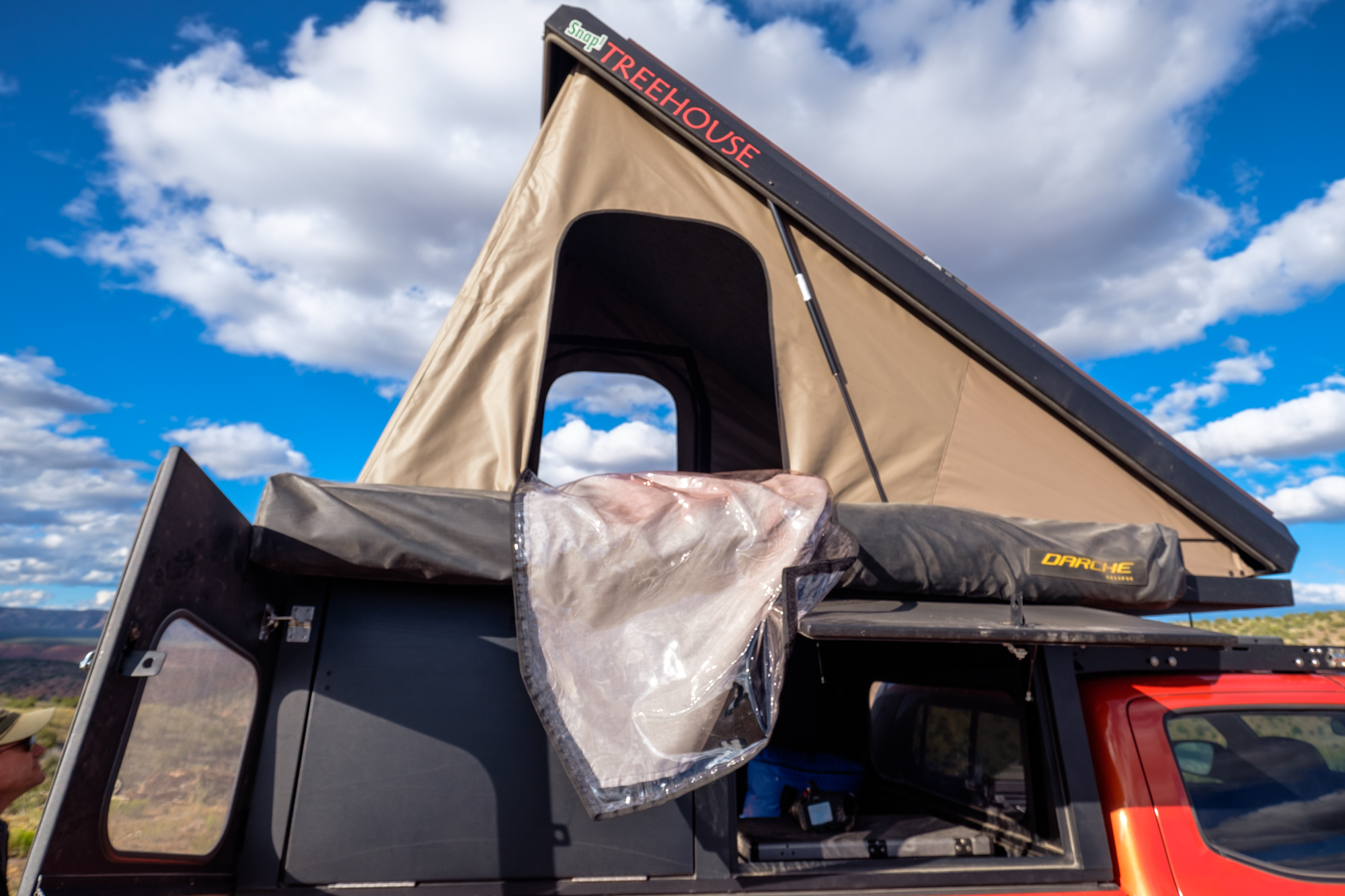
Then there are the rear seals on the doors and tailgate, through which water could easily leak in, and dust poured in through a myriad of gaps during testing. It was surprising really, as the rest of the doors and tent seem very well sealed.
The worst offender though was the bed. To its credit, the mattress was pretty good, and it didn’t force you to remove panels like the Alu-Cab or Go Fast campers, but none of that matters because it’s just way too short. At 74 inches, or six feet two inches for those who don’t want to do the math, it’s the shortest in the test, but that includes the space shoved down toward the end of the wedge, which means the last few inches are basically unusable anyway. I was able to sleep by laying completely diagonal, but even then, I barely fit.
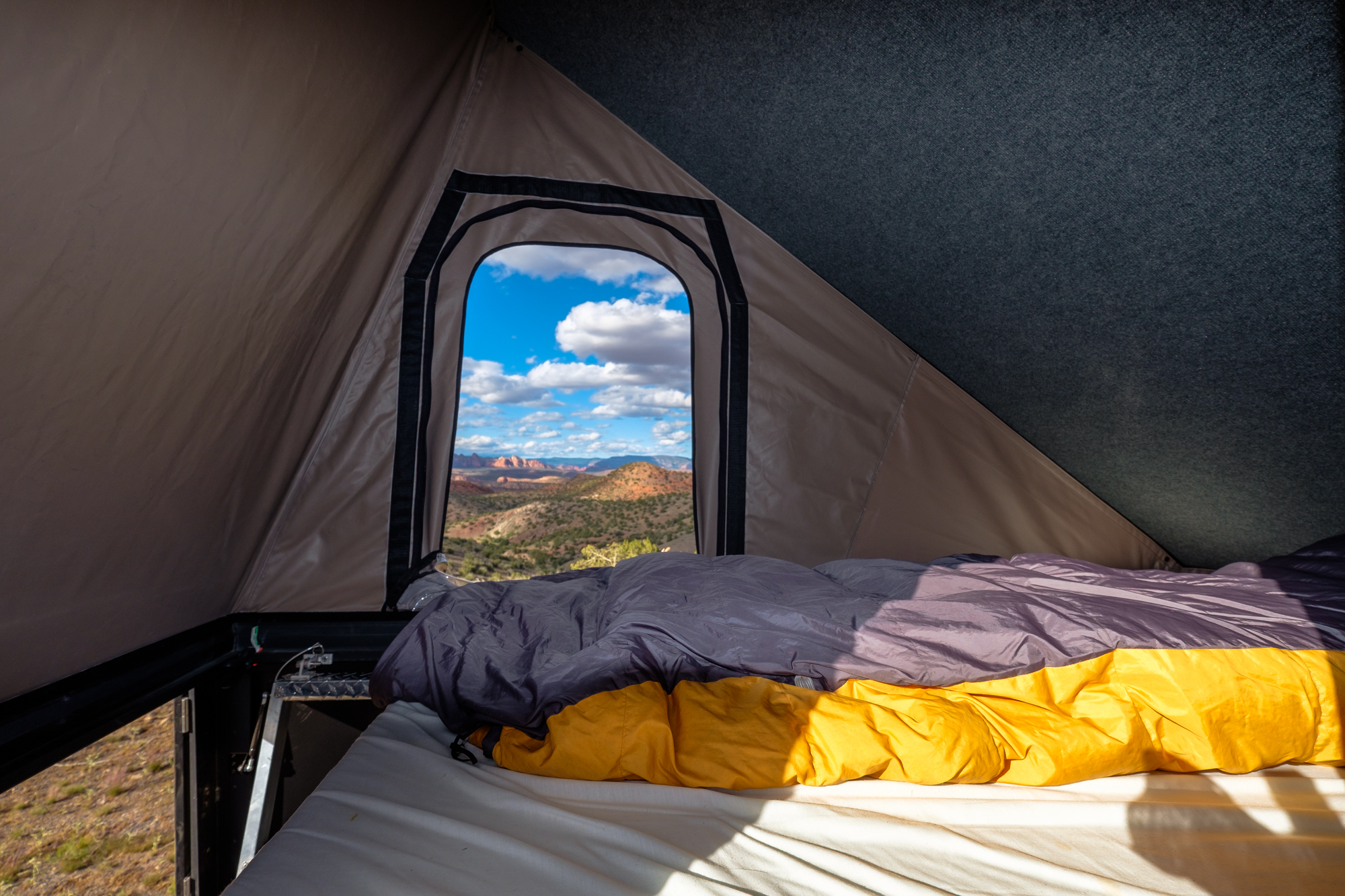
Pros
- Affordable
- Tons of features for price
- Side access hatches
- Ladder makes for easier bed access
Cons
- Poor seals
- Windows are weird and inconvenient
- Bed way too short
VAGABOND OUTDOORS DRIFTER & NOMAD
EDITOR’S CHOICE FULL-SIZE
Starting at $7,250

Vagabond Outdoors began prototyping their first camper back in 2016, and over the next year and a half, torture tested it on trails and washboard roads spanning most of the Western US. By March of 2018, they were ready and unveiled the Drifter and Nomad to the world. While they may be a young company, their staff’s experience in the industry and passion for their product line show clearly through their campers, which were some of my favorites in this test.

The fit and finish on their shells is exceptional. They are made from laser cut and CNC bent 1/8-inch 5052 aluminum sheeting, and then welded and bolted together using stainless steel hardware and MIL-SPEC aluminum rivets. The resulting lines are almost unbelievably clean, uninterrupted by struts or brackets thanks to a cleverly designed lid which conceals these components when closed. The roof is made from a single piece of aluminum to prevent any chance of leaks and bent slightly into four sections for additional rigidity and strength. This creates a ridge which also helps prevent water from pooling, as it serves as a natural high point in the center.
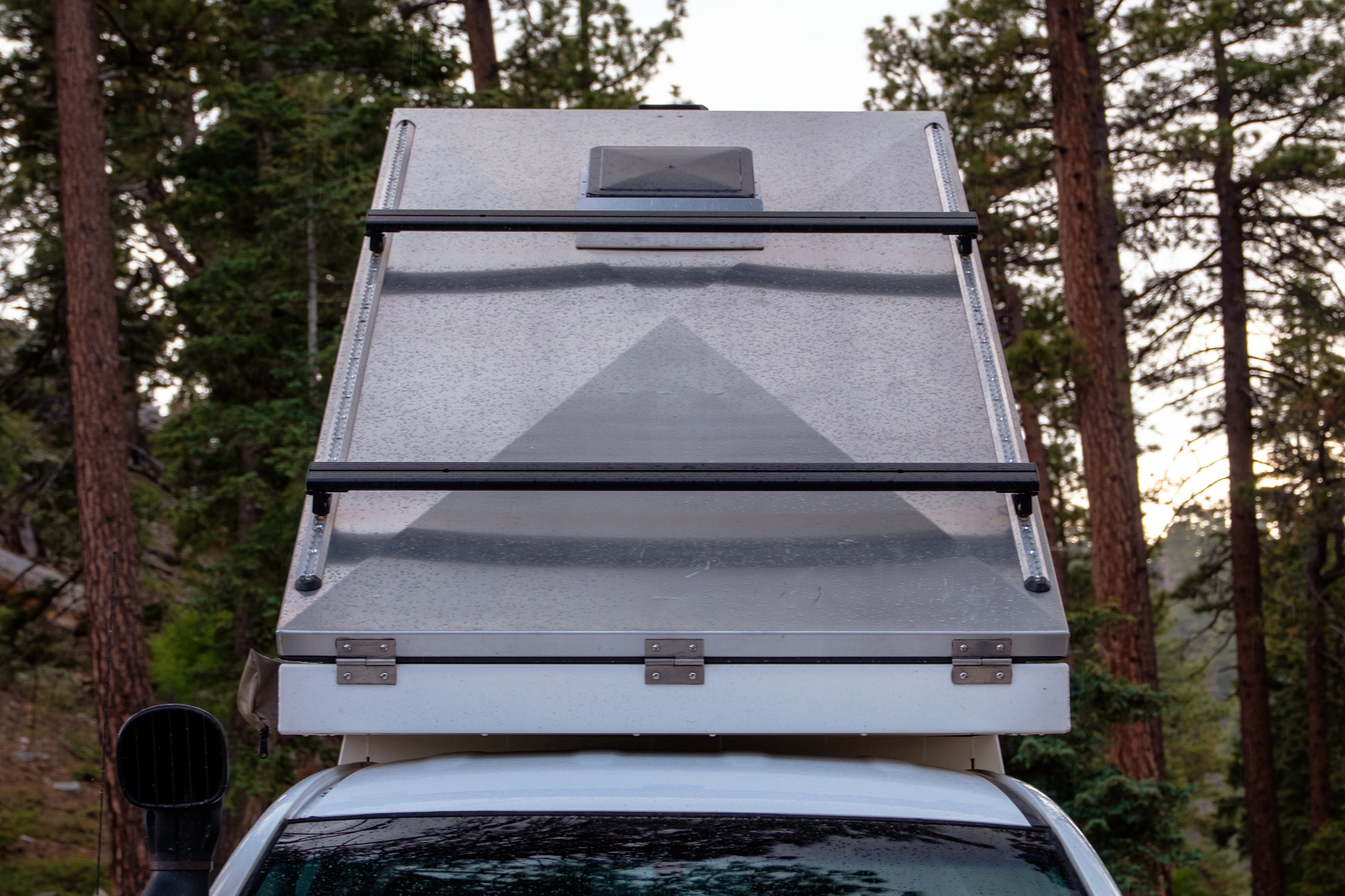
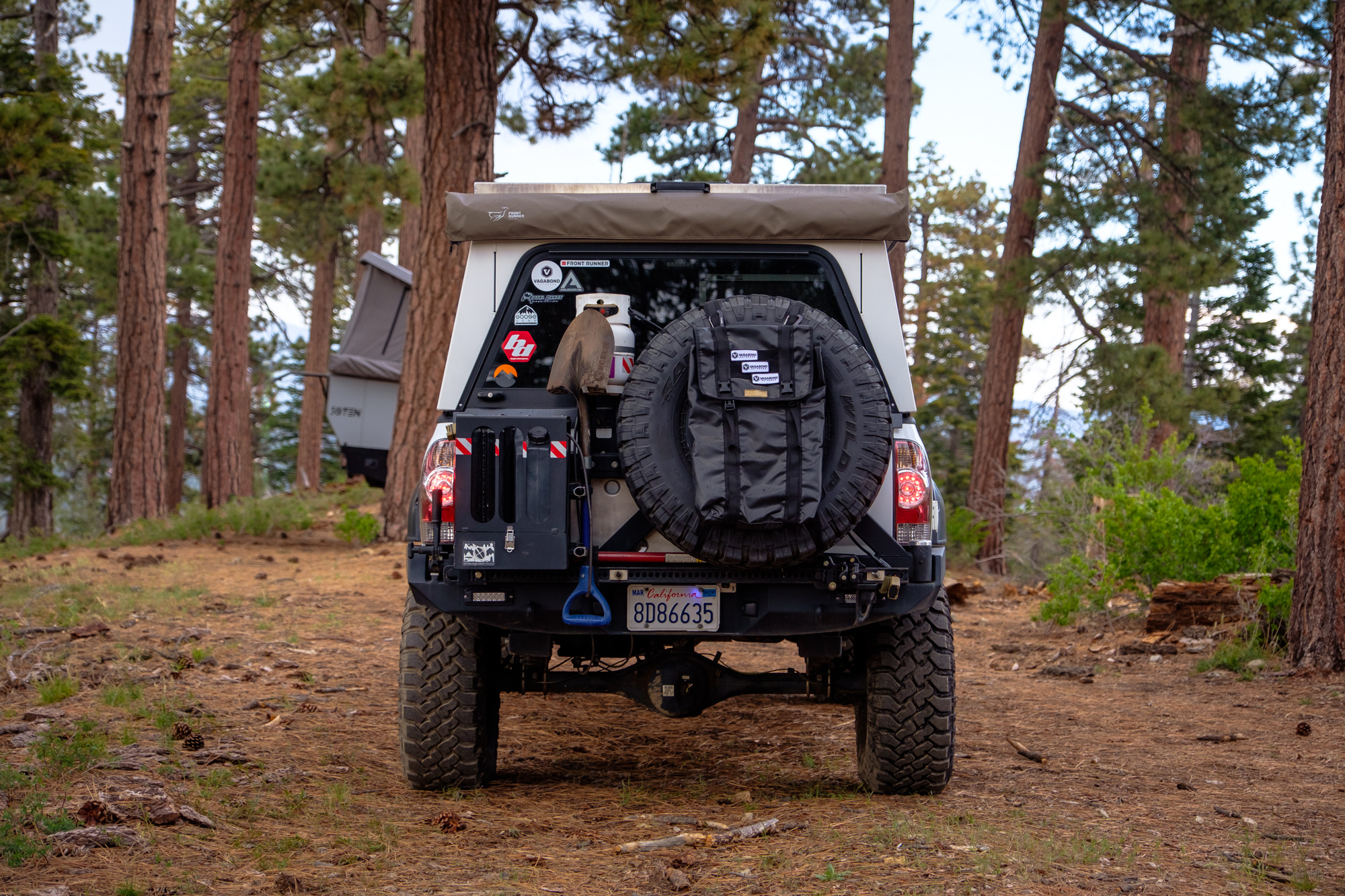
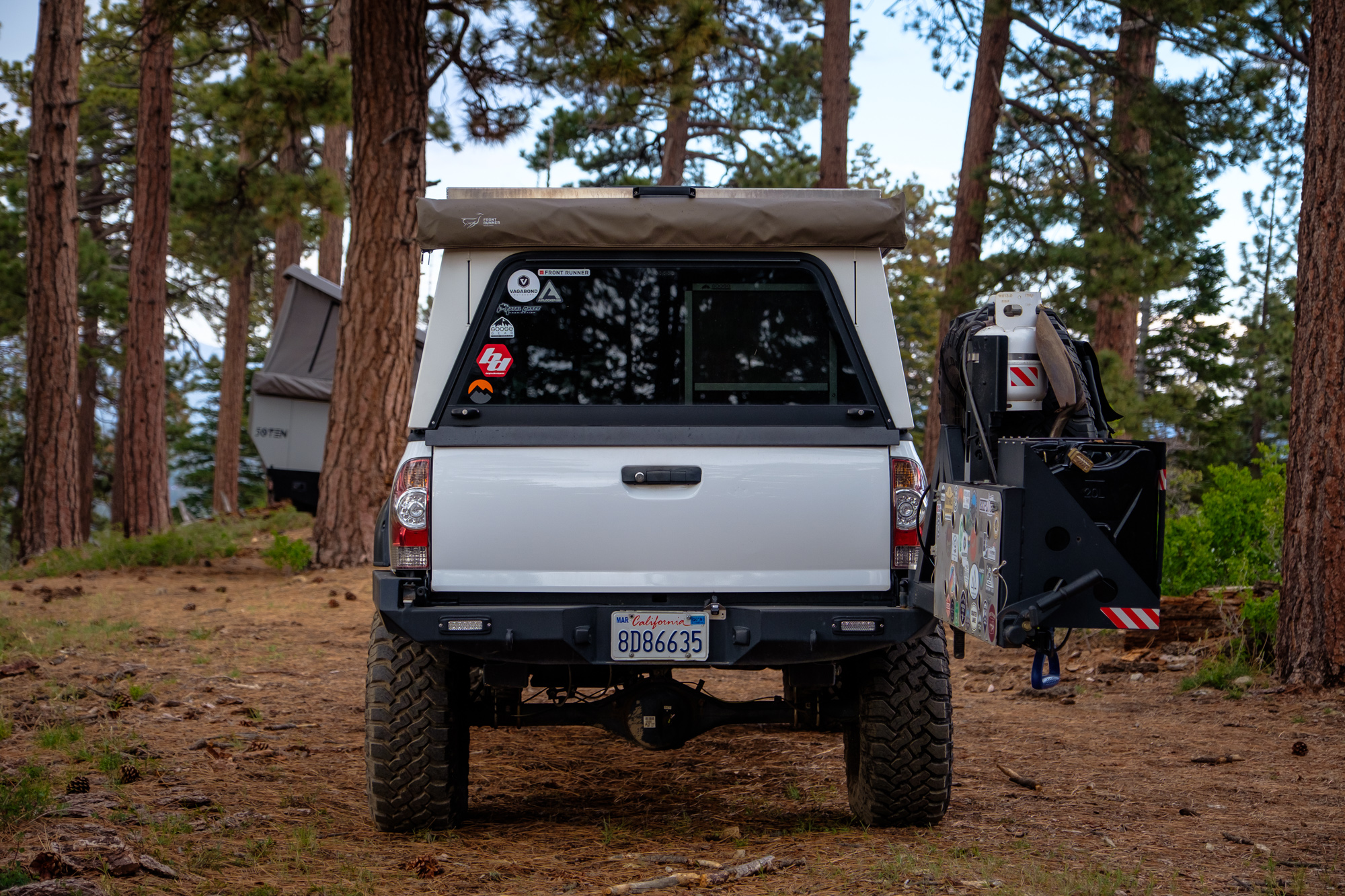
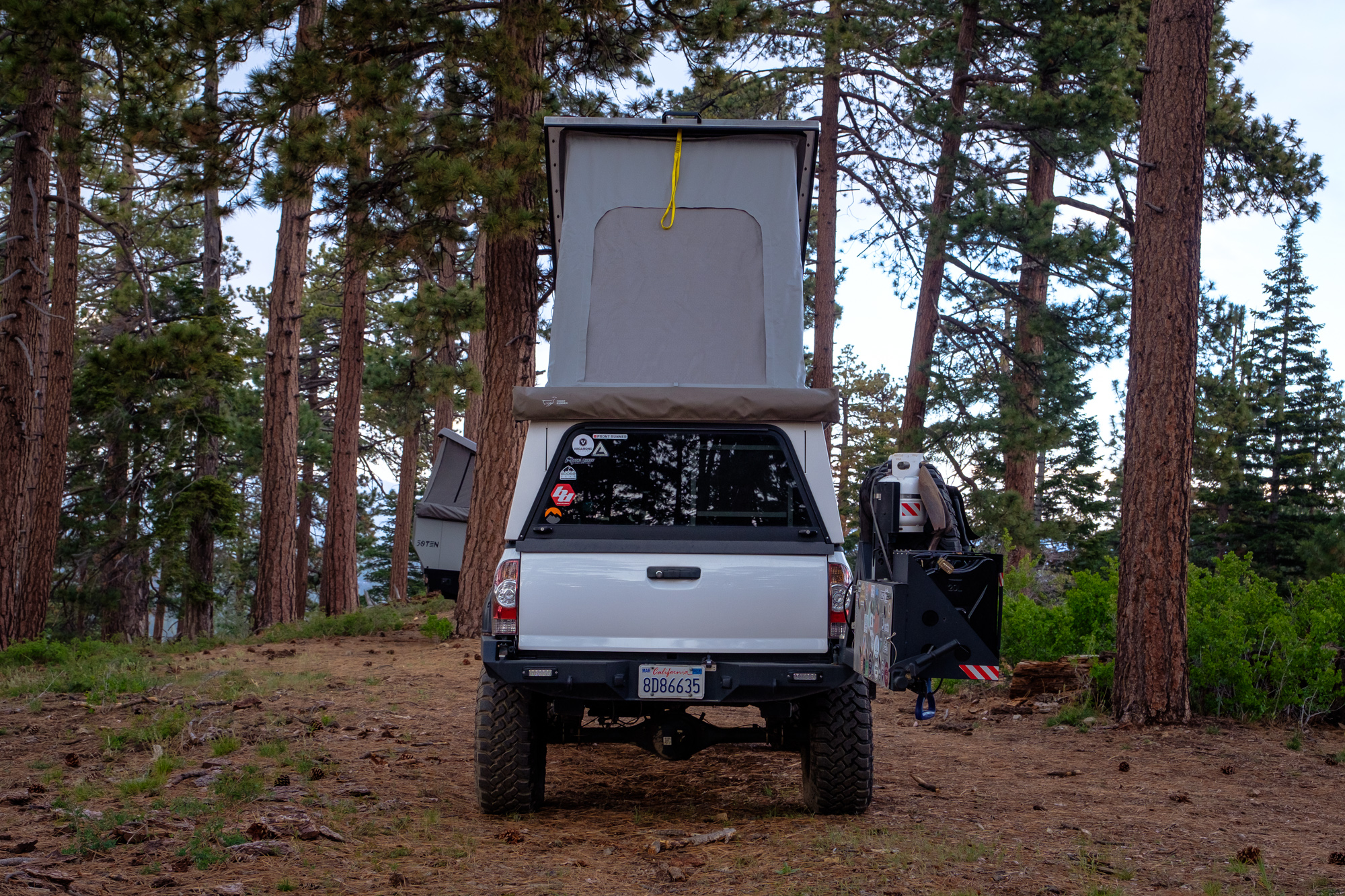
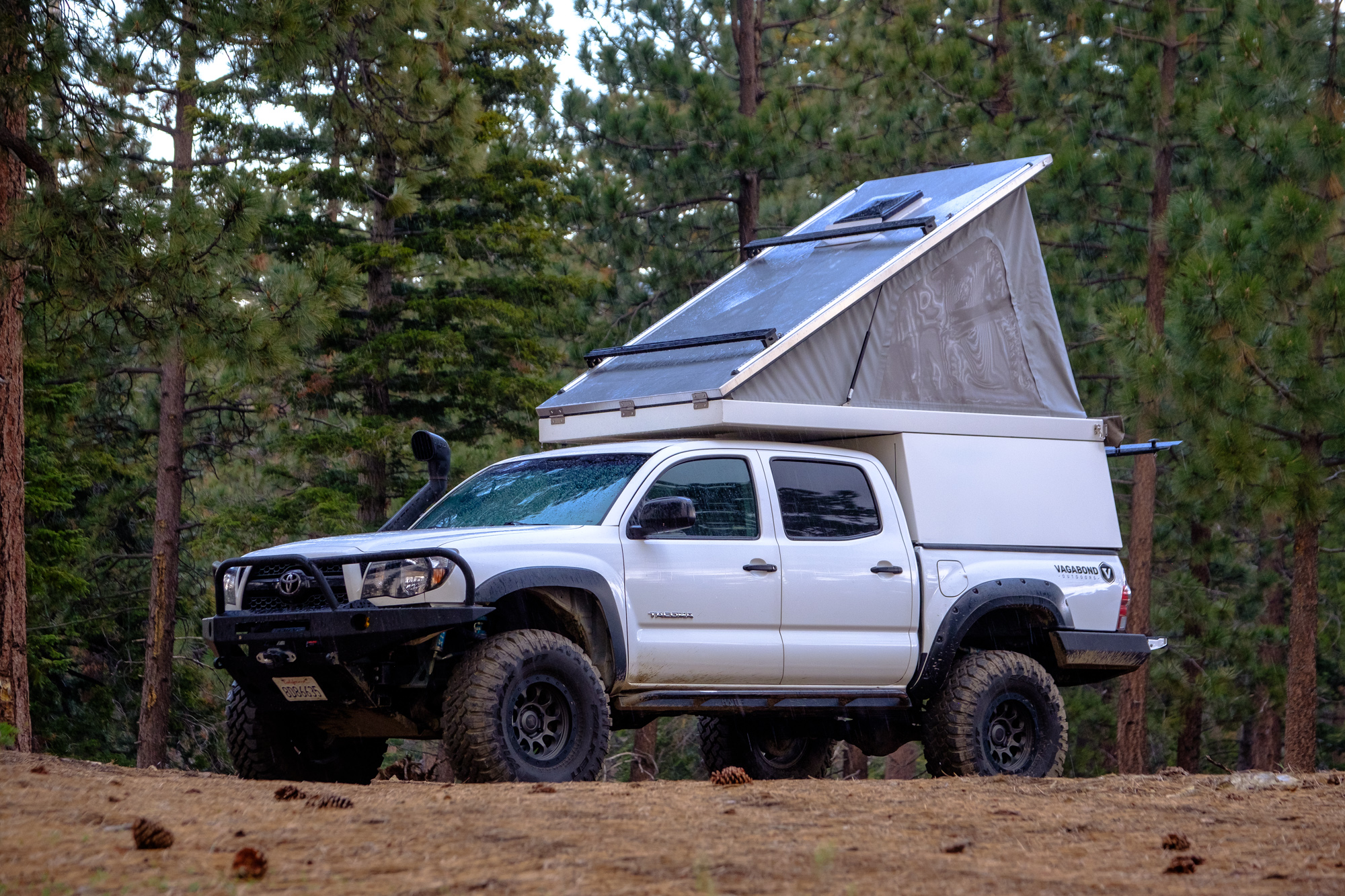
Pop the top, which takes just 17 seconds and hardly any effort, and you’ll reveal an 18-ounce, vinyl-coated polyester tent seated with a keder rope channel seal that provides an excellent seal against water and dust. This tent packs three massive windows with clear vinyl on the two side views and mosquito mesh and black curtains on all three. Vagabond’s window package was my favorite of any camper in the test, as it provides massive views, fantastic airflow, and abundant natural light whenever you need it. I also appreciated that they included straps to tie down the rolled layers of fabric while the windows were open, a nicety that only one other manufacturer added. 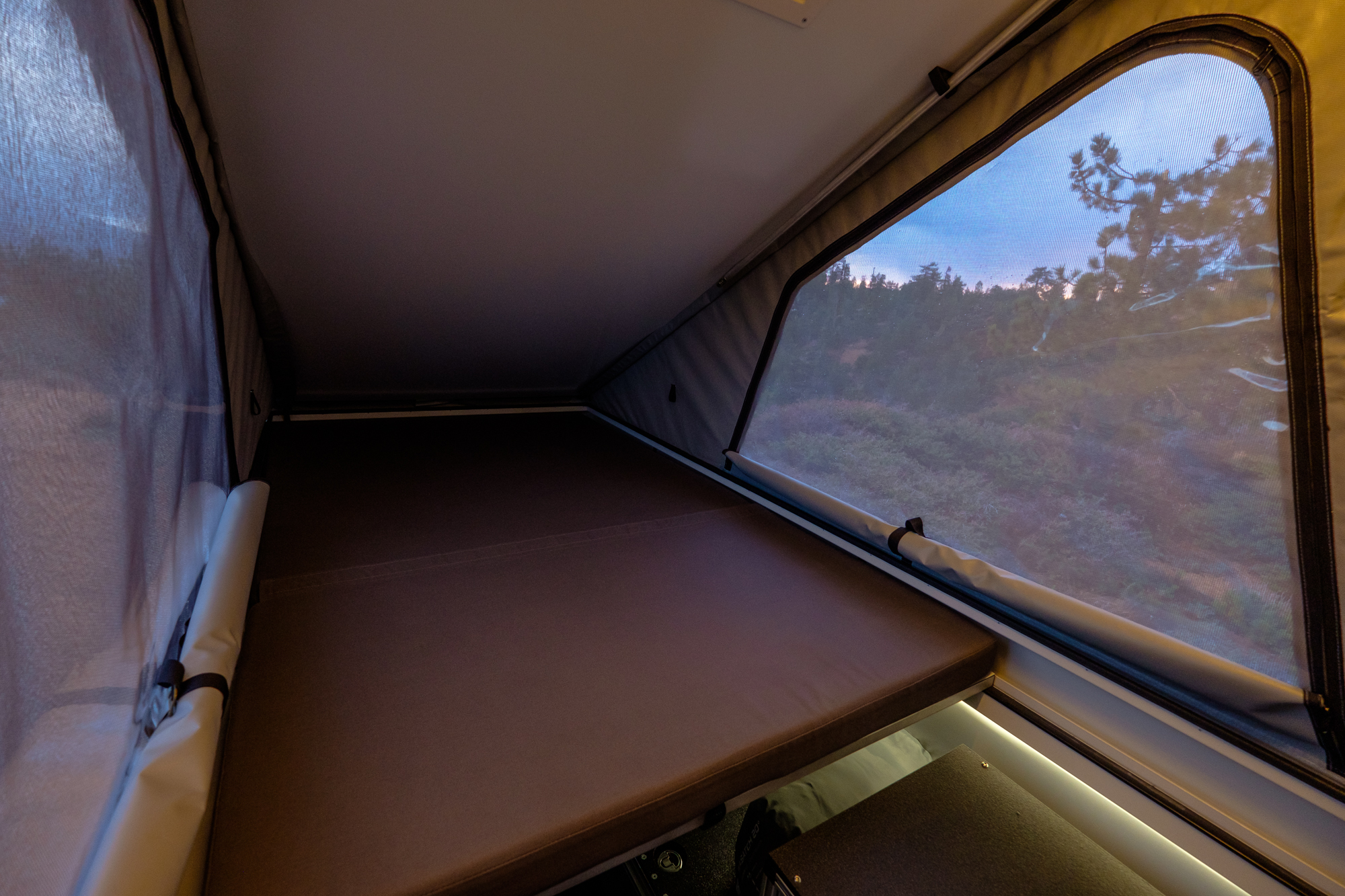
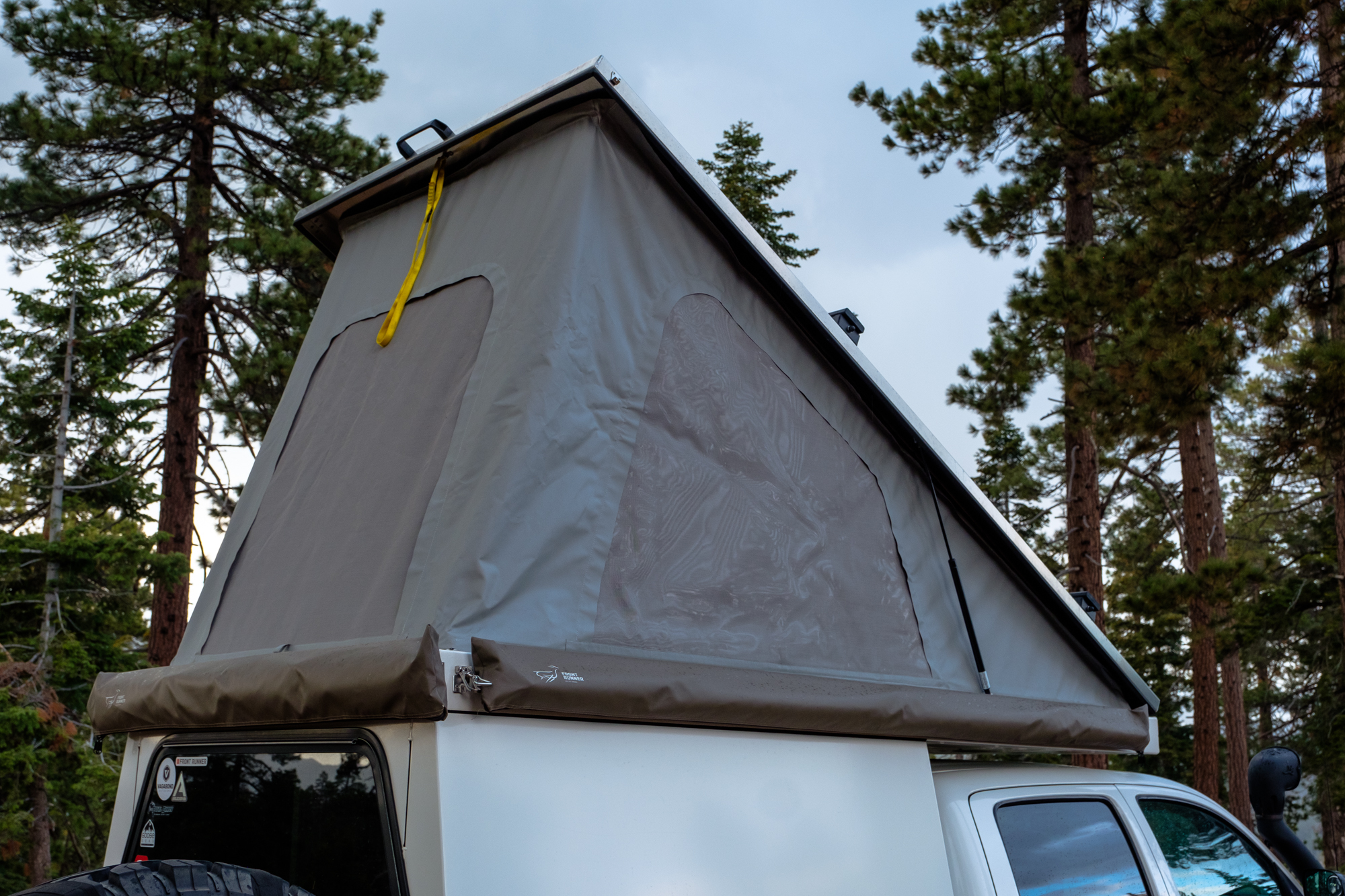


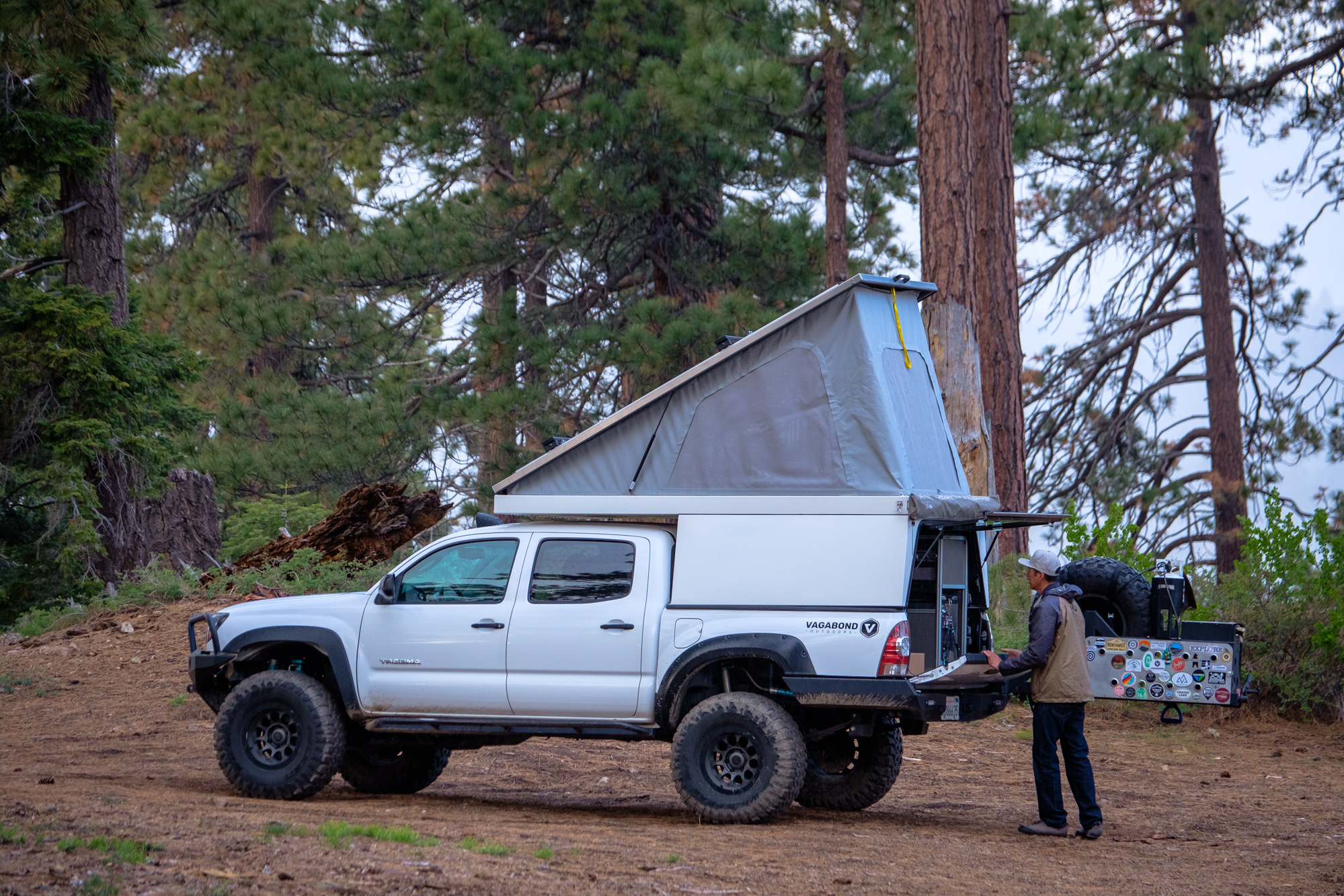
The zippers were good-sized, the stitching was solid, and the trim was carefully finished, leaving me with a positive impression of the tent overall. Therefore, by any logical measure of sealing, breathability, or design the Drifter and Nomad tents check out. I didn’t feel they were quite up to par though with the Summit, their closest competitor, due in part to the Summit’s minute improvements, and my personal preference for softer fabrics over the heavier duty vinyl used on the Vagabond tents.
The interior of the campers helped to make up for these perceived shortcomings, with carefully rounded edges and the much-needed trim guards the Summit lacked. Add in the optional industrial-grade powder coat, and you have a smooth, scratch-resistant, and durable shell you’ll love for years.

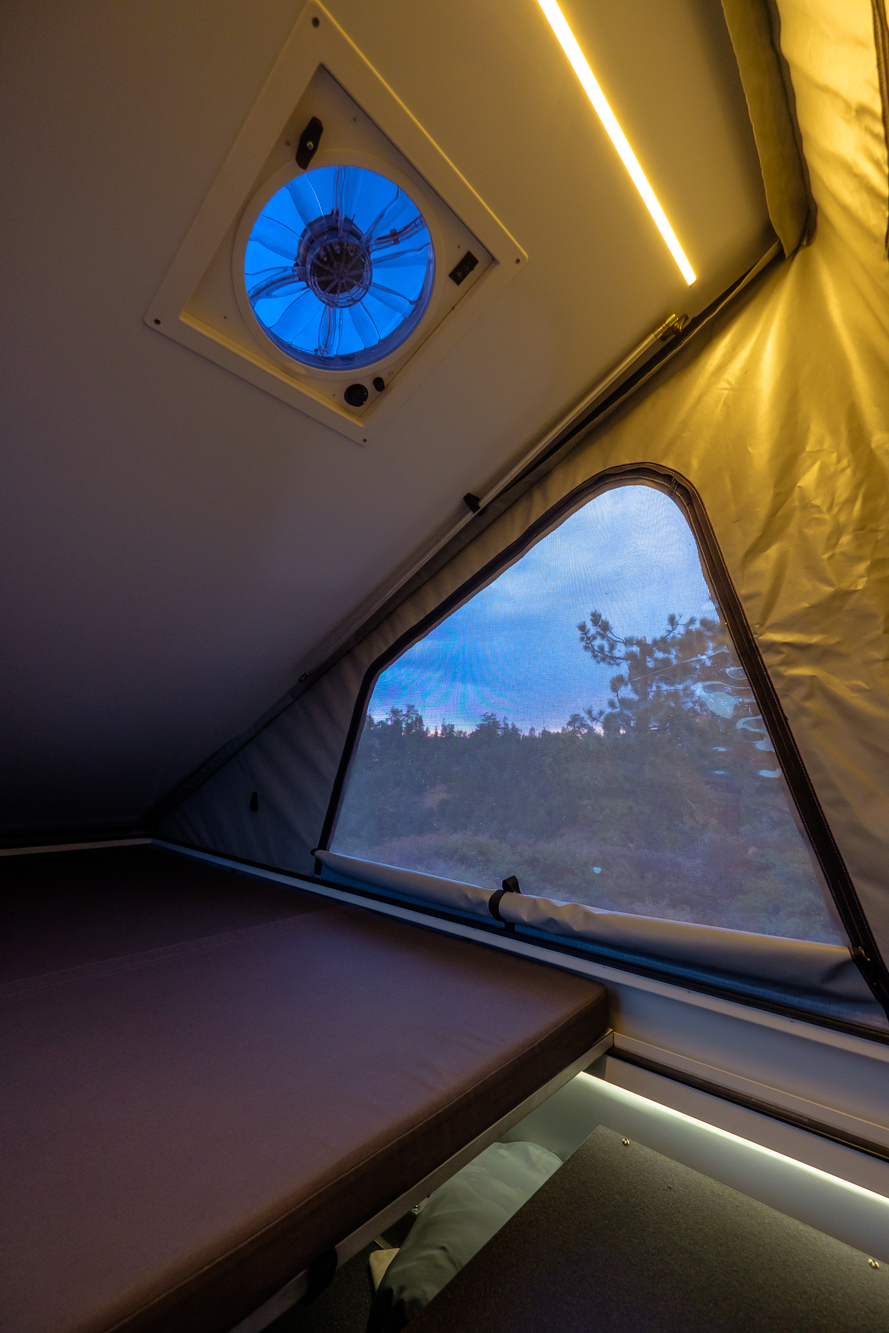
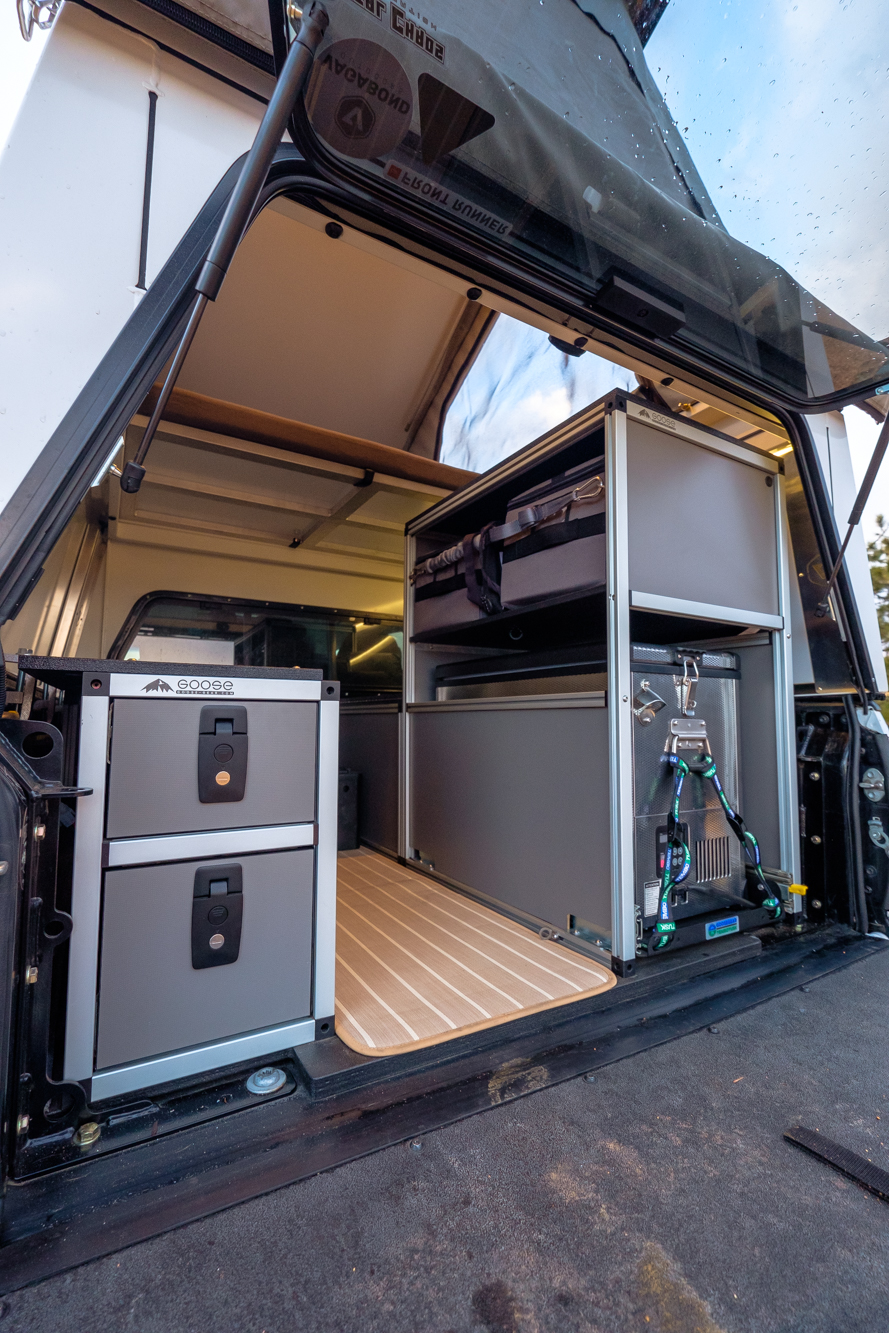
The living space is ample in both the Drifter and the Nomad, with enough room to move around and relax in without feeling like you’re sitting in a truck bed. I love that Vagabond gave the Nomad a larger bed and top to match the full-size vehicles it is intended for instead of using a single universal size; this solved the slanted wall problems we encountered with the Summit. Instead of having to hunch over or waste cargo space above truck bed height, every inch of the Drifter and Nomad is usable space.
The 3-inch, high-density foam mattress is comfortable and measures a full 48 x 80 inches on mid-size trucks or 54 x 80 inches on full-size trucks. You can then add optional extension panels for more length if you’re on the taller side. Even when the bed is fully deployed, there is room to stand and move around, which allows occupants to get dressed or make coffee while their partner is still asleep. Once everyone is up and about, the bed can be broken into two sections and slid back toward the front of the camper. Truthfully I didn’t like this split bed sliding setup as much as the gas strut system in the AT Summit. However, the ability to shorten or lengthen the bed to your needs by swapping for different panel sizes seems like a fair tradeoff for the inconvenience.

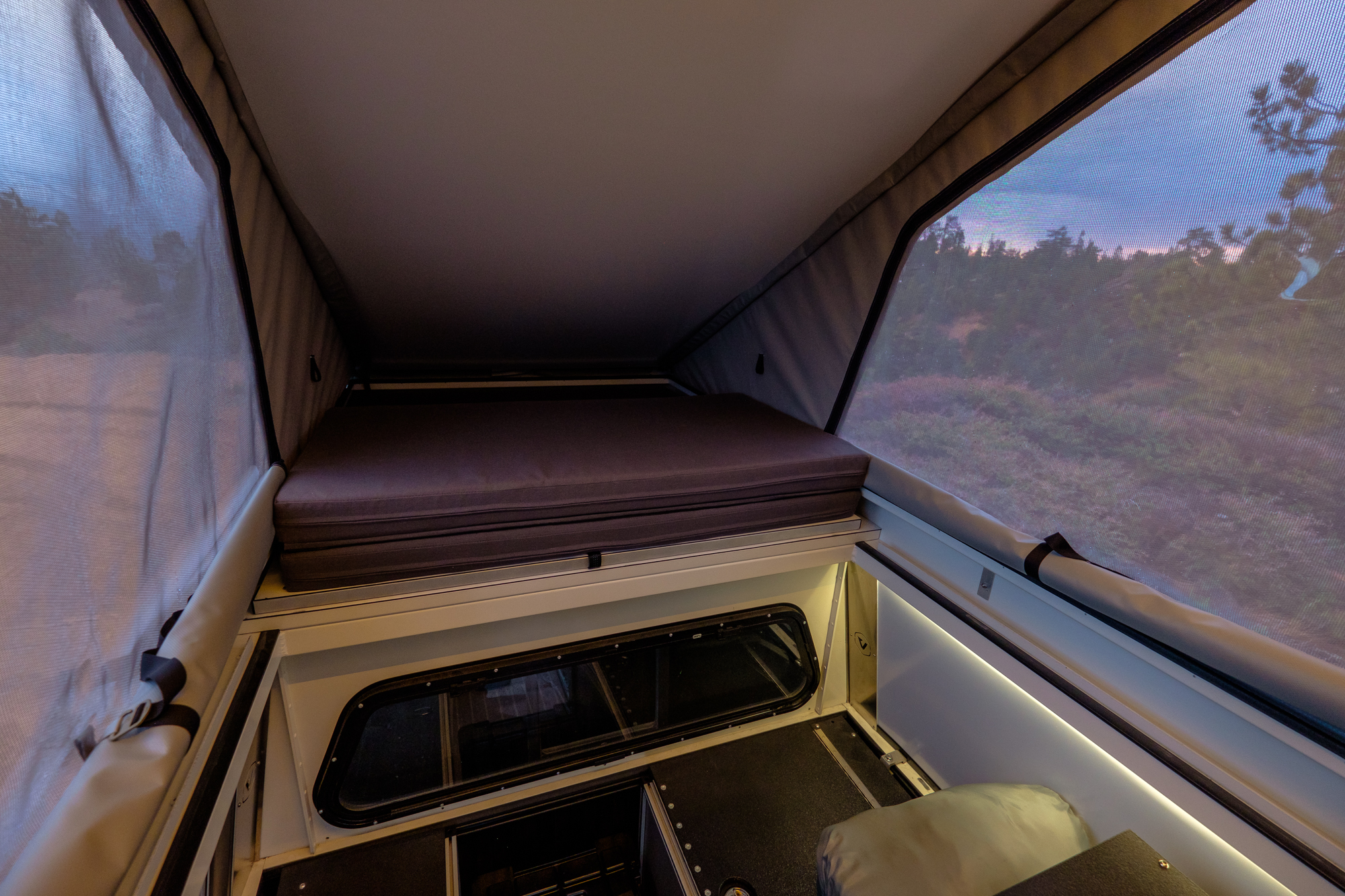
Both the Drifter and Nomad come with an impressive array of standard features for the price, like a concealed wiring tray which makes it easy to run your own accessories after the fact, and a switched interior LED light to illuminate the cabin in the evening. You also get an LED third brake light, insulated ceiling, a glass window against the cab with a drop down for cleaning, and a rear glass window with keyed locks and adjustable latches. There are also plenty of ways to upgrade the Vagabond campers, from electrical and fan systems to side-access hatches, paint matching your vehicle, and what was the best interior lighting system in the evaluation thanks to recessed LED strips which give the interior a warm glow instead of a blinding white light. Each accessory has been carefully tested and considered to ensure that it’s safe for automotive use. “Oftentimes, we found lighter or more affordable materials, but they didn’t meet the NFPA 1192 standards, so we went with what we’ve been using since Zero [their prototype]. We haven’t changed any of the materials since then due to the fact that we evaluated all this before going into production. Safety was a core concern from the beginning.“

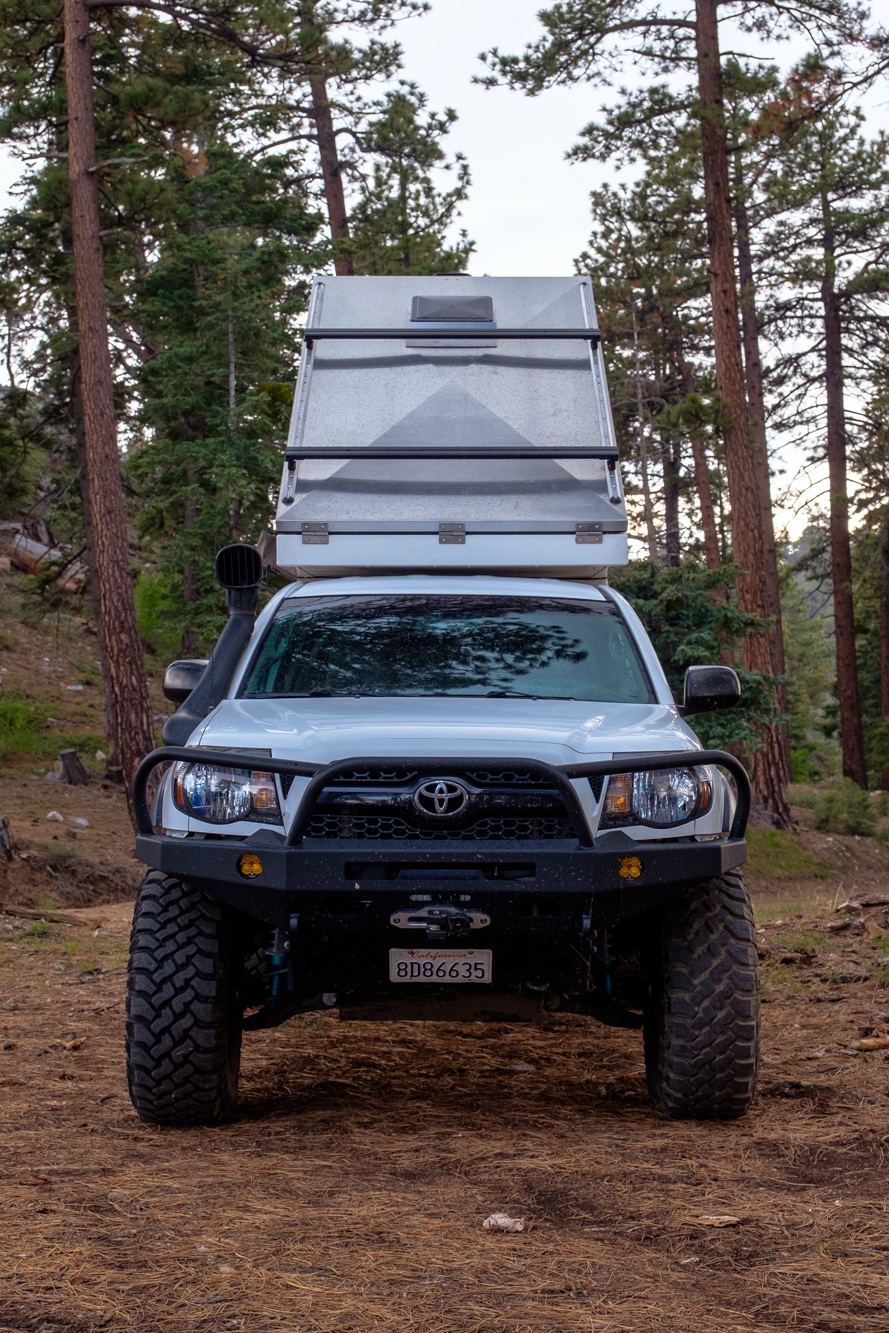

Pros
- Excellent fit and finish
- Big windows
- Comfortable interior with extendable bed
- Larger bed dimensions for full size mean no slanted walls
Cons
- Tent looks and feels a little less refined due to vinyl coating
- Bed panels slide instead of lifting up on struts.
Conclusions
In this evaluation, I found myself stuck in a precarious position while selecting the Editor’s Choice Award. This award has always been bestowed upon the product which we would choose for our personal vehicle regardless of price, in other words, the best of the best. Yet it is also meant to convey which product we would recommend to our readers, and therein lies the difficulty.
Because I live full time on the road, I weigh various factors in this test differently than I would if I owned a home and was using these products on shorter trips. Some of the qualities that are advantageous for life on the road are a hindrance in a daily driver, while some features I would adore while using my truck for errands I would hate when using it to travel around the world. Adding to that complexity, I found my choice would change based on whether I owned a full-size truck or a mid-size truck. In other words, one size doesn’t fit all, so to best serve our readers, we decided to award three titles in this test: Editor’s Choice, full-size, Editor’s Choice, mid-size, and finally our Value award for both.
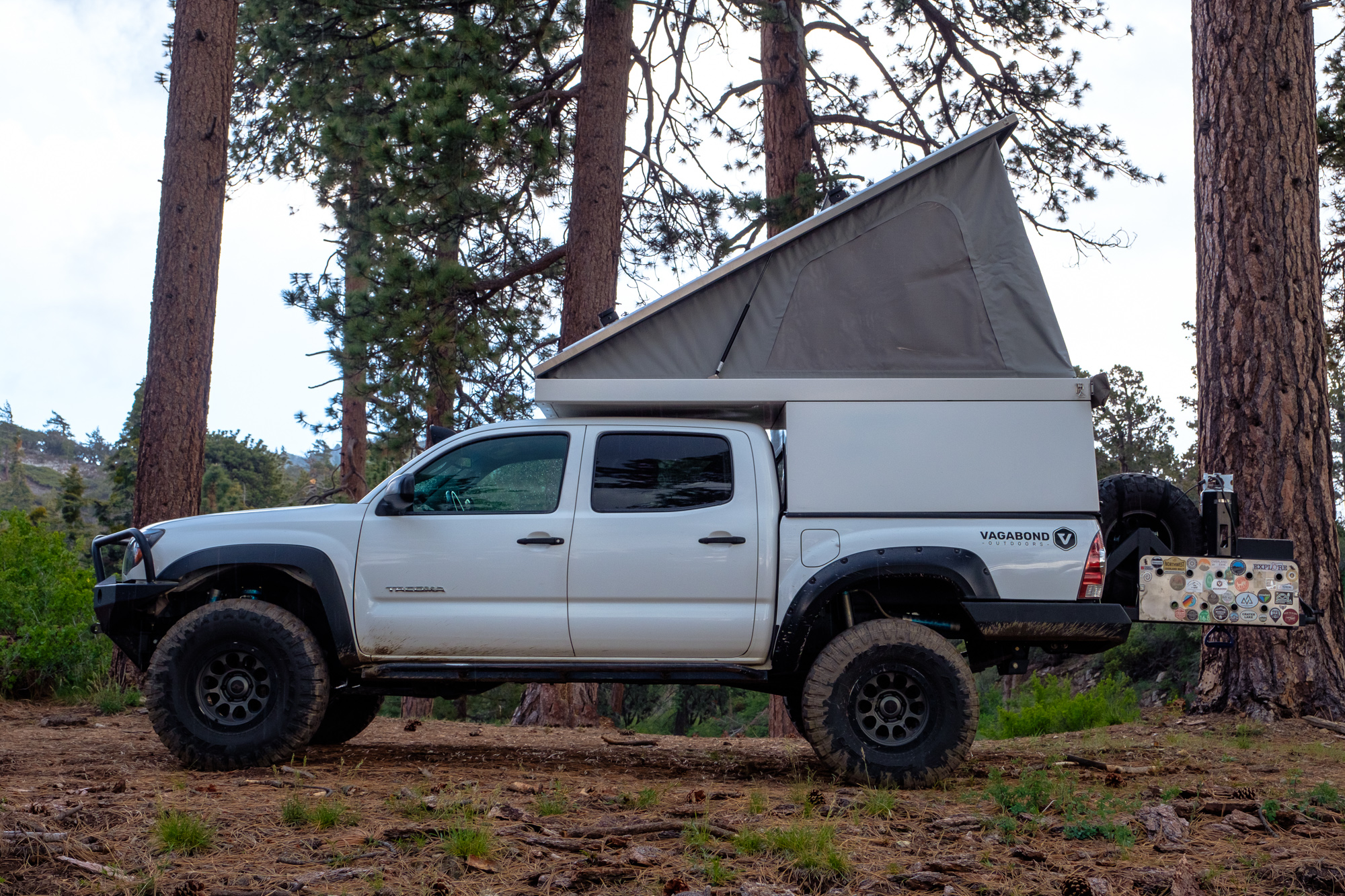
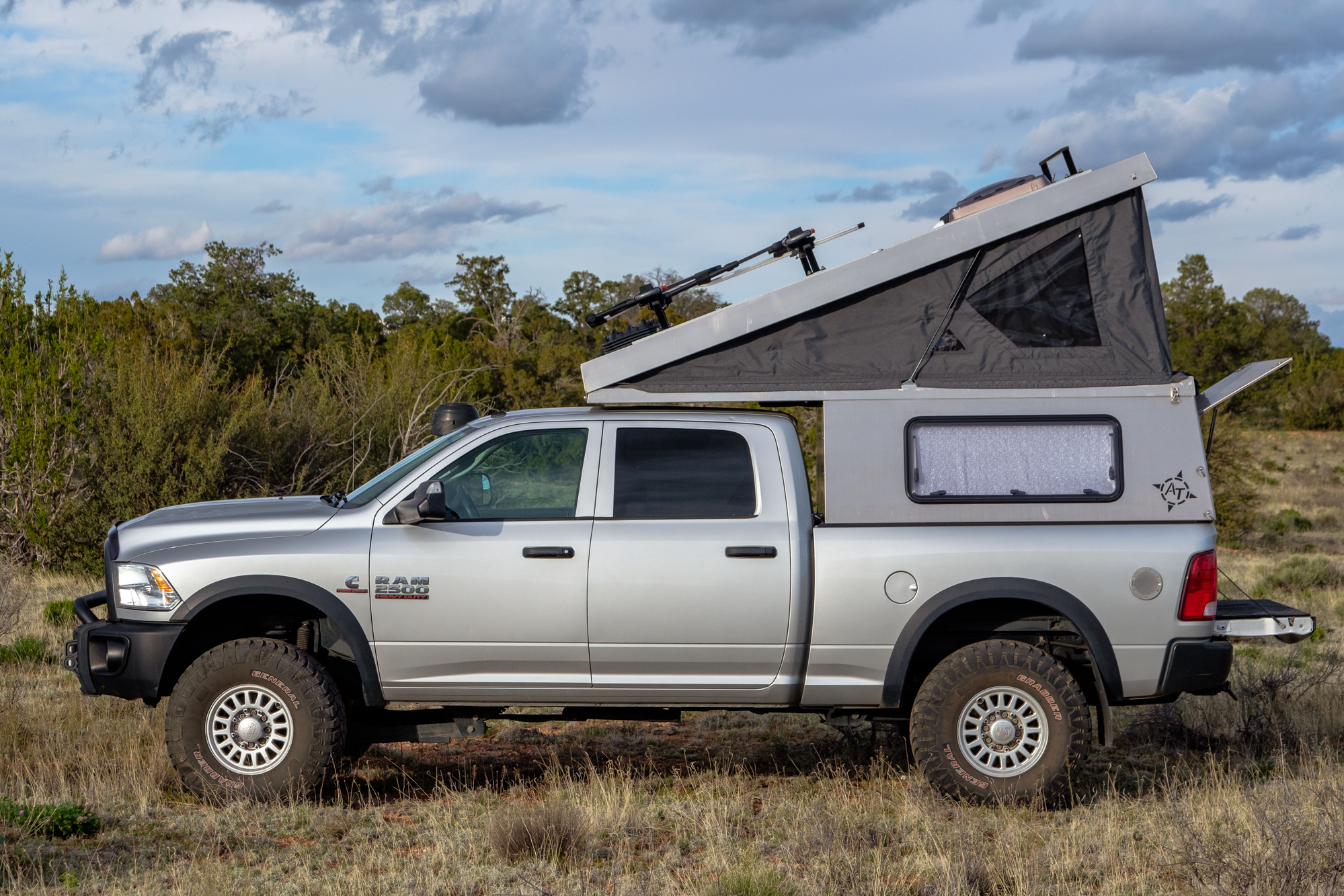
EDITOR’S CHOICE MID-SIZE | AT-OVERLAND
EDITOR’S CHOICE FULL-SIZE | VAGABOND OUTDOORS
The Editor’s Choice was a close battle between the AT Overland Summit and the Vagabond Outdoors Drifter/Nomad. I felt that they were all ideal for full-time travel, with excellent protection against the elements, highly livable interiors, and a list of features that support the needs of daily life. Each holds distinct advantages over the other, yet somehow they manage to balance out so closely that it was practically impossible to choose. In the end, we were splitting hairs. The Summit, for example, has more options, but the Drifter is cheaper. I like the huge windows in the Drifter, but the additional peek holes in the Summit are also fantastic. I felt the Drifter’s interior edges and paneling were finished out better, but the Summit’s carpeted walls and ceiling gave it a very cozy vibe. The gas struts which lift the Summit’s bed are convenient, but the longer bed panel options in the Drifter would be invaluable for taller occupants, and so it goes on and on.
The decision came down to the tents. While both the Drifter’s and Nomad’s are good, the Summit’s tent is superb, especially with the insulation package. That combo transforms the Summit into a true four-season camper where you can kick off your shoes and relax in a T-shirt during a snowstorm as long as you have a heater. Sure, you could do the same in the Vagabond campers, but you’ll be burning considerably more fuel to do so.
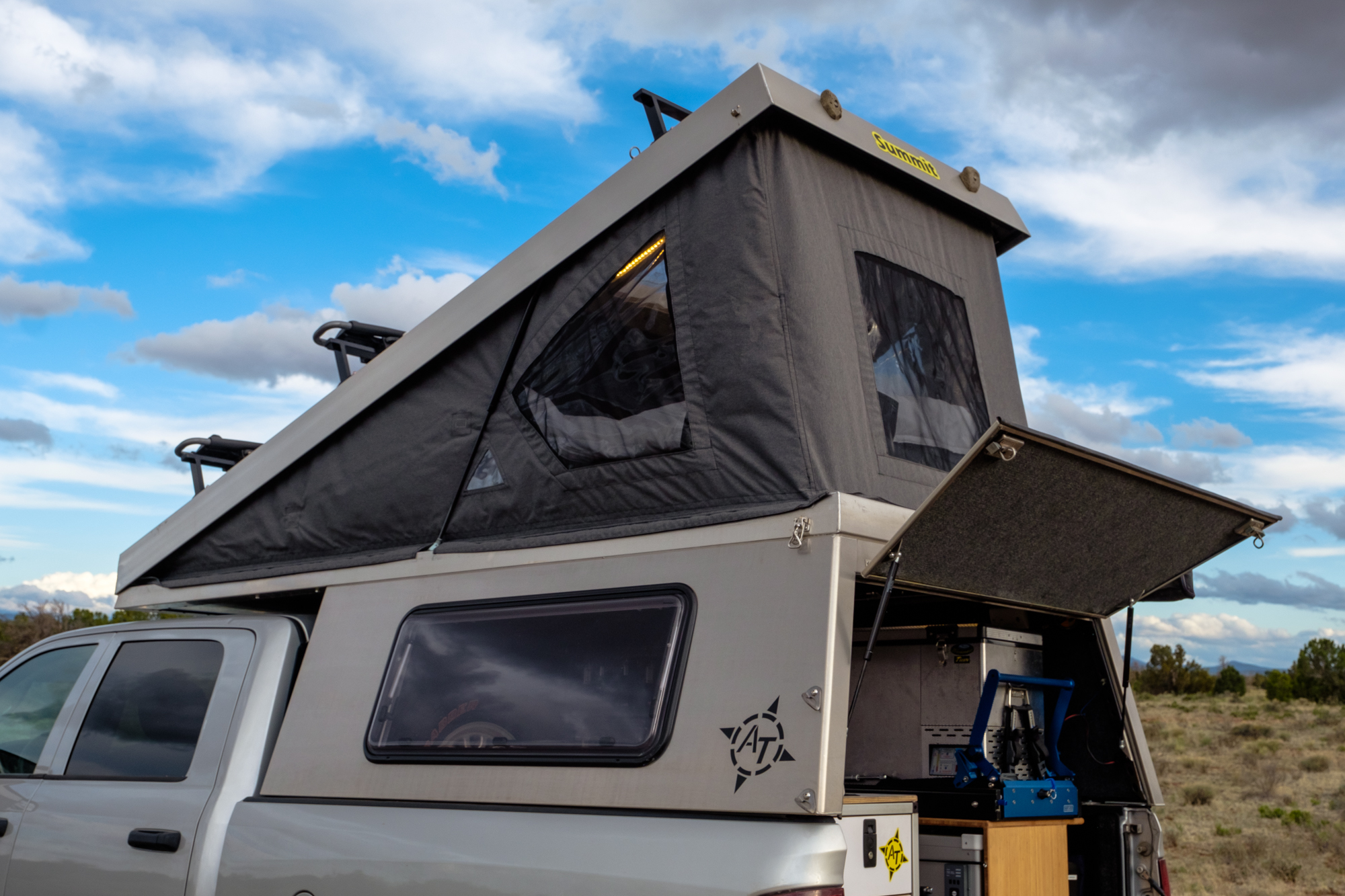
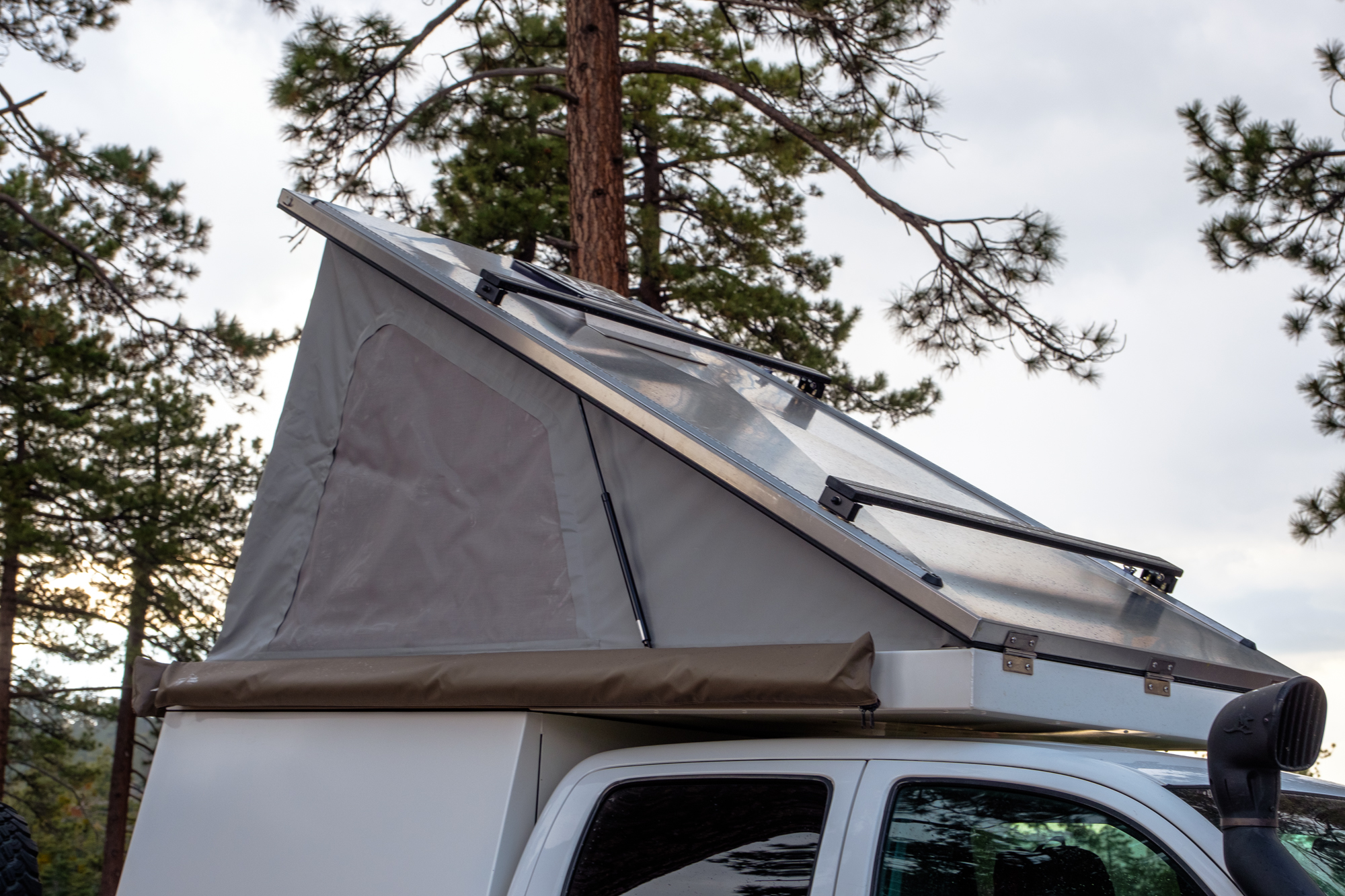
The Summit has a catch though, one which cost it the title for Editor’s Choice, full size: it only comes with a single bed size for both mid- and full-size trucks. As I noted earlier, that means that the camper’s walls must slant in from the truck bed to meet the camper’s roofline. This slant made the seating angle against the wall uncomfortable for extended periods of time, making it difficult to work or relax on the road. Vagabond, on the other hand, increases the Nomad’s bed size from 48 inches to a full 54 inches, widening the roofline and allowing it to retain mostly vertical walls. This also provides 6 additional inches of sleeping width up top, which is nothing to scoff at. After a lot of deliberation, I concluded that if I owned a mid-size truck, I would choose the AT Overland Summit, while if I owned a full-size truck, I would be purchasing a Vagabond Outdoors Nomad.
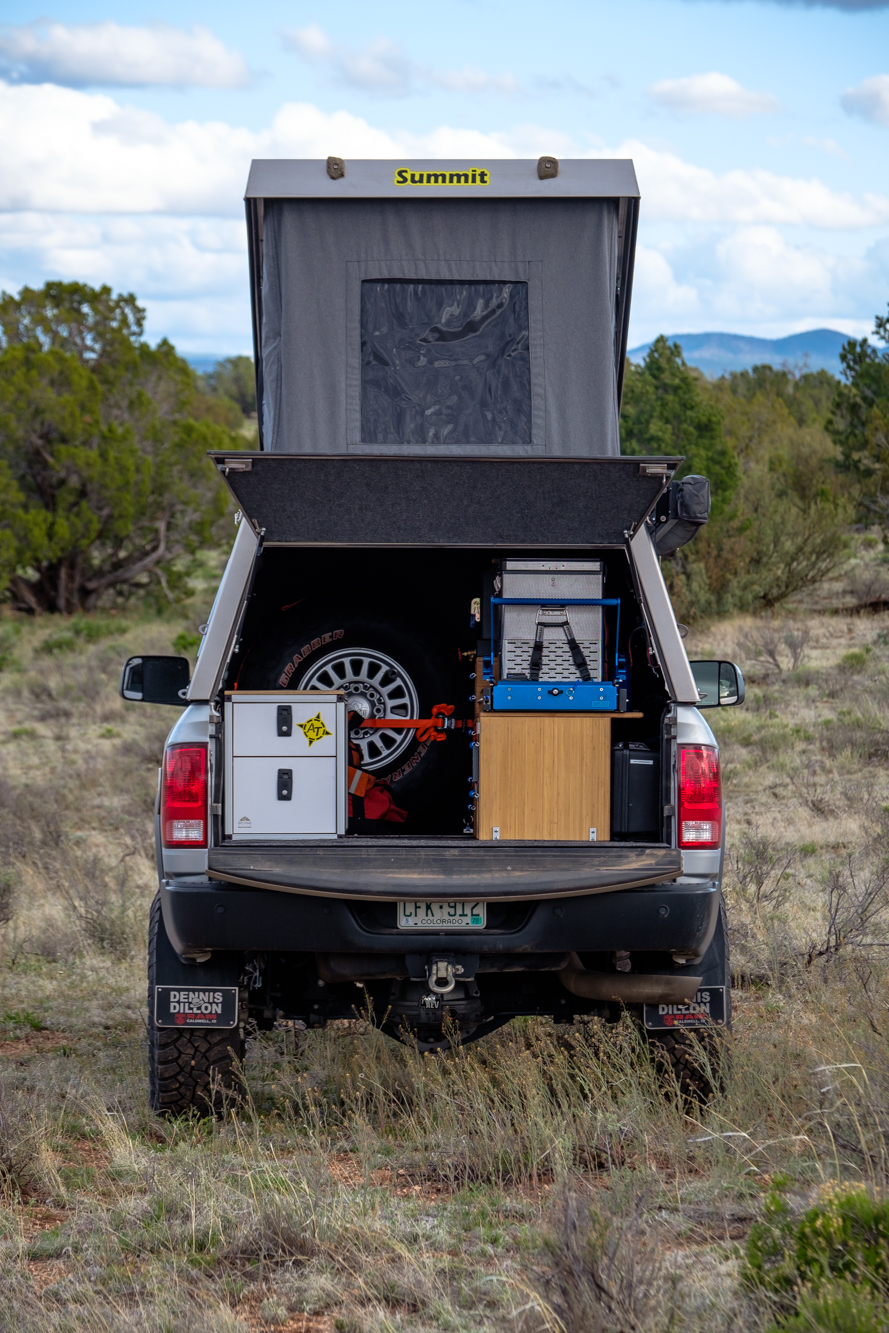

VALUE AWARD | GO FAST CAMPER
Thankfully, the Value Award was more clear cut and went to the Go Fast Camper. No other camper comes close to the base price of $6,450 with similar options. That price buys you a GFC equipped with a lightweight painted shell, a pop-top tent and mattress, lockable, hard-side access panels, and T-slot rails on which to mount accessories or a rack. For another $200 you can add a window to the front or rear of your shell, and for $500 per component group (frame, panels, etcetera) you can customize the colors. Most importantly though, for $350 you get a side access door and window on the tent, which can be paired with a ladder to solve the difficult problem of moving interior panels in and out in the middle of the night. This puts you at $7,700 for a camper customized to match your vehicle and your needs, handily winning this camper the award. I found myself loving the GFC for more than just value though.
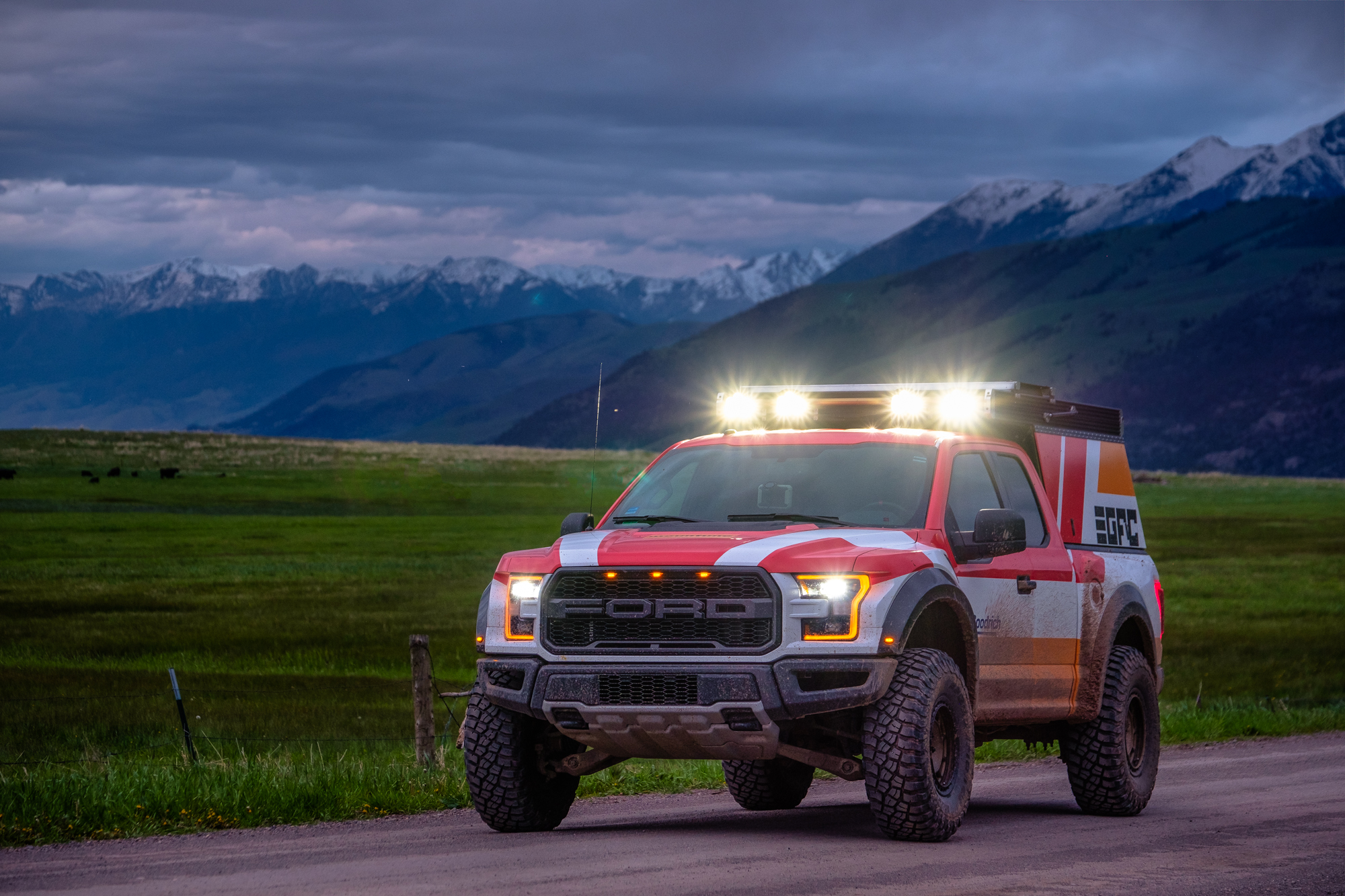

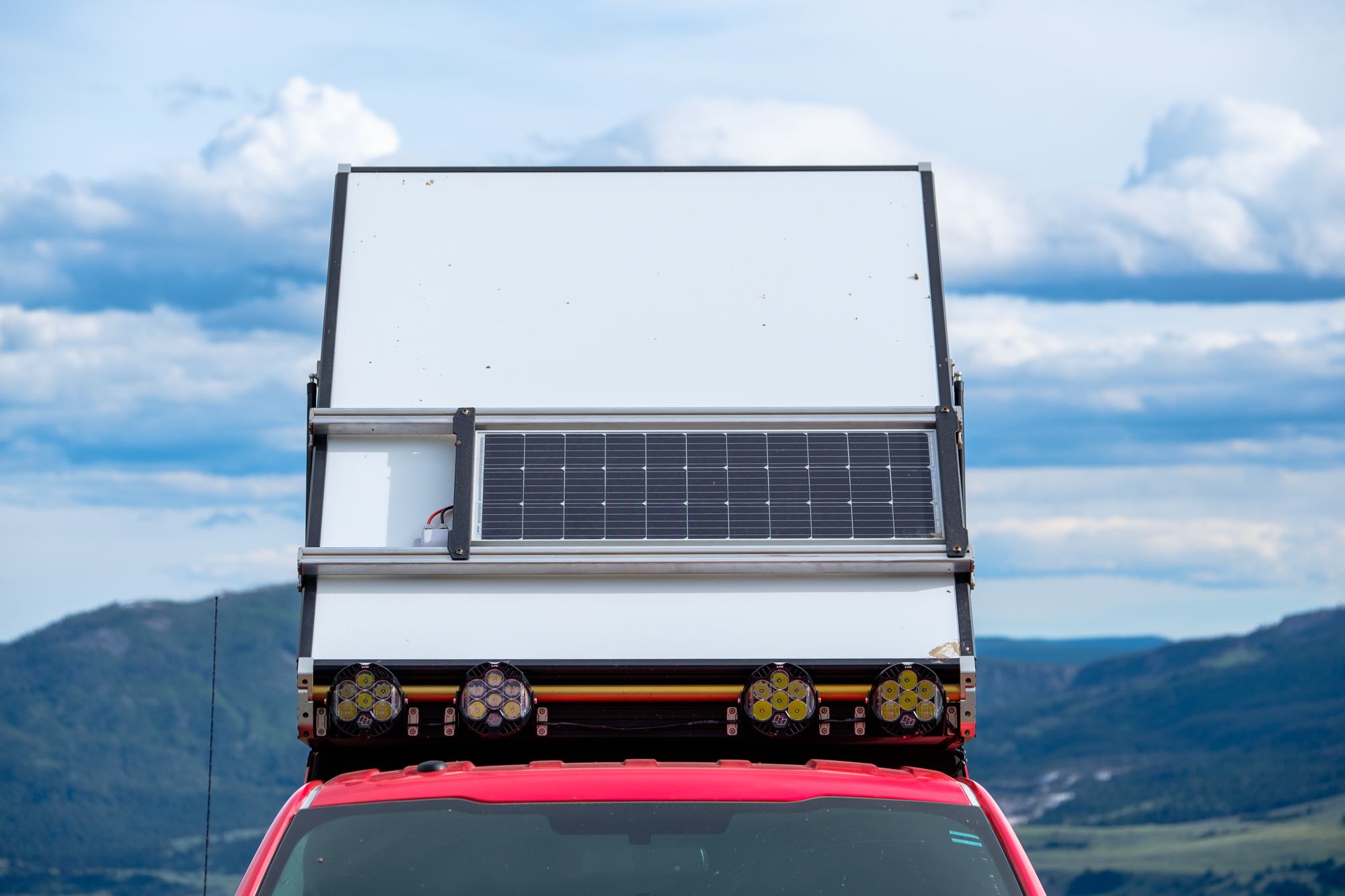
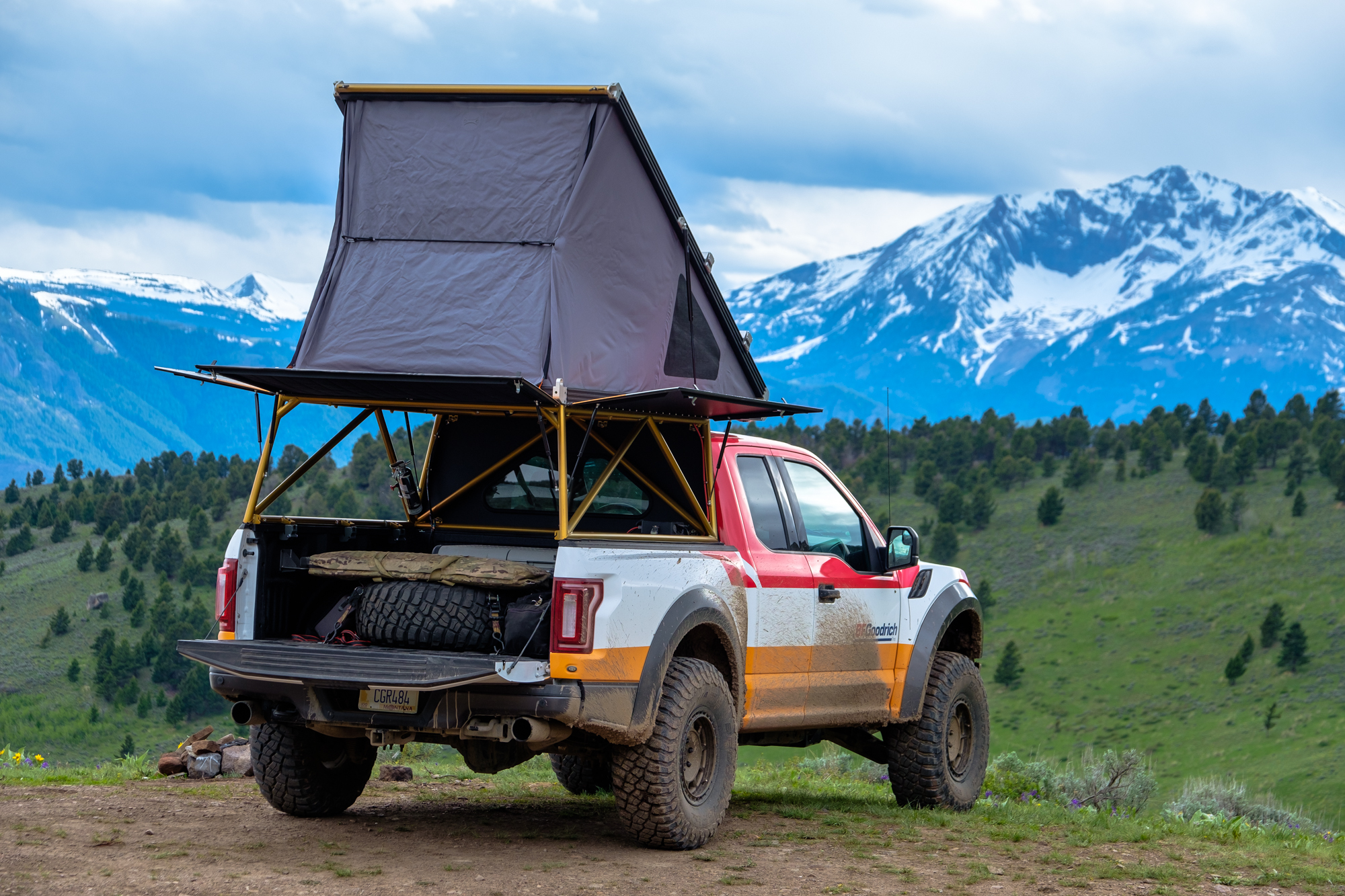
While I don’t think I would select one for full-time living on the road, I have to admit that if I owned a home and were buying one of these campers for weekend trips with the occasional month-long escape, I would probably choose a Go Fast. Don’t get me wrong, the new mattress we tested is still a rock, I don’t love the rain gutter system, and the interior panel design is infuriating at times, but I could look past all of that for what you get in return. It is lighter than the competition which means better payload and handling. The tube frame and billet components are designed to take more of a beating than you can dish out, so you won’t have to worry about things breaking on the trail. A high dynamic roof-load rating and plenty of access to the bed via side hatches means you can still use your truck for hauling lumber, mulch, or shop supplies, when needed, and the lack of a gap for accessing the bed, as much as it bothers me, means you can power wash the interior back to perfection once you’re done. In “cabana” mode the camper turns into an instant gathering point, enabling people to hang out and grab what they need easily, whether you’re at the beach or in the woods. Most importantly though, it can do all of this while costing less than any competing camper, which means you can take that leftover cash and go on a trip, which is the whole point in the first place.
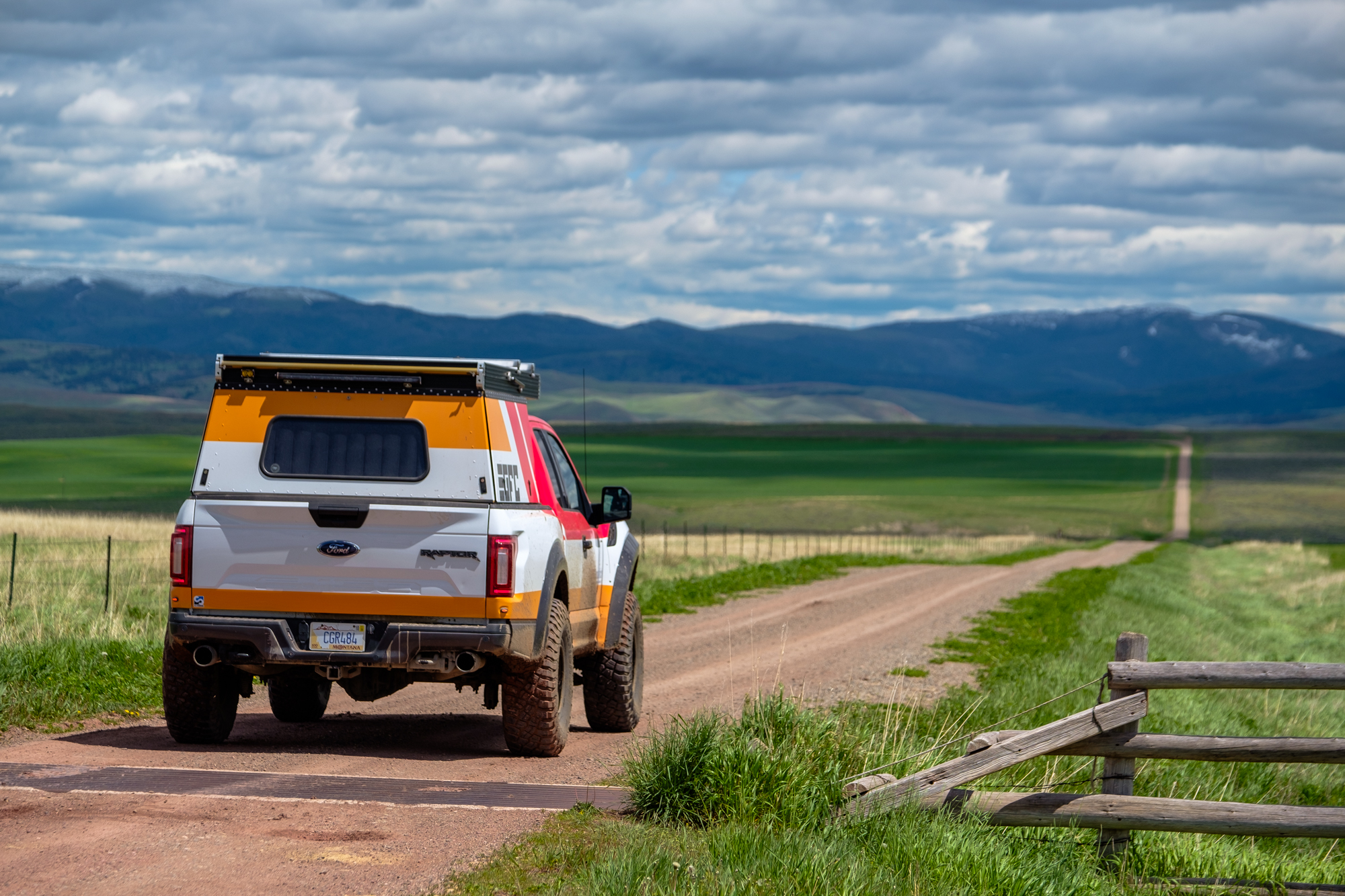
Thankfully, there are no wrong choices here. Beyond the branding and marketing, each of these campers carries strengths and weaknesses which would make them ideal for some situations and inappropriate for others. Like so many decisions in life, this one comes down to the lifestyle you live and the needs that are intertwined with it. Stay true to those needs, and you’ll find that choosing the right camper is practically second nature.
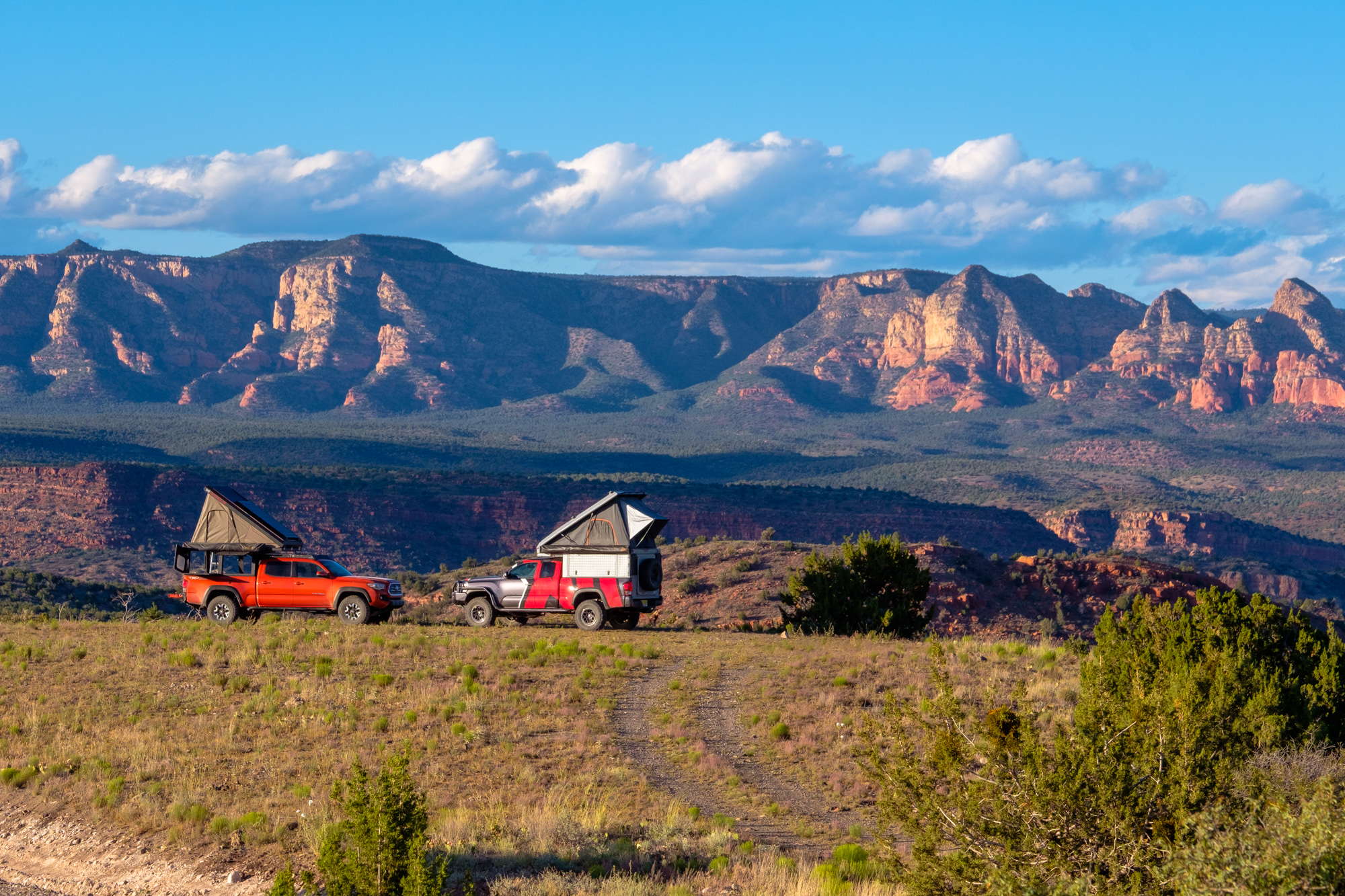
Resources
Fire Retardant information can be found at the following links:
- ncbi.nlm.nih.gov/pmc/articles/PMC3958138/
- rei.com/blog/camp/understanding-flame-retardants-in-camping-and-backpacking-tents
Manufacturer Contact Information
Alu-Cab (OK4WD)
AT Overland
Go Fast Camper
Snap Outfitters
Vagabond Outdoors


